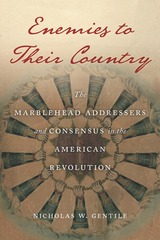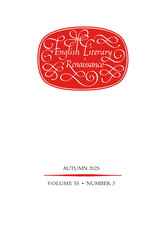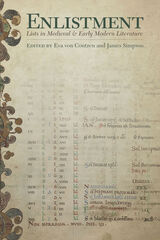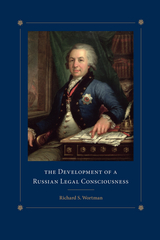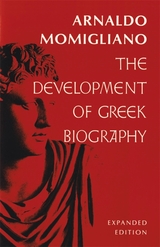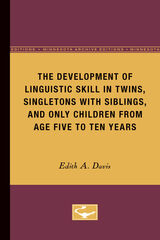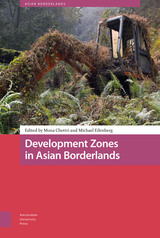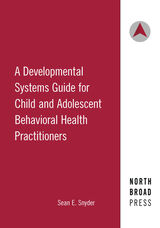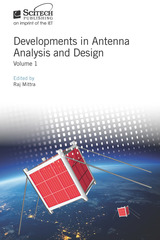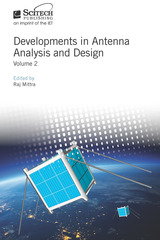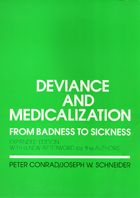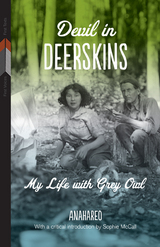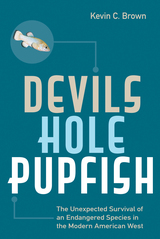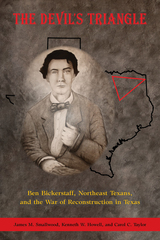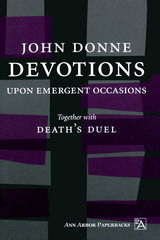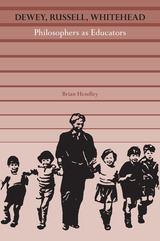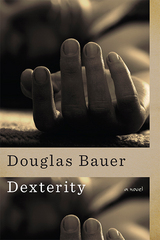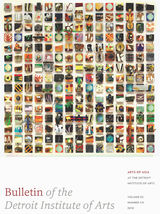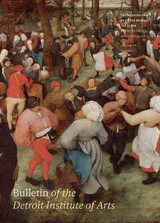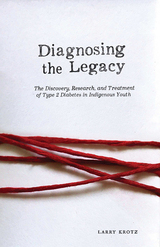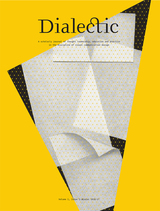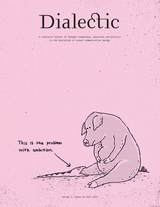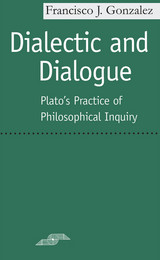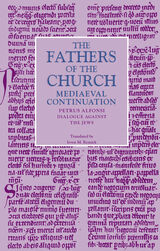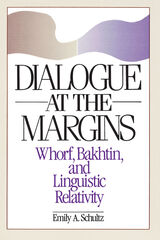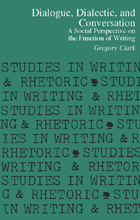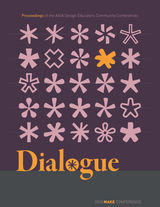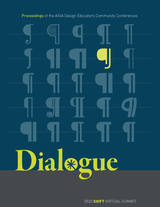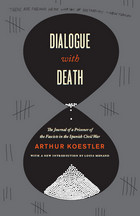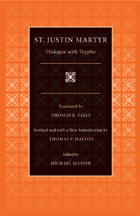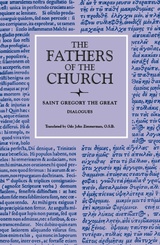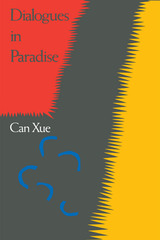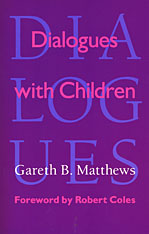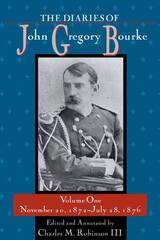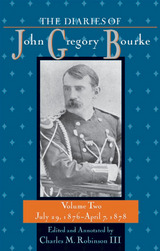The Development of a Russian Legal Consciousness
Richard S. Wortman
University of Chicago Press, 1976 Until the nineteenth century, the Russian legal system was subject to an administrative hierarchy headed by the tsar, and the courts were expected to enforce, not interpret the law. Richard S. Wortman here traces the first professional class of legal experts who emerged during the reign of Nicholas I (1826 – 56) and who began to view the law as a uniquely modern and independent source of authority. Discussing how new legal institutions fit into the traditional system of tsarist rule, Wortman analyzes how conflict arose from the same intellectual processes that produced legal reform. He ultimately demonstrates how the stage was set for later events, as the autocracy and judiciary pursued contradictory—and mutually destructive—goals.
The Development of a Strategy for Integrated Manufacturing Systems
Norman A. Schofield
The Institution of Engineering and Technology, 1990 This Guide is the first produced by The Integrated Manufacturing Systems Working Party of the Institution of Production Engineers. In considering the wide range of issues which arise for any Manufacturing company embarking on the integration of manufacturing systems, the Working Party decided to take a staged approach and this guide represents the first of several on topics relating to Integrated Manufacturing Systems.
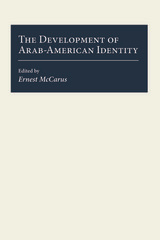 Development of Arab-American Identity
Ernest McCarus, Editor
University of Michigan Press, 1994 By the early twenty-first century, the United States will experience a demographic change as those groups previously thought of as minorities become the majority. Arab-Americans, a fast growning group from Asia and northern Africa, are among those who will soon form part of this new majority. The Development of Arab-American Identity offers an account of the Arab-American experience from the early immigration to the present day.What do Arab-Americans think of traditional American values? How do they perceive their treatment as new immigrants? Have they been seriously alienated from the dominant culture? The Development of Arab-American Identity offers an account of the Arab-American experience from the early immigration to the present day. After the historical background has been set, the essays in this book deal with the struggle for religious, political, cultural, and social identity, all of which involve coping with unconscious and conscious stereotyping and marginalization of Arabs and Arab-Americans.
 The Development of Behavioral States and the Expression of Emotions in Early Infancy: New Proposals for Investigation
Peter H. Wolff
University of Chicago Press, 1987 Peter H. Wolff, a world-renowned authority on infant behavior, helped lay the foundation for the field in the 1960s with his innovative studies of behavioral studies, motor coordination, smiling, and crying in infancy. Some twenty years later, as infancy studies have become increasingly specialized and fragmented, he calls for new theoretical perspectives and methods of investigation. Applying ethological methods used in field studies of animal behavior, Wolff first observes how babies behave in the "natural" ecology of their homes to catalog their species-typical behavioral repertory and then manipulates their behavior through informal experiments designed to examine functional significance.
Wolff argues that a coherent psychobiological theory of early human development must begin with knowledge about the infant's behavioral repertory under free field conditions. Many current theories of human development begin instead with assumptions about the organization of behavior derived from studies of psychological function in the adult; moreover, they appeal to instincts, maturational programs, or genomes to explain the apparent lawfulness in the development of these behavioral categories. Such a priori explanations, Wolff contends, beg the whole question of development. As an alternative to theoretical metaphors that portray the infant as a closed system and suggests that development is controlled by prescient programs that anticipate the mature steady state, Wolff proposes a metaphor of the infant as an open, self-organizing system with partial, mutative mechanisms of development. Applying this metaphor, he addresses the essentially unsolved problem of how novel behavioral forms are induced during ontogenesis.
Wolff presents a study of twenty-two infants who were observed for thirty hours each week in their homes during the first months after birth. He builds a week-by-week description of changes in behavioral states of wakefulness and examines how reversible state changes influence developmental transformations in social-affective behavior and sensori-motor intelligence. The observations and informal experiments emphasize expressions of emotion and the infant's changing relations to persons and things. Pointing out that movements are our only clue to what infants "feel" or "think," Wolff gives special emphasis to the systematic variations in spontaneous and environmentally evoked patterns of motor coordination as a function of behavioral state transitions.
Of great importance to psychologists, psychiatrists, pediatricians, and students of development in general, The Development of Behavioral States and the Expression of Emotions in Early Infancy offers a major empirical, methodological, and theoretical rethinking of the subject to which Wolff has made outstanding contributions.
The Development of Children’s Concepts of Causal Relations
Jean Deutsche
University of Minnesota Press, 1937
The Development of Children’s Concepts of Causal Relations was first published in 1937. Minnesota Archive Editions uses digital technology to make long-unavailable books once again accessible, and are published unaltered from the original University of Minnesota Press editions.This is a report of group tests administered to 732 school children between 8 and 16 years of age, in grades 3 to 8. The children were asked to explain 11 scientific demonstrations, such as putting out a candle with a glass jar, and 12 commonly observed natural phenomena, such as snow and thunder.Quantified scores herein are analyzed in relationship to age, sex, intelligence, school grade, and socio-economic status. The results give insight into children’s logical processes and the development of thinking.
The Development of Cotton Textile Production in China
Kang Chao
Harvard University Press, 1977 This book is the most thorough study yet written on the development of cotton textile production in China. The author has compiled data from a large number of sources in order to explore the origin of cotton textiles in the country and the remarkable expansion of cotton planting and handicraft production after the thirteenth century. He describes institutional and technological progress, the rise of modern mills, the impact on and adjustments of handicraft textiles, and the current situation in China. The book offers important insights into Chinese economic development and the modernization process in general.
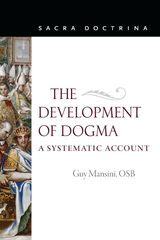 The Development of Dogma: A Systematic Account
Guy Mansini, OSB
Catholic University of America Press, 2023 The Development of Dogma examines the nature of dogmatic statements and the causes of development. It devotes particular attention to the emergence of the form of dogmatic statements at the Council of Nicaea, but notes how this form is anticipated in the New Testament. It situates dogma and its development within the matrix of the great fundamental theological realities of Scripture, Tradition, and Magisterium. Fr. Mansini examines at some length how the Church comes to recognize a development as a genuine development rather than as a distortion of the word of God. The Development of Dogma is especially valuable today for its discussion and defense of the philosophical presuppositions of dogma, which are often simply presupposed but should not be ignored in a complete account of development. These presuppositions touch on fundamental philosophical issues, including the nature of knowledge, the objectivity and trustworthiness of names, and the various logical forms employed in understanding how development is related to a closed revelation. The historicity of human knowledge is also addressed, and the role of dogma itself in heading off the extreme relativism the historical nature of man is supposed to imply for ecclesial faith and life. The Church's dogma about dogma enunciated at the First Vatican Council is also examined. The role of certain fundamental concepts in understanding the possibility of the irreformability of dogma it speaks of is expressly addressed—concepts in principle accessible to all human beings and that enable a trans-cultural, trans-temporal proposal and reception of revealed truth.
 The Development of Florentine Humanist Historiography in the Fifteenth Century
Donald J. Wilcox
Harvard University Press, 1969 Presenting a new interpretation of humanist historiography, Donald J. Wilcox traces the development of the art of historical writing among Florentine humanists in the fifteenth century. He focuses on the three chancellor historians of that century who wrote histories of Florence—Leonardo Bruni, Poggio Bracciolini, and Bartolommeo della Scala—and proposes that these men, especially Bruni, had a new concept of historical reality and introduced a new style of writing to history. But, he declares, their great contributions to the development of historiography have not been recognized because scholars have adhered to their own historical ideals in judging the humanists rather than assessing them in the context of their own century.
Mr. Wilcox introduces his study with a brief description of the historians and historical writing in Renaissance Florence. He then outlines the development of the scholarly treatment of humanist historiography and establishes the need for a more balanced interpretation. He suggests that both Hans Baron’s conception of civic humanism and Paul Oscar Kristeller’s emphasis on the rhetorical character of humanism were important developments in the general intellectual history of the Renaissance and, more specifically, that they provided a new perspective on the entire question of humanist historiography.
The heart of the book is a close textual analysis of the works of each of the three historians. The author approaches their texts in terms of their own concerns and questions, examining three basic elements of their art. The first is the nature of the reality the historian is recounting. Mr. Wilcox asks, “What interests the writer? What is the substance of his narrative?… What does he choose from his sources…and what does he ignore? What does he interpolate into the account by drawing on his own understanding of the nature of history?” The second is the various attitudes—moral judgments, historical conceptions, analytical views—with which the historian approaches his narrative. And the third is the aspect of humanist historiography to which previous scholars have paid the least attention: the historian’s narrative technique. Mr. Wilcox identifies the difficulties involved in expressing historical ideas in narrative form and describes the means the historians developed for overcoming those difficulties. He emphasizes the positive value of rhetoric in their works and points out that they “sought by eloquence to teach men virtue.”
He devotes three chapters to Bruni, whom he considers the most original and important of the three historians. The next two chapters deal with Poggio, and the last with Scala. Throughout the book Mr. Wilcox exposes the internal connections among the three histories, thus illustrating the basic coherence of the humanist historical art.
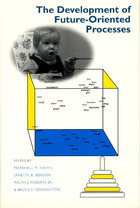 The Development of Future-Oriented Processes
Edited by Marshall M. Haith, Janette B. Benson, Ralph J. Roberts Jr., and Bruce
University of Chicago Press, 1994 How do children develop an understanding of future events? In this state of the art review of two decades of empirical and theoretical work, leading researchers in developmental psychology and neuroscience explore what is known about the development of future-oriented processes.
Following Marshall Haith's seminal studies on early infant anticipation, this collection begins with a survey of current knowledge about the early development of expectations. Addressing both the state of neural research in this field and the role of language and social context in the development of future orientation, the authors discuss the nature of planning in action, future orientation in humans and in nonhuman primates, and the development of intermediate and long-term expectations with regard to cognitive skills and scientific activity.
Combining developmental and cognitive perspectives, this volume will interest professionals in developmental psychology, child development, and neuropsychology.
The Development of Greek Biography: Expanded Edition
Arnaldo Momigliano
Harvard University Press, 1993 Tracing the growth of ancient biography from the fifth century to the first century B.C., Arnaldo Momigliano asks fruitful questions about the origins and development of Greek biography. By clarifying the social and intellectual implications of the fact that the Greeks kept biography and autobiography distinct from historiography, he contributes to an understanding of a basic dichotomy in the Western tradition of historical writing. The Development of Greek Biography is fully annotated, and includes a bibliography designed to serve as an introduction to the study of biography in general.
This classic study is now reissued with the addition of Momigliano’s essay “Second Thoughts on Greek Biography” (1971).
 The Development of Harvard University since the Inauguration of President Eliot, 1869–1929
Samuel Eliot Morison
Harvard University Press For the observance of the three-hundredth anniversary of its founding, the University prepared a four-volume history of Harvard, the first volume of which is here. It is made up of thirty-nine chapters, each setting forth the history of a single department within the last three or four decades and its present organization. Among the writers of the various articles are George Herbert Palmer, Ralph Barton Perry, Charles Hall Grandgent, Frank W. Taussig, William W. Fenn, Roscoe Pound, and Wallace B. Donham. There are, in addition, chapters on the government and administration of the University, the system of instruction and the general arrangement of finances, the religious life of the University, and the inaugural addresses of Presidents Eliot and Lowell. The book has importance far beyond the circle of Harvard men: its special appeal will naturally be to historians and educators, but even the general reader will find in its pages an unrivalled view of contemporary American intellectual effort, illuminated by the personality of men actively engaged in widening the bounds of human knowledge.
The Development of Late Phoenician Scripts
J. Brian S.J.Peckham
Harvard University Press This monograph is a systematic paleographical analysis that traces the typographical development of the Phoenician and Punic scripts from the eighth to the first century B.C. (Neopunic scripts are also discussed but mainly as a lower limit to the development of Punic.) From his intensive examination of the complicated historical data, the author is able to fix absolute dates for several major sequences of inscriptions (from Cyprus, Byblos, Tyre, and Sidon) and then establish a general typographical framework for undated inscriptions, including the corpus of Punic texts. Seventeen plates are provided for comparison with the descriptive material.
The Development of Linguistic Skill in Twins, Singletons with Siblings, and Only Children from Age Five to Ten Years
Edith Davis
University of Minnesota Press, 1937
The Development of Linguistic Skill in Twins, Singletons with Siblings, and Only Children from Age Five to Ten Years was first published in 1937.This book constitutes a detailed analysis of 50 remarks obtained under a standardized situation from each of 436 children between the ages of 5 1/2 and 9 1/2 years.The investigation in no sense duplicates former ones. It deals with children of school age and consequently emphasizes such phases of language development as the use of complex sentences and slang and grammatical errors. The connection between good articulation and the development of language ability is stressed.
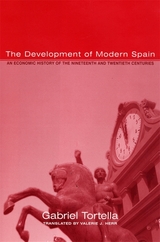 The Development of Modern Spain: An Economic History of the Nineteenth and Twentieth Centuries
Gabriel Tortella
Harvard University Press, 2000 This reinterpretation of the history of modern Spain from the Enlightenment to the threshold of the twenty-first century explains the surprising changes that took Spain from a backward and impoverished nation, with decades of stagnation, civil disorder, and military rule, to one of the ten most developed economies in the world. The culmination of twenty years' work by the dean of economic history in Spain, founder of the Revista de Historia Económica and recipient of the Premio Rey Juan Carlos, Spain's highest honor for an academic, the book is rigorously analytical and quantitative, but eminently accessible. It reveals views and approaches little explored until now, showing how the main stages of Spanish political history have been largely determined by economic developments and by a seldom mentioned factor: human capital formation. It is comparative throughout, and concludes by applying the lessons of Spanish history to the plight of today's developing nations.
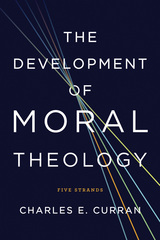 The Development of Moral Theology: Five Strands
Charles E. Curran
Georgetown University Press, 2016 Charles Curran in his newest book The Development of Moral Theology: Five Strands, brings a unique historical and critical analysis to the five strands that differentiate Catholic moral theology from other approaches to Christian ethics—sin and the manuals of moral theology, the teaching of Thomas Aquinas and later Thomists, natural law, the role of authoritative church teaching in moral areas, and Vatican II. Significant changes have occurred over the course of these historical developments. In addition, pluralism and diversity exist even today, as illustrated, for example, in the theory of natural law proposed by Cardinal Ratzinger. In light of these realities, Curran proposes his understanding of how the strands should influence moral theology today. A concluding chapter highlights the need for a truly theological approach and calls for a significant change in the way that the papal teaching office functions today and its understanding of natural law. In a work useful to anyone who studies Catholic moral theology, The Development of Moral Theology underscores, in the light of the historical development of these strands, the importance of a truly theological and critical approach to moral theology that has significant ramifications for the life of the Catholic church.
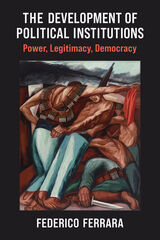 The Development of Political Institutions: Power, Legitimacy, Democracy
Federico Ferrara
University of Michigan Press, 2022 While the literature on “new institutionalism” explains the stability of institutional arrangements within countries and the divergence of paths of institutional development between countries, Federico Ferrara takes a “historical institutionalist” approach to theorize dynamic processes of institutional reproduction, institutional decay, and institutional change in explaining the development of political institutions. Ferrara synthesizes “power-based” or “power-distributional” explanations and “ideas-based” “legitimation explanations.” He specifies the psychological “microfoundations” of processes of institutional development, drawing heavily from the findings of experimental psychology to ensure that the explanation is grounded in clear and realistic assumptions regarding human motivation, cognition, and behavior. Aside from being of interest to scholars and graduate students in political science and other social-scientific disciplines whose research concentrates on the genesis of political institutions, their evolution over time, and their impact on the stability of political order and the quality of governance, the book will be required reading in graduate courses and seminars in comparative politics where the study of institutions and their development ranks among the subfield’s most important subjects.
 The Development of Reasoning in Children with Normal and Defective Hearing
Mildred Templin
University of Minnesota Press, 1950
The Development of Reasoning in Children with Normal and Defective Hearing was first published in 1950. Minnesota Archive Editions uses digital technology to make long-unavailable books once again accessible, and are published unaltered from the original University of Minnesota Press editions.No. 24, Institute of Child Welfare Monograph SeriesThis important study will prove helpful to educators, psychologists, clinicians, and all workers with the hard-of-hearing and deaf. Various types of reasoning ability were measured in children whose experience was limited by defective hearing, by residence in an institution, or by both of these factors, and comparisons were made with children whose environment was normal in one or both aspects.Subjects for the study included 850 pupils in state schools for the deaf, in special day classes for the defective hearing, and in public schools. Three different reasoning tests were used, and the scores of matched groups are compared and analyzed.
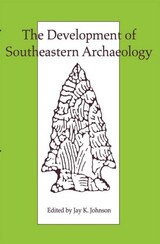 The Development of Southeastern Archaeology
Edited by Jay K. Johnson
University of Alabama Press, 1993 Ten scholars whose specialties range from ethnohistory to remote sensing and lithic analysis to bioarchaeology chronicle changes in the way prehistory in the Southeast has been studied since the 19th century. Each brings to the task the particular perspective of his or her own subdiscipline in this multifaceted overview of the history of archaeology in a region that has had an important but variable role in the overall development of North American archaeology.
Some of the specialties discussed in this book were traditionally relegated to appendixes or ignored completely in site reports more than 20 years old. Today, most are integral parts of such reports, but this integration has been hard won. Other specialties have been and will continue to be of central concern to archaeologists. Each chapter details the way changes in method can be related to changes in theory by reviewing major landmarks in the literature. As a consequence, the reader can compare the development of each subdiscipline.
As the first book of this kind to deal specifically with the region, it be will valuable to archaeologists everywhere. The general reader will find the book of interest because the development of southeastern archaeology reflects trends in the development of social science as a whole.
Contributors include:
Jay K. Johnson, David S. Brose, Jon L. Gibson, Maria O. Smith, Patricia K. Galloway, Elizabeth J. Reitz, Kristen J. Gremillion, Ronald L. Bishop, Veletta Canouts, and W. Fredrick Limp
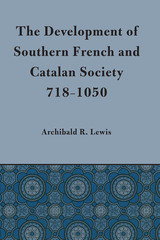 Development of Southern French and Catalan Society, 718-1050
By Archibald R. Lewis
University of Texas Press, 1965 Early in the eighth century, the current of the Muslim movement that inundated northern Spain crept over the Pyrenees to spread across a portion of the French Midi. From the north the tide of Carolingian conquest forced the Muslims back and took in these same southern French and northern Spanish provinces. During the same era the Vikings raided intermittently and with varying degrees of intensity along the seacoasts and up the inland waterways, sometimes controlling considerable areas for extended periods. These raids and conquests inevitably affected the way of life of the people of southern France and Catalonia. Contemporary travelers and later scholars have noted that the feudal traditions and obligations that were so strong in the north seemed very weak or nonexistent in the south. They found that the land seemed to be held largely as allods, not as feudal fiefs; they saw that women held positions of surprising power, that throughout the area there was great emphasis on money, and that the traditions of Roman and Visigothic law still survived. Although scholars have noted these differences, no one has made a comprehensive study of southern French and Catalan society as a whole. It is to fill this void that Archibald Lewis provides this volume. In a detailed and scholarly study, based largely upon original records and chronicles, he examines the familial, social, economic, governmental, military, and religious life of the area from 718 to 1050 A.D. Lewis gives as comprehensive a picture as the records will permit of the society that existed in the early eighth century, describes and discusses the major changes which took place during the next three centuries, and analyzes their causes and effects. This study, which includes careful and detailed notes and an extensive bibliography, provides a reliable and long-needed reference tool.
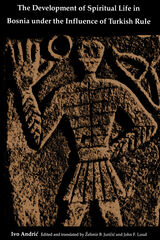 The Development of Spiritual Life in Bosnia under the Influence of Turkish Rule
Ivo Andric
Duke University Press, 1990 Ivo Andric (1892-1975), Nobel Prize laureate for literature in 1961, is undoubtedly the most popular of all contemporary Yugoslav writers. Over the span of fifty-two years some 267 of his works have been published in thirty-three languages. Andric’s doctoral dissertation, The Development of Spiritual Life in Bosnia under the Influence of Turkish Rule (1924), never before translated into English, sheds important light on the author’s literary writings and must be taken into account in any current critical analysis of his work.
Over his long and distinguished career as a diplomat and man of letters Andric never again so directly or discursively addressed, as a social historian, the impact of Turkish hegemony on the Bosnian people (1463–1878), a theme he returns to again and again in his novels. Although Andric’s fiction was embedded in history, scholars know very little of his actual readings in history and have no other comparable treatment of it from his own pen. This dissertation abounds with topics that Andric incorporated into his early stories and later novels, including a focus on the moral stresses and compromises within Bosnia’s four religious confessions: Catholic, Orthodox, Jew, and Muslim.
Z. B. Juricic provides an extensive introduction describing the circumstances under which this work was written and situating it in Andric’s oeuvre. John F. Loud’s original bibliography drawn from this dissertation stands as the only comprehensive inventory of historical sources known to have been closely familiar to the author at this early stage in his development.
The Development of the Business Corporation in England, 1800-1867
Bishop Carleton Hunt
Harvard University Press Formation of a joint-stock company with limited liability by the now familiar process of registration under general statutes had been forbidden in England by the Bubble Act of 1720; later it was a carefully guarded bureaucratic concession; and only after the middle of the nineteenth century did it become a matter of general right. The course of the change in public opinion and in law is described by Dr. Hunt in a way that throws new light upon the history of English industry and commerce. For a complete understanding of this important period in English business history one should follow his account of the protracted struggle to secure genuine freedom of incorporation. His broad treatment of a problem that might seem narrow and technical will thus be of value to all who are interested in the structure of business.
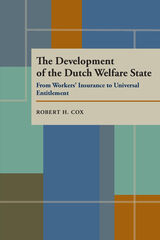 The Development of the Dutch Welfare State: From Workers' Insurance to Universal Entitlement
Robert H. Cox
University of Pittsburgh Press, 1993
The development of the Dutch welfare state in the Netherlands started later than in other Western European countries, but once it started, it grew at a spectacular rate. The development was so rapid that it catapulted the Dutch from being welfare laggards to being welfare leaders. Cox charts the course of this growth, from the nineteenth century to the present, placing the Dutch case within the larger theoretical discussion of welfare states.
In so doing, Cox challenges the widely held assumption that welfare programs always represent the policies of the social democratic left. He demonstrates that it was not the left but the more centrist religious parties that built the Dutch welfare state in the 1960s. Even more curious is the fact that these same political forces had resisted the expansion of welfare programs throughout the first half of the twentieth century.
In many ways, the Netherlands is a crucial test case for assumptions about the welfare state. Its system is one of the largest in the world, rivaling Sweden's as one that devotes the greatest share of public spending to social welfare. How does it compare to other countries? Do present theories of welfare state development fit the Dutch case? What can we learn from the experience of a small state?
Cox makes a signal contribution in clarifying the historical record concerning a little-studied country and in advancing theoretical debate.
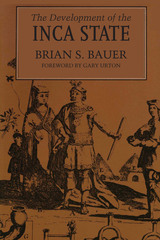 The Development of the Inca State
By Brian S. Bauer
University of Texas Press, 1992 The Inca empire was the largest state in the Americas at the time of the Spanish invasion in 1532. From its political center in the Cuzco Valley, it controlled much of the area included in the modern nations of Ecuador, Peru, Chile, and Bolivia. But how the Inca state became a major pan-Andean power is less certain. In this innovative work, Brian S. Bauer challenges traditional views of Inca state development and offers a new interpretation supported by archaeological, historical, and ethnographic evidence. Spanish chroniclers of the sixteenth and seventeenth centuries attributed the rapid rise of Inca power to a decisive military victory over the Chanca, their traditional rivals, by Pachacuti Inca Yupanqui. By contrast, Bauer questions the usefulness of literal interpretations of the Spanish chronicles and provides instead a regional perspective on the question of state development. He suggests that incipient state growth in the Cuzco region was marked by the gradual consolidation and centralization of political authority in Cuzco, rather than resulting from a single military victory. Synthesizing regional surveys with excavation, historic, and ethnographic data, and investigating broad categories of social and economic organization, he shifts the focus away from legendary accounts and analyzes more general processes of political, economic, and social change.
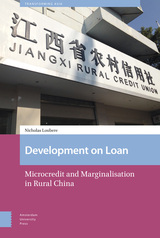 Development on Loan: Microcredit and Marginalisation in Rural China
Nicholas Loubere
Amsterdam University Press, 2020 Key to China's plans to promote rural development is the de-marginalisation of the countryside through the incorporation of rural areas into the urban-based market-oriented financial system. For this reason, Chinese development planners have turned to microcredit -- i.e. the provision of small-scale loans to 'financially excluded' rural households -- as a means of increasing 'financial consciousness' and facilitating rural de-marginalisation. Drawing on in-depth fieldwork in rural China, this book examines the formulation, implementation and outcomes of government-run microcredit programmes in China, illuminating the diverse roles that microcredit plays in local processes of socioeconomic development and the livelihoods of local actors. It details how microcredit facilitates de-marginalisation for some, while simultaneously exacerbating the marginalisation of others; and exposes the ways in which microcredit and other top-down development strategies reflect and reinforce the contradictions and paradoxes implicit in rural China's contemporary development landscape.
 Development Policy
Edited by Walter P. Falcon and Gustav F. Papanek
Harvard University Press, 1971 The contributors draw on their extensive experience as advisers to the Pakistan Planning Commission. Walter Falcon and Joseph J. Stern provide a general summary of Pakistan's development. The well-documented volume then focuses on specific economic issues. Stern analyzes inter-regional income differences and the trade-off between growth and regional equity. G. C. Hufbauer discusses West Pakistan's rapidly increasing exports, as well as effective subsidies and taxation, costs, and discrimination among exports. Henry D. Jacoby examines the application of a model to the planning of a whole power system. Robert Repetto is concerned with costs involved in designing an irrigation system. Falcon and Carl H. Gotsch study Punjab agriculture, the rationality of Punjabi farmers and their responses to prices and technological change. John W. Thomas provides important empirical evidence on a program to provide employment: the rural public works of East Pakistan. Gustav Papanek, former Director of the Development Advisory Service, discusses the occupational background and financing of Pakistan's industrial entrepreneurs and the relationship between their education and their success.
Development Policy
Gustav F. Papanek
Harvard University Press This is the first volume in a series sponsored by the Development Advisory Service of Harvard University to make generally available the findings of their advisors throughout the world. The thirteen contributors to this book participated in the work of the government agencies of Pakistan, Liberia, Argentina, and Colombia concerned with economic planning and policy. They thus had a rare opportunity to formulate significant generalizations about the development process, which they document here, while presenting analyses of the specific problems they encountered.
 Development Prospects in Cuba: An Agenda in the Making
Edited by Pedro Monreal
University of London Press, 2002 The 1990s witnessed significant changes in the Cuban economy. The first half of the decade focused on obtaining the adjustments necessary to enable the country to overcome the profound economic crisis that had befallen it. The second half was characterized by the reality and possibilities of economic recovery. This volume may be the first academic text specifically written to assess the development perspectives of Cuba in the new conditions that prevail. The overarching question is "What comes after recovery?" The authors deal with questions of immediate relevance to the Cuban economy and its recent past, with emphasis placed on the implications for long-term prospects for development. This reflects the conviction that solutions to the challenge of development will require longer periods of analysis and different areas of focus than those which have served as the temporal and conceptual references for recent studies of the island's economy.
Contributors include Julio Carranza, Anicia Garcia, Hiram Marquetti, Lazaro Pena, Omar Everleny Perez, and Julio Diaz Vazquez (University of Havana, Cuba), Claes Brundenius (Centre for Development Research, Copenhagen, Denmark), David Dapice (Tufts University and Harvard University, USA), Francisco Leon (United Nations Economic Commission for Latin America and the Caribbean), and Mauricio de Miranda (Pontificia Universidad Javeriana, Colombia).
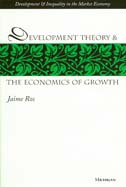 Development Theory and the Economics of Growth
Jaime Ros
University of Michigan Press, 2000 Why are some countries richer than others? Why do some economies grow so much faster than others do? Do economies tend to converge at similar levels of per capita income? Or is catching up simply impossible? These questions have vast implications for human welfare. After a period of lack of interest in growth theory, they are back on the research agenda of mainstream economics. They have also been at the heart of development economics since its inception some decades ago. This book endeavors to answer such questions by blending classical contributions to development theory with recent developments in the economics of growth.
The unifying theme is that early theoretical insights and accumulated empirical knowledge of development economics have much to offer to research in the theory and empirics of economic growth. With the help of a number of recent contributions, the ideas and insights of the classical literature in development economics can be given simple and rigorous formulations. Together, they amount to an approach to growth theory that can overcome the long-recognized empirical shortcomings of neoclassical growth economics, while being free from the objections that can be raised against the new brand of endogenous growth theory.
In addition to an original thesis on the contribution that early development theory can make to the research program of modern growth economics, the book provides professional and research economists and graduate students with an evaluation of the strengths and limitations of the different strands of inquiry in the modern economics of growth. In addition it presents findings on comparative growth performance across countries.
Jaime Ros is Professor of Economics and Faculty Fellow of the Helen Kellogg Institute of International Studies, University of Notre Dame.
Development Zones in Asian Borderlands
Mona Chettri
Amsterdam University Press, 2021 Development Zones in Asian Borderlands maps the nexus between global capital flows, national economic policies, infrastructural connectivity, migration, and aspirations for modernity in the borderlands of South and South-East Asia. In doing so, it demonstrates how these are transforming borderlands from remote, peripheral backyards to front-yards of economic development and state-building. Development zones encapsulate the networks, institutions, politics and processes specific to enclave development, and offer a new analytical framework for thinking about borderlands; namely, as sites of capital accumulation, territorialisation and socio-spatial changes.
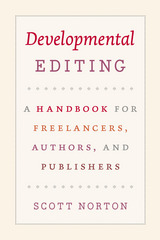 Developmental Editing: A Handbook for Freelancers, Authors, and Publishers
Scott Norton
University of Chicago Press, 2009
Editing is a tricky business. It requires analytical flair and creative panache, the patience of a saint and the vision of a writer. Transforming a manuscript into a book that edifies, inspires, and sells? That’s the job of the developmental editor, whose desk is the first stop for many manuscripts on the road to bookdom—a route ably mapped out in the pages of Developmental Editing.
Author Scott Norton has worked with a diverse range of authors, editors, and publishers, and his handbook provides an approach to developmental editing that is logical, collaborative, humorous, and realistic. He starts with the core tasks of shaping the proposal, finding the hook, and building the narrative or argument, and then turns to the hard work of executing the plan and establishing a style.
Developmental Editing includes detailed case studies featuring a variety of nonfiction books—election-year polemic, popular science, memoir, travel guide—and authors ranging from first-timer to veteran, journalist to scholar. Handy sidebars offer advice on how to become a developmental editor, create effective illustration programs, and adapt sophisticated fiction techniques (such as point of view, suspense, plotting, character, and setting) to nonfiction writing.
Norton’s book also provides freelance copyeditors with a way to earn higher fees while introducing more creativity into their work lives. It gives acquisitions, marketing, and production staff a vocabulary for diagnosing a manuscript’s flaws and techniques for transforming it into a bestseller. And perhaps most importantly, Developmental Editing equips authors with the concrete tools they need to reach their audiences.
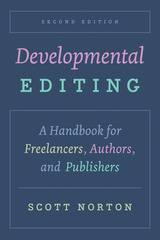 Developmental Editing, Second Edition: A Handbook for Freelancers, Authors, and Publishers
Scott Norton
University of Chicago Press, 2023 The only guide dedicated solely to developmental editing, now revised and updated with new exercises and a chapter on fiction.
Developmental editing—transforming a manuscript into a book that edifies, inspires, and sells—is a special skill, and Scott Norton is one of the best at it. With more than three decades of experience in the field, Norton offers his expert advice on how to approach the task of diagnosing and fixing structural problems with book manuscripts in consultation with authors and publishers. He illustrates these principles through a series of detailed case studies featuring before-and-after tables of contents, samples of edited text, and other materials to make an otherwise invisible process tangible.
This revised edition for the first time includes exercises that allow readers to edit sample materials and compare their work with that of an experienced professional as well as a new chapter on the unique challenges of editing fiction. In addition, it features expanded coverage of freelance business arrangements, self-published authors, e-books, content marketing, and more.
Whether you are an aspiring or experienced developmental editor or an author who works alongside one, you will benefit from Norton’s accessible, collaborative, and realistic approach and guidance. This handbook offers the concrete and essential tools it takes to help books to find their voice and their audience.
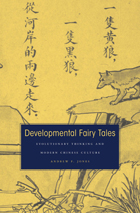 Developmental Fairy Tales: Evolutionary Thinking and Modern Chinese Culture
Andrew F. Jones
Harvard University Press, 2011 In 1992 Deng Xiaoping famously declared, “Development is the only hard imperative.” What ensued was the transformation of China from a socialist state to a capitalist market economy. The spirit of development has since become the prevailing creed of the People’s Republic, helping to bring about unprecedented modern prosperity, but also creating new forms of poverty, staggering social upheaval, physical dislocation, and environmental destruction.
In Developmental Fairy Tales, Andrew F. Jones asserts that the groundwork for this recent transformation was laid in the late nineteenth century, with the translation of the evolutionary works of Lamarck, Darwin, and Spencer into Chinese letters. He traces the ways that the evolutionary narrative itself evolved into a form of vernacular knowledge which dissolved the boundaries between beast and man and reframed childhood development as a recapitulation of civilizational ascent, through which a beleaguered China might struggle for existence and claim a place in the modern world-system.
This narrative left an indelible imprint on China’s literature and popular media, from children’s primers to print culture, from fairy tales to filmmaking. Jones’s analysis offers an innovative and interdisciplinary angle of vision on China’s cultural evolution. He focuses especially on China’s foremost modern writer and public intellectual, Lu Xun, in whose work the fierce contradictions of his generation’s developmentalist aspirations became the stuff of pedagogical parable. Developmental Fairy Tales revises our understanding of literature’s role in the making of modern China by revising our understanding of developmentalism’s role in modern Chinese literature.
 Developmental Nephrology
Wallace W. McCrory
Harvard University Press, 1972 "It is my hope," writes the author in his preface, "that the material collected in this monograph will provide a new perspective in some areas for those students, biologists, and physicians interested in the kidney but too involved with their special trees to notice some of the changes occurring in the forest in which they toil."
In the first up-to-date compendium to correlate the changes in kidney structure and function from the onset of organogenesis to the end of childhood growth, Dr. Wallace McCrory presents a new aspect of developmental pediatrics, skillfully explains the clinical enigmas surrounding the immature kidney, and suggests possible research areas for productive exploration. Clearly documented with tables and illustrations, the study synthesizes relevant new knowledge from the fields of embryology, biochemistry, and renal and growth physiology as a means of stimulating reappraisals of the current concepts of the pathophysiology of many childhood renal diseases. Included are reproductions of reconstructed micro dissections of the early stages in the developing human kidney taken from Dr. Jean Oliver's monograph Nephrons and Kidneys.
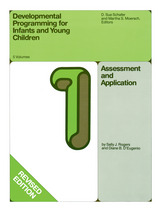 Developmental Programming for Infants and Young Children: Volume 1. Assessment and Application
D. Sue Schafer and Martha S. Moersch, Editors
University of Michigan Press, 1981 Developmental Programming for Infants and Young Children: Volume 1 provides detailed instructions for the use of Volume 2: Early Intervention Developmental Profile, including administration and evaluation techniques, scoring and interpretation of results, validity and reliability of findings, and complete item descriptions. To be used with children functioning in the 0-to-36-month developmental age range. Volume 1 includes the scoring sheet (Volume 2). Developmental Programming for Infants and Young Children has proven to be an invaluable tool for teachers, therapists, and other professionals who assess and facilitate the development of children functioning primarily in the 0-to-60 month range. The authors address six areas of development: perceptual/fine motor, cognition, language, social/emotional, self-care, and gross motor. Volumes 1, 2, and 3 are designed for use with children functioning in the 0-to-36-month developmental age range, while Volumes 4 and 5 extend assessment and programming guidelines to 5-year (preschool) levels. Carefully designed and tested by the University of Michigan's Institute for the Study of Mental Retardation and Related Disabilities, all volumes bridge the gap between assessment and program implementation.
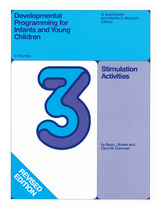 Developmental Programming for Infants and Young Children: Volume 3. Stimulation Activities
D. Sue Schafer and Martha S. Moersch, Editors
University of Michigan Press, 1981 Developmental Programming for Infants and Young Children: Volume 3 provides a reservoir of ideas for carrying out planned program objectives. Each developmental area contains sequenced develop mental behaviors that would be expected in a normal child, with adaptations for specific handicapping conditions noted. This volume describes ways to handle, stimulate, and interact with a young child functioning in the developmental age range 0-to-36 months. It can be used by parents for at-home activities. This volume is available as a set in combination with Volumes 1 and 2. Developmental Programming for Infants and Young Children has proven to be an invaluable tool for teachers, therapists, and other professionals who assess and facilitate the development of children functioning primarily in the 0-to-60 month range. The authors address six areas of development: perceptual/fine motor, cognition, language, social/emotional, self-care, and gross motor. Volumes 1, 2, and 3 are designed for use with children functioning in the 0-to-36-month developmental age range, while Volumes 4 and 5 extend assessment and programming guidelines to 5-year (preschool) levels. Carefully designed and tested by the University of Michigan's Institute for the Study of Mental Retardation and Related Disabilities, all volumes bridge the gap between assessment and program implementation.
The Developmental Role of the Foreign Sector and Aid
Anne O. Krueger
Harvard University Press, 1979 This volume analyzes the role of trade and aid in Korea’s modernization and development from 1945 to 1975. After regarding the four major sub-periods of Korean development—1945-50; 1953-60; 1961-64; and 1965 to the present—the author discusses the efficiency of Korean economic policies, arguing that the inefficiencies of the 1950s at both the micro and the macro levels stand in the sharp contrast to the apparently efficient economic policies of the late 1960s and early 1970s.
Developments in Antenna Analysis and Design, Volume 1
Raj Mittra
The Institution of Engineering and Technology, 2019 Developments in Antenna Analysis and Design presents recent developments in antenna design and modeling techniques for a wide variety of applications, chosen because they are contemporary in nature, have been receiving considerable attention in recent years, and are crucial for future developments. It includes topics such as body-worn antennas, that play an important role as sensors for Internet of Things (IoT), and millimeter wave antennas that are vitally important for 5G devices. It also covers a wide frequency range that includes terahertz and optical frequencies. Additionally, it discusses topics such as theoretical bounds of antennas and aspects of statistical analysis that are not readily found in the existing literature.
Developments in Antenna Analysis and Design, Volume 2
Raj Mittra
The Institution of Engineering and Technology, 2019 Developments in Antenna Analysis and Design presents recent developments in antenna design and modeling techniques for a wide variety of applications, chosen because they are contemporary in nature, have been receiving considerable attention in recent years, and are crucial for future developments. It includes topics such as body-worn antennas, that play an important role as sensors for Internet of Things (IoT), and millimeter wave antennas that are vitally important for 5G devices. It also covers a wide frequency range that includes terahertz and optical frequencies. Additionally, it discusses topics such as theoretical bounds of antennas and aspects of statistical analysis that are not readily found in the existing literature.
Developments in Antenna Analysis and Synthesis
Raj Mittra
The Institution of Engineering and Technology, 2018 This book addresses practical issues which antenna design engineers face every day and discusses the concepts and tools which will help them design better antennas. It covers recent advances in the antenna field, giving a compilation of the latest advances and designs. Topics include antenna pattern synthesis; reconfigurable and active antennas; MIMO antennas; reflectarray antennas; 3-D printed antennas and many more.
 Developments in Central and East European Politics 4
Stephen White, Judy Batt and Paul G. Lewis, eds.
Duke University Press The face of Central and Eastern Europe has been dramatically transformed since the collapse of communism. The region faces new challenges, including the needs to find a balance between effective leadership and accountability and to reverse the economic decline of the late communist years. Addressing these concerns and others, Developments in Central and East European Politics 4 brings together specially commissioned chapters by leading scholars from both sides of the Atlantic. The chapters, all of which are new to this edition, focus on key features of the political systems that have emerged following the transition to postcommunist rule and the enlargement of the European Union through 2006. Full attention is given to the pattern of events in individual nations, but the main emphasis is on the framework of politics across the region—constitutions, leadership, parliaments, parties, and electoral systems—and the process of politics, as it is revealed in political participation, civil society, economic change, and the quality of democratic government within and beyond the region. Clearly written and well supported with references and suggestions for further reading, Developments in Central and East European Politics 4 is the ideal guide to the process of change in a group of states that were formerly modeled on the Soviet Union but are now a distinctive and varied presence within a continent that has been redefining its boundaries, its values, its economic systems, and its international allegiances. Contributors. Judy Batt, Dirk Berg-Schlosser, Sarah Birch, Heather Grabbe, Tim Haughton, Krzysztof Jasiewicz, Petr Kopecký, Paul G. Lewis, Frances Millard, Cas Mudde, D. Mario Nuti, Mark Pittaway, Ray Taras, Stephen White, Andrew Wilson, Kataryna Wolczuk
 Developments in Central and East European Politics 4
Stephen White, Judy Batt and Paul G. Lewis, eds.
Duke University Press The face of Central and Eastern Europe has been dramatically transformed since the collapse of communism. The region faces new challenges, including the needs to find a balance between effective leadership and accountability and to reverse the economic decline of the late communist years. Addressing these concerns and others, Developments in Central and East European Politics 4 brings together specially commissioned chapters by leading scholars from both sides of the Atlantic. The chapters, all of which are new to this edition, focus on key features of the political systems that have emerged following the transition to postcommunist rule and the enlargement of the European Union through 2006. Full attention is given to the pattern of events in individual nations, but the main emphasis is on the framework of politics across the region—constitutions, leadership, parliaments, parties, and electoral systems—and the process of politics, as it is revealed in political participation, civil society, economic change, and the quality of democratic government within and beyond the region. Clearly written and well supported with references and suggestions for further reading, Developments in Central and East European Politics 4 is the ideal guide to the process of change in a group of states that were formerly modeled on the Soviet Union but are now a distinctive and varied presence within a continent that has been redefining its boundaries, its values, its economic systems, and its international allegiances. Contributors. Judy Batt, Dirk Berg-Schlosser, Sarah Birch, Heather Grabbe, Tim Haughton, Krzysztof Jasiewicz, Petr Kopecký, Paul G. Lewis, Frances Millard, Cas Mudde, D. Mario Nuti, Mark Pittaway, Ray Taras, Stephen White, Andrew Wilson, Kataryna Wolczuk
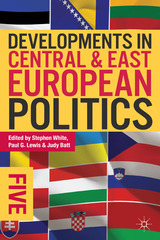 Developments in Central and East European Politics 5
Stephen White, Paul G. Lewis, and Judy Batt, eds.
Duke University Press This fifth edition of Developments in Central and East European Politics maintains the series' status as the most up-to-date and authoritative guide to political transformations in the region. The countries that emerged from the collapse of communism between 1989 and 1991 embarked on transitions to democracy and a market economy that were profoundly affected by developments such as the expansion of the European Union (EU) and NATO. Central and East Europe is a large, extremely diverse region, encompassing full-fledged EU members—the Czech Republic, Hungary, Poland, Estonia, Latvia, Lithuania, Slovenia, and Slovakia, followed later by Bulgaria and Romania—as well as nations of the Western Balkans that are progressing at various speeds along the EU path—Croatia, about to join; Macedonia, Montenegro and Serbia, with EU candidate status; and Albania, Bosnia and Herzegovina, and Kosovo, struggling to keep up. The region also includes the East European states of Ukraine, Belarus, and Moldova. In this collection, leading authorities examine how these heterogeneous nations have fared since the collapse of communism. The contributors look at executive leadership, elections and voter behavior, parliamentary systems, political parties, citizen engagement in civil society, the effects of neoliberalism, and the quality of life in postcommunist democracies. Most of the essays are new to this edition; the rest have been thoroughly updated.
Contributors. Judy Batt, Sarah Birch, Nathaniel Copsey, Terry Cox, Rick Fawn, Tim Haughton, Krzysztof Jasiewicz, Paul G. Lewis, Frances Millard, David M. Olson, Mitchell A. Orenstein, Andrew Roberts, Ray Taras, Stephen White, Andrew Wilson
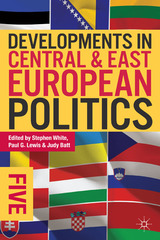 Developments in Central and East European Politics 5
Stephen White, Paul G. Lewis, and Judy Batt, eds.
Duke University Press This fifth edition of Developments in Central and East European Politics maintains the series' status as the most up-to-date and authoritative guide to political transformations in the region. The countries that emerged from the collapse of communism between 1989 and 1991 embarked on transitions to democracy and a market economy that were profoundly affected by developments such as the expansion of the European Union (EU) and NATO. Central and East Europe is a large, extremely diverse region, encompassing full-fledged EU members—the Czech Republic, Hungary, Poland, Estonia, Latvia, Lithuania, Slovenia, and Slovakia, followed later by Bulgaria and Romania—as well as nations of the Western Balkans that are progressing at various speeds along the EU path—Croatia, about to join; Macedonia, Montenegro and Serbia, with EU candidate status; and Albania, Bosnia and Herzegovina, and Kosovo, struggling to keep up. The region also includes the East European states of Ukraine, Belarus, and Moldova. In this collection, leading authorities examine how these heterogeneous nations have fared since the collapse of communism. The contributors look at executive leadership, elections and voter behavior, parliamentary systems, political parties, citizen engagement in civil society, the effects of neoliberalism, and the quality of life in postcommunist democracies. Most of the essays are new to this edition; the rest have been thoroughly updated.
Contributors. Judy Batt, Sarah Birch, Nathaniel Copsey, Terry Cox, Rick Fawn, Tim Haughton, Krzysztof Jasiewicz, Paul G. Lewis, Frances Millard, David M. Olson, Mitchell A. Orenstein, Andrew Roberts, Ray Taras, Stephen White, Andrew Wilson
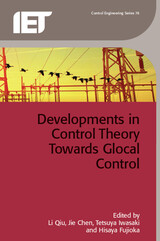 Developments in Control Theory Towards Glocal Control
Li Qiu
The Institution of Engineering and Technology, 2012 Glocal control, a term coined by Professor Shinji Hara at The University of Tokyo, represents a new framework for studying behaviour of complex dynamical systems from a feedback control perspective. A large number of dynamical components can be interconnected and interact with each other to form an integrated system with certain functionalities. Such complex systems are found in nature and have been created by man, including gene regulatory networks, neuronal circuits for memory, decision making, and motor control, bird flocking, global climate dynamics, central processing units for computers, electrical power grids, the World Wide Web, and financial markets. A common feature of these systems is that a global property or function emerges as a result of local, distributed, dynamical interactions of components. The objective of 'glocal' (global + local) control is to understand the mechanisms underlying this feature, analyze existing complex systems, and to design and create innovative systems with new functionalities. This book is dedicated to Professor Shinji Hara on the occasion of his 60th birthday, collecting the latest results by leading experts in control theories to lay a solid foundation towards the establishment of glocal control theory in the coming decades.
 Developments in German Politics 3
Stephen Padgett, William E. Paterson, and Gordon Smith, eds.
Duke University Press Once the miracle economy of the continent, Germany now staggers under the massive cost burden of unification while it struggles to come to terms with global economic change. Failure to confront the underlying economic weakness has discredited political institutions and patterns of political behavior that were once regarded as the ‘efficient secret’ of economic success. The country stands at the crossroads between economic reform and a spiral of economic decline with unpredictable fallout. Bringing together entirely new chapters by leading authorities in the field, Developments in German Politics 3 examines the unfolding crisis of German political economy; its repercussions for polity, politics, and policy; and the consequences for Germany’s role in Europe and the wider world. Like its predecessors, this book will be of interest to all concerned with European politics and will be necessary reading for students of German politics and society. Contributors. David P. Conradt, Russell J. Dalton, Kenneth Dyson, Klaus H. Goetz, Simon Green, Adrian Hyde-Price, Charlie Jeffery, Stephen Padgett, William E. Paterson, Wolfgang Rüdig, Martin Seeleib-Kaiser, Gordon Smith, Roland Sturm
 Developments in German Politics 3
Stephen Padgett, William E. Paterson, and Gordon Smith, eds.
Duke University Press Once the miracle economy of the continent, Germany now staggers under the massive cost burden of unification while it struggles to come to terms with global economic change. Failure to confront the underlying economic weakness has discredited political institutions and patterns of political behavior that were once regarded as the ‘efficient secret’ of economic success. The country stands at the crossroads between economic reform and a spiral of economic decline with unpredictable fallout. Bringing together entirely new chapters by leading authorities in the field, Developments in German Politics 3 examines the unfolding crisis of German political economy; its repercussions for polity, politics, and policy; and the consequences for Germany’s role in Europe and the wider world. Like its predecessors, this book will be of interest to all concerned with European politics and will be necessary reading for students of German politics and society. Contributors. David P. Conradt, Russell J. Dalton, Kenneth Dyson, Klaus H. Goetz, Simon Green, Adrian Hyde-Price, Charlie Jeffery, Stephen Padgett, William E. Paterson, Wolfgang Rüdig, Martin Seeleib-Kaiser, Gordon Smith, Roland Sturm
 Developments in Russian Politics 10
Henry E. Hale, Juliet Johnson, and Tomila V. Lankina, editors
Duke University Press The tenth edition of this go-to text offers critical discussion of contemporary Russian politics and its fundamental principles. It covers established topics such as executive leadership, parties, and elections as well as newer issues of national identity, protest, and Russia and Greater Eurasia. Taking a bottom-up approach, Developments in Russian Politics 10 analyzes the political system in which Putin’s influence can be understood and covers frequently overlooked topics like the informal economy, climate change, and gender. The book is organized around the informal politics of hybrid regimes and authoritarianism and accounts for how Russian history impacts contemporary politics in counterintuitive ways, addressing notions of hybrid warfare, disinformation, and election meddling. The chapters have a modular quality and are designed to correspond to course teaching. Compiled by an international team of specialists and offering key questions, further reading suggestions, and a list of up-to-date repositories of video material, the edition will appeal to undergraduate and postgraduate students from across the world.
 Developments in Russian Politics 6
Stephen White, Zvi Gitelman, and Richard Sakwa, eds.
Duke University Press Taking as its starting point the elections of 2000 and 2004, Developments in Russian Politics 6 brings together all new, specially commissioned essays by leading experts to provide a wide-ranging assessment of Russian politics under Vladimir Putin. The contributors provide succinct overviews of aspects of contemporary Russia’s political landscape, including presidential power, parliamentary politics, elections and voters, political parties, federalism, regional politics, the media, the economy, and social and foreign policy. Clearly and accessibly written, Developments in Russian Politics remains the first-choice text for students and anyone seeking a reliable and current introduction to the politics of the world’s largest state. Contributors. Alfred B. Evans, Zvi Gitelman, Gordon Hahn, Margot Light, Michael McFaul, Sarah Oates, Thomas F. Remington, Peter Rutland, Richard Sakwa, Robert Sharlet, Darrell Slider, Judy Twigg, Stephen White, John P. Willerton
 Developments in Russian Politics 6
Stephen White, Zvi Gitelman, and Richard Sakwa, eds.
Duke University Press Taking as its starting point the elections of 2000 and 2004, Developments in Russian Politics 6 brings together all new, specially commissioned essays by leading experts to provide a wide-ranging assessment of Russian politics under Vladimir Putin. The contributors provide succinct overviews of aspects of contemporary Russia’s political landscape, including presidential power, parliamentary politics, elections and voters, political parties, federalism, regional politics, the media, the economy, and social and foreign policy. Clearly and accessibly written, Developments in Russian Politics remains the first-choice text for students and anyone seeking a reliable and current introduction to the politics of the world’s largest state. Contributors. Alfred B. Evans, Zvi Gitelman, Gordon Hahn, Margot Light, Michael McFaul, Sarah Oates, Thomas F. Remington, Peter Rutland, Richard Sakwa, Robert Sharlet, Darrell Slider, Judy Twigg, Stephen White, John P. Willerton
 Developments in Russian Politics 7
Stephen White, Richard Sakwa, and Henry E. Hale, eds.
Duke University Press Developments in Russian Politics 7 brings together specially commissioned essays by leading experts to present a wide-ranging assessment of politics in contemporary Russia, including the election and inauguration of Dmitri Medvedev as president and Vladimir Putin’s appointment as prime minister in the spring of 2008. The contributors provide succinct overviews of Russia’s executive leadership, parliamentary politics, elections, political parties, media and political communication, regional politics, economy, social policy, foreign policy, and defense and security. Clearly and accessibly written, Developments in Russian Politics remains the first-choice introduction to politics in the world’s largest nation. Contributors. Alfred B. Evans, Henry E. Hale, P. Hanson, Margot Light, N. Manning, J. Mathers, Michael McFaul, Sarah Oates, Thomas F. Remington, C. Ross, Richard Sakwa, Darrell Slider, G. Smith, Stephen White, John P. Willerton
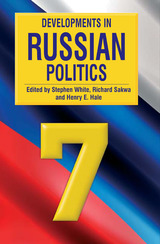 Developments in Russian Politics 7
Stephen White, Richard Sakwa, and Henry E. Hale, eds.
Duke University Press Developments in Russian Politics 7 brings together specially commissioned essays by leading experts to present a wide-ranging assessment of politics in contemporary Russia, including the election and inauguration of Dmitri Medvedev as president and Vladimir Putin’s appointment as prime minister in the spring of 2008. The contributors provide succinct overviews of Russia’s executive leadership, parliamentary politics, elections, political parties, media and political communication, regional politics, economy, social policy, foreign policy, and defense and security. Clearly and accessibly written, Developments in Russian Politics remains the first-choice introduction to politics in the world’s largest nation. Contributors. Alfred B. Evans, Henry E. Hale, P. Hanson, Margot Light, N. Manning, J. Mathers, Michael McFaul, Sarah Oates, Thomas F. Remington, C. Ross, Richard Sakwa, Darrell Slider, G. Smith, Stephen White, John P. Willerton
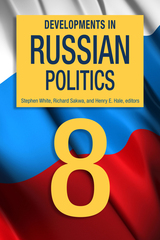 Developments in Russian Politics 8
Stephen White, Richard Sakwa and Henry E. Hale, eds.
Duke University Press In Developments in Russian Politics 8, leading experts provide a broad-ranging assessment of Putin's third term in power. All essays are either new or comprehensively rewritten for this volume, and cover executive power, parliamentary politics, the electoral process, the rule of law, foreign policy, the economy, and the military. They also address matters concerning Russia's media and political communication in the digital age; society and social divisions; protest and challenge; and future trajectories for Russian politics. Developments in Russian Politics remains the first-choice introduction to the politics of the world’s largest nation.
Contributors. Vladimir Gel'man, Henry E. Hale, Philip Hanson, Kathryn Hendley, Margot Light, Jennifer Mathers, Ian McAllister, Sarah Oates, Thomas F. Remington, Graeme Robertson, Richard Sakwa, Darrell Slider, Svetlana Stephenson, Stephen White, John P. Willerton
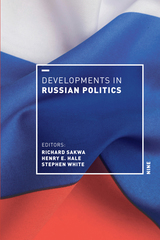 Developments in Russian Politics 9
Richard Sakwa, Henry E. Hale, and Stephen White, editors
Duke University Press, 2019 In Developments in Russian Politics 9 an international team of experts provides a clearly written and comprehensive account of the country's most recent developments, offering critical discussions of key areas in contemporary domestic and foreign Russian politics. All essays are either new or comprehensively rewritten for this volume and examine topics ranging from executive leadership, political parties, and elections to newer issues of national identity, protest, and Russia and greater Eurasia. They also address the military, parliamentary politics, the economy, social inequality, and media and political communication in the digital age. Reflecting the changing nature of Russian politics in a globalizing world defined by ever-shifting balances of power and Russia’s rising tensions with the West, Developments in Russian Politics remains the best introduction to the politics of the world's largest nation.
Contributors. Samuel Charap, Valentina Feklyunina, Henry E. Hale, Philip Hanson, Kathryn Hendley, Marlene Laruelle, Ellen Mickiewicz, Ben Noble, Thomas F. Remington, Bettina Renz, Ora John Reuter, Graeme Robertson, Richard Sakwa, Darrell Slider, Stephen White, John P. Willerton
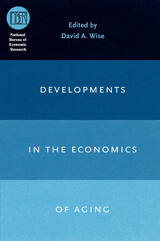 Developments in the Economics of Aging
Edited by David A. Wise
University of Chicago Press, 2009 The number of Americans eligible to receive Social Security benefits will increase from forty-five million to nearly eighty million in the next twenty years. Retirement systems must therefore adapt to meet the demands of the largest aging population in our nation’s history. In Developments in the Economics of Aging, David A. Wise and a distinguished group of analysts examine the economic issues that will confront policy makers as they seek to design policies to protect the economic and physical health of these older Americans.
The volume looks at such topics as factors influencing work and retirement decisions at older ages, changes in life satisfaction associated with retirement, and the shift in responsibility for managing retirement assets from professional money managers of traditional pension plans to individual account holders of 401(k)s. Developments in the Economics of Aging also addresses the complicated relationship between health and economic status, including why health behaviors vary across populations and how socioeconomic measures correlate with health outcomes.
Deviance and Medicalization: From Badness to Sickness
Peter Conrad and Joseph W. Schneider
Temple University Press, 1992 This classic text on the nature of deviance, originally published in 1980, is now reissued with a new Afterword by the authors. In this new edition of their award-winning book, Conrad and Schneider investigate the origins and contemporary consequences of the medicalization of deviance. They examine specific cases—madness, alcoholism, opiate addiction, homosexuality, delinquency, and child abuse—and draw out their theoretical and policy implications. In a new chapter, the authors address developments in the last decade—including AIDS, domestic violence, co-dependency, hyperactivity in children, and learning disabilities—and they discuss the fate of medicalization in the 1990s with the changes in medicine and continued restrictions on social services.
 Deviant and Useful Citizens: The Cultural Production of the Female Body in Eighteenth-Century Peru
Mariselle Melendez
Vanderbilt University Press, 2011 Deviant and Useful Citizens explores the conditions of women and perceptions of the female body in the eighteenth century throughout the Viceroyalty of Peru, which until 1776 comprised modern-day Argentina, Bolivia, Chile, Paraguay, Peru, and Uruguay. Author Mariselle Meléndez introduces the reader to a female rebel, Micaela Bastidas, whose brutal punishment became a particularly harsh example of state response to women who challenged the system. She explores the cultural representation of women depicted as economically productive and vital to the health of the culture at large. The role of women in religious orders provides still another window into the vital need to sustain the image of women as loyal and devout—and to deal with women who refused to comply.
The book focuses on the different ways male authorities, as well as female subjects, conceived the female body as deeply connected to notions of what constituted a useful or deviant citizen within the Viceroyalty. Using eighteenth-century legal documents, illustrated chronicles, religious texts, and newspapers, Meléndez explores in depth the representation of the female body in periods of political, economic, and religious transformation to determine how it was conceived within certain contexts.
Deviant and Useful Citizens presents a highly complex society that relied on representations of utility and productivity to understand the female body, as it reveals the surprisingly large stake that colonial authorities had in defining the status of women during a crucial time in South American history.
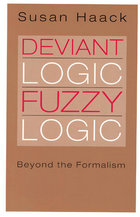 Deviant Logic, Fuzzy Logic: Beyond the Formalism
Susan Haack
University of Chicago Press, 1996 Initially proposed as rivals of classical logic, alternative logics have become increasingly important in areas such as computer science and artificial intelligence. Fuzzy logic, in particular, has motivated major technological developments in recent years.
Susan Haack's Deviant Logic provided the first extended examination of the philosophical consequences of alternative logics. In this new volume, Haack includes the complete text of Deviant Logic, as well as five additional papers that expand and update it. Two of these essays critique fuzzy logic, while three augment Deviant Logic's treatment of deduction and logical truth. Haack also provides an extensive new foreword, brief introductions to the new essays, and an updated bibliography of recent work in these areas.
Deviant Logic, Fuzzy Logic will be indispensable to students of philosophy, philosophy of science, linguistics, mathematics, and computer science, and will also prove invaluable to experienced scholars working in these fields.
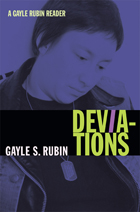 Deviations: A Gayle Rubin Reader
Gayle S. Rubin
Duke University Press, 2012 Deviations is the definitive collection of writing by Gayle S. Rubin, a pioneering theorist and activist in feminist, lesbian and gay, queer, and sexuality studies since the 1970s. Rubin first rose to prominence in 1975 with the publication of “The Traffic in Women,” an essay that had a galvanizing effect on feminist thinking and theory. In another landmark piece, “Thinking Sex,” she examined how certain sexual behaviors are constructed as moral or natural, and others as unnatural. That essay became one of queer theory’s foundational texts. Along with such canonical work, Deviations features less well-known but equally insightful writing on subjects such as lesbian history, the feminist sex wars, the politics of sadomasochism, crusades against prostitution and pornography, and the historical development of sexual knowledge. In the introduction, Rubin traces her intellectual trajectory and discusses the development and reception of some of her most influential essays. Like the book it opens, the introduction highlights the major lines of inquiry pursued for nearly forty years by a singularly important theorist of sex, gender, and culture.
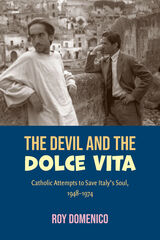 The Devil and the Dolce Vita: Catholic Attempts to Save Italy's Soul, 1948-1974
Roy Domenico
Catholic University of America Press, 2021 Italy’s economic expansion after World War Two triggered significant social and cultural change. Secularization accompanied this development and triggered alarm bells across the nation’s immense Catholic community. The Devil and the Dolce Vita is the story of that community – the church of Popes Pius XII, John XXIII and Paul VI, the lay Catholic Action association, and the Christian Democratic Party – and their efforts in a series of culture wars to preserve a traditional way of life and to engage and tame the challenges of a rapidly modernizing society.
Roy Domenico begins this study during the heady days of the April 1948 Christian Democratic electoral triumph and ends when pro-divorce forces dealt the Catholics a defeat in the referendum of May 1974 where their hopes crashed and probably ended. Between those two dates Catholics engaged secularists in a number of battles – many over film and television censorship, encountering such figures as Roberto Rossellini, Luchino Visconti, Federico Fellini, and Pier Paolo Pasolini. The Venice Film Festival became a locus in the fight as did places like Pozzonovo, near Padua, where the Catholics directed their energies against a Communist youth organization; and Prato in Tuscany where the bishop led a fight to preserve church weddings. Concern with proper decorum led to more skirmishes on beaches and at resorts over modest attire and beauty pageants. By the 1960s and 1970s other issues, such as feminism, a new frankness about sexual relations, and the youth rebellion emerged to contribute to a perfect storm that led to the divorce referendum and widespread despair in the Catholic camp.
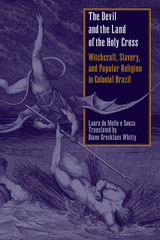 The Devil and the Land of the Holy Cross: Witchcraft, Slavery, and Popular Religion in Colonial Brazil
By Laura de Mello e Souza
University of Texas Press, 2004 Originally published in Brazil as O Diabo e a Terra de Santa Cruz, this translation from the Portuguese analyzes the nature of popular religion and the ways it was transferred to the New World in the sixteenth and seventeenth centuries. Using richly detailed transcripts from Inquisition trials, Mello e Souza reconstructs how Iberian, indigenous, and African beliefs fused to create a syncretic and magical religious culture in Brazil. Focusing on sorcery, the author argues that European traditions of witchcraft combined with practices of Indians and African slaves to form a uniquely Brazilian set of beliefs that became central to the lives of the people in the colony. Her work shows how the Inquisition reinforced the view held in Europe (particularly Portugal) that the colony was a purgatory where those who had sinned were exiled, a place where the Devil had a wide range of opportunities. Her focus on the three centuries of the colonial period, the multiple regions in Brazil, and the Indian, African, and Portuguese traditions of magic, witchcraft, and healing, make the book comprehensive in scope. Stuart Schwartz of Yale University says, "It is arguably the best book of this genre about Latin America...all in all, a wonderful book." Alida Metcalf of Trinity University, San Antonio, says, "This book is a major contribution to the field of Brazilian history...the first serious study of popular religion in colonial Brazil...Mello e Souza is a wonderful writer."
 The Devil Is in It: A History of the American Acoustic Guitar
John Stubbings
University of Texas Press, 2025 The rich history of the acoustic guitar and its impact on the music world. In 2020, guitar expert John Stubbings released a limited-edition book on the American acoustic guitar that sold out in days. Now, The Devil Is in It returns with additional research and subject matter for a new generation of readers. Stubbings traveled the country and met with guitar makers, players, collectors, and historians to unravel the long and rich history of the acoustic guitar, its evolution, and the music it has made over the last hundred years. Starting with the eighteenth-century European classical guitar, luthiers altered the instrument, changing the way musicians played them, and in turn the music they made. This slow but steady transformation created the iconic American flat-top that became influential across genres and rooted itself in cultural significance. The guitar developed from an obscure instrument into a superstar of the musical world, rivaling then overshadowing its competition. Tied to artists from Gillian Welch and Tracy Chapman to Taylor Swift and Ed Sheeran, the acoustic guitar maintains its eminence in American music and culture. The story of an alluring instrument that shaped the music of the twentieth century, The Devil Is in It is a must-read for lovers of the acoustic guitar and the music it has made.
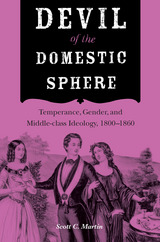 Devil of the Domestic Sphere: Temperance, Gender, and Middle-class Ideology, 1800-1860
Scott C. Martin
Northern Illinois University Press, 2010
Drink, in the minds of antebellum temperance reformers, represented the threat of an increasingly urban, industrial world. Contrasting the drunkards’ lack of restraint with their own thrift and sobriety, these members of the emerging middle class lay claim to respectability, virtue, and moral leadership. As they sought to legitimate their own authority, reformers also employed temperance literature to propagate middle-class ideas about the nature of women and their role as guardians of the home.
Stories of women as innocent victims and loving saviors filled temperance literature. Ministers, novelists, and journalists portrayed wives beaten by drunken husbands; poets and songwriters extolled mothers and sisters who rescued men from demon drink. Yet a strand of misogyny also ran through temperance ideology. Denunciation of women as causes of intemperance and snares for men, and celebration of women’s victimization often coexisted with a more positive assessment of women’s role in the emerging middle class. Unless a woman remained vigilant, she too might succumb to drink, and reformers had very little sympathy for such a fallen angel.
By examining the contradictory images of women employed by the antebellum temperance movement, Scott Martin reveals the reformers’ commitment not only to social betterment but also to middle-class interests and a particular gender ideology. Martin explores the reasons why more men than women drank, the ways in which society dealt with women who neglected familial and social obligations to become drunkards, and the consequences of women’s failure to eradicate male drunkenness.
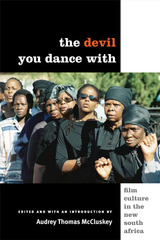 The Devil You Dance With: Film Culture in the New South Africa
Edited and with an Introduction by Audrey McCluskey
University of Illinois Press, 2008 South African film culture, like so much of its public life, has undergone a tremendous transformation during its first decade of democracy. Filmmakers, once in exile, banned, or severely restricted, have returned home; subjects once outlawed by the apparatchiks of apartheid are now fair game; and a new crop of insurgent filmmakers are coming to the fore. This extraordinary volume presents twenty-five in-depth interviews with established and emerging South African filmmakers, collected and edited by Audrey Thomas McCluskey. The interviews capture the filmmakers’ spirit, energy, and ambition as they attempt to give birth to a film culture that reflects the heart and aspirations of their diverse and emergent nation. The collection includes a biographical profile of each filmmaker, as well an introductory essay by McCluskey, pointing to the themes, as well as creative differences and similarities, among the filmmakers.
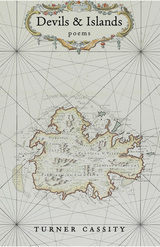 Devils & Islands: Poems
Turner Cassity
Ohio University Press, 2007 As he approaches eighty, Turner Cassity may finally be out of control. His hatchet has never fallen more lethally, meaning if you have the stomach for him he is more enjoyable than ever. Under the blade come Martha Graham, Johann Sebastian Bach, musicologists, tree huggers, Frank Gehry, folk music, folk art of all times and all places, folk… . There are, however, his unpredictable sympathies: Edith Wilson, skyscrapers, Pontius Pilate, Pilate’s legionnaires. He obviously has a soft spot for Pop Culture, although he cannot avoid seeingit de haut en bas. As usual, he is all over the place geographically. One feels he would slash his wrists before he would write a poem about any city on the traditional Grand Tour. Manaus, Campeche, Trieste, Budapest (as destroyed by Godzilla)—these are his places. He has a disturbing willingness to write on both sides of an issue, resembling in this Bernard Shaw. You have to read very carefully to see whether he tips his hand. One looks forward to Mr. Cassity’s posthumous poems, when he is beyond the reach of libel. For now, at least, we have Devils & Islands.
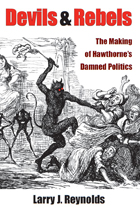 Devils and Rebels: The Making of Hawthorne's Damned Politics
Larry J. Reynolds
University of Michigan Press, 2010 "An outstanding combination of literary interpretation and cultural and historical context that will be an important addition to the critical literature on Hawthorne."
---Nina Baym, University of Illinois "It is difficult to imagine a more timely book than Devils and Rebels. Examining the role of the public intellectual and writer during a time of political conflict and war, Reynolds takes up his charges with great precision and historical finesse. What particularly distinguishes this book is its attention to the ways in which one of this country's most important authors struggled to resist the waves of political extremism and patriotic hysteria that swept around him."
---Jeffrey Steele, University of Wisconsin—Madison Widely condemned even in his own time, Nathaniel Hawthorne's views on abolitionism and slavery are today frequently characterized by scholars as morally reprehensible. Devils and Rebels explores the historical and biographical record to reveal striking evidence of the author's true political values---values grounded in pacifism and resistant to the kind of binary thinking that could lead to violence and war. The book offers fresh readings of not only Hawthorne's four major romances but also some of his less familiar works like "Legends of the Province House," The Whole History of Grandfather's Chair, Journal of an African Cruiser, The Life of Franklin Pierce, and "Septimius Felton." Reynolds argues that Hawthorne---whether in his politics or his art---drew upon racialized imagery from America's past revolution and war on witchcraft to create a politics of quiet imagination, alert to the ways in which New England righteousness could become totalitarian by imposing its narrow view of the world on others. Meticulously researched and cogently argued, this groundbreaking work demonstrates the need to examine perspectives and values from beyond the New England region when studying the literary history of the American Renaissance and illuminates the difficulties faced by public intellectuals during times of political strife---an issue as relevant today as it was some one hundred and fifty years ago. Larry J. Reynolds is Thomas Franklin Mayo Professor of Liberal Arts and Professor of English at Texas A&M University. His previous books include A Historical Guide to Nathaniel Hawthorne, National Imaginaries, American Identities: The Cultural Work of American Iconography, and European Revolutions and the American Literary Renaissance as well as an edition of the European writings of Margaret Fuller.
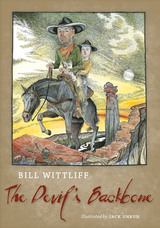 The Devil's Backbone
By Bill Wittliff, illustrated by Jack Unruh
University of Texas Press, 2014 The last the boy Papa saw of his Momma, she was galloping away on her horse Precious in the saddle her father took from a dead Mexican officer after the Battle of San Jacinto, fleeing from his Daddy, Old Karl, a vicious, tight-fisted horse trader. Momma’s flight sets Papa on a relentless quest to find her that thrusts him and his scrappy little dog Fritz into adventures all across the wild and woolly Hill Country of Central Texas, down to Mexico, and even into the realm of the ghostly “Shimmery People.” In The Devil’s Backbone, master storyteller Bill Wittliff takes readers on an exciting journey through a rough 1880s frontier as full of colorful characters and unexpected turns of events as the great American quest novel Adventures of Huckleberry Finn. Wittliff grew up listening to stories and memories like these in his own family, and in this imaginative novel, they come to vivid life, creating an engrossing story of a Texas Huck Finn that brims with folk wisdom and sly humor. A rogue’s gallery of characters thwart and aid Papa’s path—Old Karl, hell-bent on bringing the boy back to servitude on his farm, and Herman, Papa’s brother who’s got Old Karl’s horse-trading instincts and greed; Calley Pearsall, an enigmatic cowboy with “other Fish to Fry” who might be an outlaw or a trustworthy “o’Amigo”; o’Jeffey, a black seer who talks to the spirits but won’t tell Papa what she has divined about his Momma; Mister Pegleg, a three-legged coyote with whom Papa forms a poignant, nearly tragic friendship; the “Mexkins” Pepe and Peto and their father Old Crecencio, whose longing for his lost family is as strong as Papa’s; and blind Bird, a magical “blue baby” who can’t see with his eyes but who helps other people see what they hold in their hearts. Papa’s adventures draw him ever nearer to a mysterious cave that haunts his dreams—an actual cave that he discovers at last in the canyons of the Devil’s Backbone—but will he find Momma before Old Karl finds him?
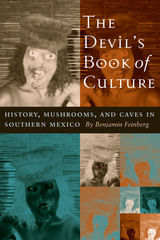 The Devil's Book of Culture: History, Mushrooms, and Caves in Southern Mexico
By Benjamin Feinberg
University of Texas Press, 2003 Since the 1950s, the Sierra Mazateca of Oaxaca, Mexico, has drawn a strange assortment of visitors and pilgrims—schoolteachers and government workers, North American and European spelunkers exploring the region's vast cave system, and counterculturalists from hippies (John Lennon and other celebrities supposedly among them) to New Age seekers, all chasing a firsthand experience of transcendence and otherness through the ingestion of psychedelic mushrooms "in context" with a Mazatec shaman. Over time, this steady incursion of the outside world has significantly influenced the Mazatec sense of identity, giving rise to an ongoing discourse about what it means to be "us" and "them." In this highly original ethnography, Benjamin Feinberg investigates how different understandings of Mazatec identity and culture emerge through talk that circulates within and among various groups, including Mazatec-speaking businessmen, curers, peasants, intellectuals, anthropologists, bureaucrats, cavers, and mushroom-seeking tourists. Specifically, he traces how these groups express their sense of culture and identity through narratives about three nearby yet strange discursive "worlds"—the "magic world" of psychedelic mushrooms and shamanic practices, the underground world of caves and its associated folklore of supernatural beings and magical wealth, and the world of the past or the past/present relationship. Feinberg's research refutes the notion of a static Mazatec identity now changed by contact with the outside world, showing instead that identity forms at the intersection of multiple transnational discourses.
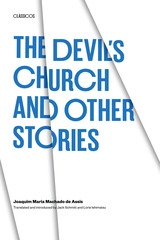 The Devil's Church and Other Stories
By Joaquim Maria Machado de Assis
University of Texas Press, 1977 The modem Brazilian short story begins with the mature work of Joaquim Maria Machado de Assis (1839-1908), acclaimed almost unanimously as Brazil's greatest writer. Collectively, these nineteen stories are representative of Machado's unique style and world view, and this translation doubles the number of his stories previously available in English. The stories in this volume reflect Machado's post-1880 emphasis on social satire and experimentation in psychological realism. If he had continued to produce the moralistic love stories and parlor intrigues of his earlier fiction, Machado's legacy would have been an entertaining but inconsequent body of work. However, by 1880 he had begun a devastating satirical assault on society through his fiction. In spite of his ruthlessness, Machado does at times reveal an ironic sympathy for his characters. He is not indifferent to human conflict but uses humor and irony to stress the absurdity of these conflicts, acted out against the backdrop of an indifferent universe. Such a spectacle creates a sense of helplessness that can only inspire wistful amusement. In his technical mastery of the short story. Machado was decades ahead of his contemporaries and can still be considered more modern than most of the modernists themselves. That his stories elicit such strong and diverse reactions today is a tribute to their richness, complexity, and significance.
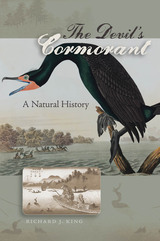 The Devil’s Cormorant: A Natural History
Richard J. King
University Press of New England, 2014 Behold the cormorant: silent, still, cruciform, and brooding; flashing, soaring, quick as a snake. Evolution has crafted the only creature on Earth that can migrate the length of a continent, dive and hunt deep underwater, perch comfortably on a branch or a wire, walk on land, climb up cliff faces, feed on thousands of different species, and live beside both fresh and salt water in a vast global range of temperatures and altitudes, often in close proximity to man. Long a symbol of gluttony, greed, bad luck, and evil, the cormorant has led a troubled existence in human history, myth, and literature. The birds have been prized as a source of mineral wealth in Peru, hunted to extinction in the Arctic, trained by the Japanese to catch fish, demonized by Milton in Paradise Lost, and reviled, despised, and exterminated by sport and commercial fishermen from Israel to Indianapolis, Toronto to Tierra del Fuego. In The Devil’s Cormorant, Richard King takes us back in time and around the world to show us the history, nature, ecology, and economy of the world’s most misunderstood waterfowl.
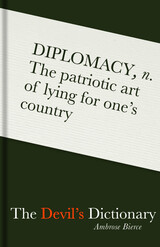 The Devil's Dictionary
Ambrose Bierce
Bodleian Library Publishing, 2018 Ambrose Bierce, journalist and former soldier for the Union army in the Civil War, began writing satirical definitions for the San Francisco Wasp in 1881, and later for the San Francisco Examiner, launching a journalistic career that would see him liked and loathed in equal measure and earn him the title of “the wickedest man in San Francisco.”
A contemporary of Mark Twain, Bierce brought his biting humor to bear on spoof definitions of everyday words, writing deliberate mistranslations of the vocabulary of the establishment, the church, and the politics of his day, and shining a sardonic light on hypocrisy and deception. These columns formed the beginnings of a dictionary, first published in 1906 as The Cynic’s Word Book, which stopped at the letter L, and five years later as a full A–Z text known as The Devil's Dictionary. More than one hundred years later, Bierce’s redefinitions still give us pause for thought: interpreting reporter, for example, as “a writer who guesses his way to the truth and dispels it with a tempest of words”; un-american as “wicked, intolerable, heathenish”; and politics as “the conduct of public affairs for private advantage.” This timely new edition of Bierce’s irreverent and provocative dictionary is the perfect gift for misanthropes and word lovers alike.
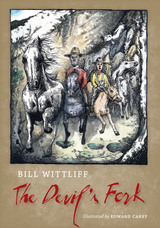 The Devil's Fork
By Bill Wittliff
University of Texas Press, 2018 The Devil’s Fork opens with the boy Papa exclaiming, “They was gonna hang my o’Amigo Calley Pearsall out there in front a’the Alamo down in San Antoneya come Saturday Noon and if I was gonna stop it I better Light a Shuck and Get on with it. And I mean Right Now.” And so Papa and his sweetheart Annie Oster set off to rescue Calley, thereby launching themselves into another series of hair-raising adventures. The Devil’s Fork concludes the enthralling journey through wild and woolly Central Texas in the 1880s that began in The Devil’s Backbone and The Devil’s Sinkhole. Papa springs Calley from jail, but their troubles are far from over. Framed for murder, the two amigos have to flee for their lives. Joining their flight this time is o’Johnny, the evil Sheriff Pugh’s disabled little brother, who has uncanny abilities. Escaping danger for a while, Papa and Calley try to start a new life as horse traders, only to find themselves branded as horse thieves when o’Johnny and a mysterious white ghost horse begin rescuing abused horses from their masters. Can Papa and Calley escape the noose and save all the horses that Johnny and the White Horse liberate? Or will their own hot tempers send them down the Devil’s Fork, from which no one ever returns? Proving himself a master storyteller once again, Bill Wittliff spins a yarn as engrossing as the stories his own Papa told him long ago, stories that inspired The Devil’s Backbone, The Devil’s Sinkhole, and The Devil’s Fork.
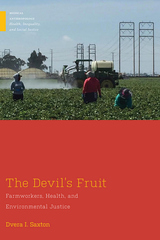 The Devil's Fruit: Farmworkers, Health, and Environmental Justice
Dvera I. Saxton
Rutgers University Press, 2021 The Devil's Fruit describes the facets of the strawberry industry as a harm industry, and explores author Dvera Saxton’s activist ethnographic work with farmworkers in response to health and environmental injustices. She argues that dealing with devilish—as in deadly, depressing, disabling, and toxic—problems requires intersecting ecosocial, emotional, ethnographic, and activist labors. Through her work as an activist medical anthropologist, she found the caring labors of engaged ethnography take on many forms that go in many different directions. Through chapters that examine farmworkers’ embodiment of toxic pesticides and social and workplace relationships, Saxton critically and reflexively describes and analyzes the ways that engaged and activist ethnographic methods, frameworks, and ethics aligned and conflicted, and in various ways helped support still ongoing struggles for farmworker health and environmental justice in California. These are problems shared by other agricultural communities in the U.S. and throughout the world.
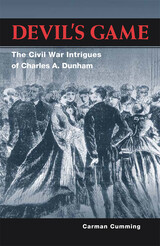 Devil's Game: The Civil War Intrigues of Charles A. Dunham
Carman Cumming
University of Illinois Press, 2003 The first book-length study of one of the Civil War's most outlandish and mysterious characters Devil's Game traces the amazing career of Charles A. Dunham, Civil War spy, forger, journalist, and master of dirty tricks. Writing for a variety of New York papers under alternate names, Dunham routinely faked stories, created new identities, and later boldly cast himself to play those roles. He achieved his greatest infamy when he was called to testify in Washington concerning Abraham Lincoln's assassination. Many parts of Dunham's career remain shadowy, but Cumming offers the first detailed tour of Dunham's convoluted, high-stakes, international deceits, including his effort to sell Lincoln on plans for a raid to capture Jefferson Davis. Exhaustively researched and unprecedented in depth, this carefully crafted assessment of Dunham's motives, personality, and the complex effects of his schemes changes assumptions about covert operations during the Civil War.
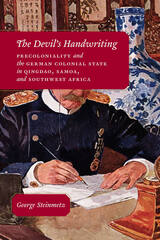 The Devil's Handwriting: Precoloniality and the German Colonial State in Qingdao, Samoa, and Southwest Africa
George Steinmetz
University of Chicago Press, 2007 Germany’s overseas colonial empire was relatively short lived, lasting from 1884 to 1918. During this period, dramatically different policies were enacted in the colonies: in Southwest Africa, German troops carried out a brutal slaughter of the Herero people; in Samoa, authorities pursued a paternalistic defense of native culture; in Qingdao, China, policy veered between harsh racism and cultural exchange.
Why did the same colonizing power act in such differing ways? In The Devil’s Handwriting, George Steinmetz tackles this question through a brilliant cross-cultural analysis of German colonialism, leading to a new conceptualization of the colonial state and postcolonial theory. Steinmetz uncovers the roots of colonial behavior in precolonial European ethnographies, where the Hereros were portrayed as cruel and inhuman, the Samoans were idealized as “noble savages,” and depictions of Chinese culture were mixed. The effects of status competition among colonial officials, colonizers’ identification with their subjects, and the different strategies of cooperation and resistance offered by the colonized are also scrutinized in this deeply nuanced and ambitious comparative history.
Devils Hole Pupfish: The Unexpected Survival of an Endangered Species in the Modern American West
Kevin C. Brown
University of Nevada Press, 2021 The Devils Hole pupfish is one of the rarest vertebrate animals on the planet; its only natural habitat is a ten-by-sixty-foot pool near Death Valley, on the Nevada—California border. Isolation in Devils Hole made the fish different from its close genetic relatives, but as Devils Hole Pupfish explores, what has made the species a survivor is its many surprising connections to the people who have studied, ignored, protested or protected it.
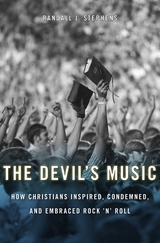 The Devil’s Music: How Christians Inspired, Condemned, and Embraced Rock ’n’ Roll
Randall J. Stephens
Harvard University Press, 2018 When rock ’n’ roll emerged in the 1950s, ministers denounced it from their pulpits and Sunday school teachers warned of the music’s demonic origins. The big beat, said Billy Graham, was “ever working in the world for evil.” Yet by the early 2000s Christian rock had become a billion-dollar industry. The Devil’s Music tells the story of this transformation.
Rock’s origins lie in part with the energetic Southern Pentecostal churches where Elvis, Little Richard, James Brown, and other pioneers of the genre worshipped as children. Randall J. Stephens shows that the music, styles, and ideas of tongue-speaking churches powerfully influenced these early performers. As rock ’n’ roll’s popularity grew, white preachers tried to distance their flock from this “blasphemous jungle music,” with little success. By the 1960s, Christian leaders feared the Beatles really were more popular than Jesus, as John Lennon claimed.
Stephens argues that in the early days of rock ’n’ roll, faith served as a vehicle for whites’ racial fears. A decade later, evangelical Christians were at odds with the counterculture and the antiwar movement. By associating the music of blacks and hippies with godlessness, believers used their faith to justify racism and conservative politics. But in a reversal of strategy in the early 1970s, the same evangelicals embraced Christian rock as a way to express Jesus’s message within their own religious community and project it into a secular world. In Stephens’s compelling narrative, the result was a powerful fusion of conservatism and popular culture whose effects are still felt today.
 The Devil's Sinkhole
By Bill Wittliff; illustrated by Joe Ciardiello
University of Texas Press, 2016 When last we saw the boy Papa in The Devil’s Backbone, he had finally learned the fate of his missing Momma and his vicious daddy, Old Karl. But hardly has he concluded that quest before another one is upon him. Now a white-haired man with a hangman’s noose around his neck and death in his eye—o’Pelo Blanco—is coming. And he means to hang Papa. In The Devil’s Sinkhole, the master storyteller Bill Wittliff takes us on another enthralling journey through wild and woolly Central Texas in the 1880s. When Papa and his o’amigo Calley Pearsall confront Pelo Blanco before he can ambush Papa, the encounter sets them on a pursuit with a promise of true love at the end, if only they can stay alive long enough for Calley to win the beautiful Pela Rosa, the captive/companion of Pelo Blanco. But before they can even hope to be united with Pela and Annie Oster, Papa’s plucky sweetheart, Papa and Calley have to defeat not only Pelo Blanco but also the evil, murdering Arlon Clavic and deliver Little Missey, the mysterious Wild Woman a’the Navidad, to the safe haven of the Choat farm. With dangers and emergencies around every bend, it’s a rough ride to the Devil’s Sinkhole, where this world and the next come together, bringing Papa and Calley, Pelo Blanco and Arlon to a climax that will leave readers clamoring for the next adventure.
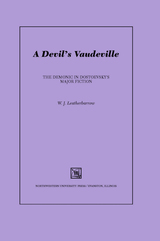 A Devil's Vaudeville: The Demonic in Dostoevsky's Major Fiction
William J. Leatherbarrow
Northwestern University Press, 2005 "Real" demons do rear their heads in Dostoevsky's writing; but what of the demonic more broadly interpreted such as the unclean forces—so diffuse, ugly, and ubiquitous—found throughout Russian folklore, in Christian demonology, and in the demon-figure of European Romanticism? These are the "demonic markers" that William J. Leatherbarrow traces through Dostoevsky's fiction, with a view to discovering the cultural genealogy, nature, and significance of these inscriptions. Whether found in the voices of particular characters or those of the narrator and implied author, these demonic markers contaminate much of the narrative terrain of Dostoevsky's major fiction. They also, as Dostoevsky scholar Leatherbarrow clearly demonstrates, function as a coherent semiotic system and serve as a rhetoric through which that fiction mediates its most pressing ideological and artistic concerns.
In fresh, often surprising readings of Dostoevsky's individual works, Leatherbarrow shows how such a "language" articulates a series of concerns linked to views expressed elsewhere—in Dostoevsky's journalism and letters—on the question of Russia's relationship to Western Europe. His study also explores the narrative and generic implications of the way Dostoevsky inscribes the demonic in his fictional works—implications that point to a new understanding of familiar concepts in the work of this Russian master. Highly original, deftly argued and written, Leatherbarrow's work offers Dostoevsky specialists and general readers alike an opportunity to rediscover and reassess the rich complexities of some of the world's greatest literature.
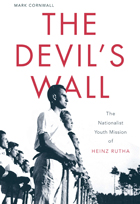 The Devil’s Wall: The Nationalist Youth Mission of Heinz Rutha
Mark Cornwall
Harvard University Press, 2012 Legend has it that twenty miles of volcanic rock rising through the landscape of northern Bohemia was the work of the devil, who separated the warring Czechs and Germans by building a wall. The nineteenth-century invention of the Devil’s Wall was evidence of rising ethnic tensions. In interwar Czechoslovakia, Sudeten German nationalists conceived a radical mission to try to restore German influence across the region. Mark Cornwall tells the story of Heinz Rutha, an internationally recognized figure in his day, who was the pioneer of a youth movement that emphasized male bonding in its quest to reassert German dominance over Czech space.
Through a narrative that unravels the threads of Rutha’s own repressed sexuality, Cornwall shows how Czech authorities misinterpreted Rutha’s mission as sexual deviance and in 1937 charged him with corrupting adolescents. The resulting scandal led to Rutha’s imprisonment, suicide, and excommunication from the nationalist cause he had devoted his life to furthering. Cornwall is the first historian to tackle the long-taboo subject of how youth, homosexuality, and nationalism intersected in a fascist environment. The Devil’s Wall also challenges the notion that all Sudeten German nationalists were Nazis, and supplies a fresh explanation for Britain’s appeasement of Hitler, showing why the British might justifiably have supported the 1930s Sudeten German cause. In this readable biography of an ardent German Bohemian who participated as perpetrator, witness, and victim, Cornwall radically reassesses the Czech-German struggle of early twentieth-century Europe.
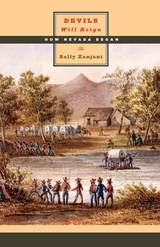 Devils Will Reign: How Nevada Began
Sally Zanjani
University of Nevada Press, 2007 Nevada entered the Union in 1864 as the thirty-sixth state, a mere two decades after John Charles Frémont and his party undertook the first Euro-American exploration of the Great Basin. However, the intervening years were exceptionally eventful—gold was discovered in California in 1848; the debate over slavery in the territories made the Far West a significant topic of congressional concern; and the Mormon establishment in Utah stimulated national suspicion of the sect’s ambitions and policies—giving this remote, sparsely populated region on the eastern slope of the Sierra Nevada an importance that it probably would not have had in less turbulent times. In 1849, more than 22,000 people traveled the emigrant trails across the Great Basin, and soon Mormons from Utah set up a trading station in the Carson Valley to reap profit from the emigrant trade and anchor the western periphery of what their leader, Brigham Young, envisioned as a Mormon inland empire. Miners in Gold Canyon (just south of what is now Virginia City) and settlers in the Carson Valley were pushing the Native Americans out of their ancient homelands and vying with one another for control of choice land and rudimentary local governments. In Devils Will Reign, acclaimed historian Sally Zanjani recounts the momentous early history of the territory that is now known as Nevada, weaving the colorful saga of this rowdy frontier into the larger story of national political crises and economic ambitions, rapid development in California, and religious antipathy toward the polygamous Mormons. Here are intrepid frontiersmen, beleaguered Native Americans, zealous Mormons, and colorful characters and farmers, including a group of African Americans who successfully settled in the Carson Valley. Zanjani covers the lives of the pioneers, as well as the development and impact of the Comstock silver bonanza and the tenuous, halting efforts of the region’s residents to create first a territorial, then a state government. Seldom has the process of western settlement and government-making been described with such detail and insight.
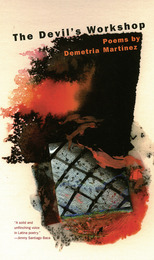 The Devil's Workshop: Poems
Demetria Martínez
University of Arizona Press, 2002 "I can no more describe love," writes Demetria Martínez, "than mystics can light."
Don't believe it for a minute. In this collection of fifty-three poems, the author of the award-winning novel Mother Tongue explores the themes that have long characterized her writing: the creative and destructive powers of romantic love, the failure of political systems, the spiritual life, and the need to forgive oneself in order to move on with the work of transformation, both social and personal. Through poems that confront mortality even as they demand social justice, Martínez writes of surviving in a culture where traditional values often get lost in the complexities of everyday life. Of nurturing relationships with nieces, nephews, and parents while pondering questions of life and death, love and loss. Of caring for one's own body when "each cough is an underground nuclear explosion, / Unraveling your body’s hard-won peace accord." Martínez cauterizes old wounds inflicted by various agents: death, political repression, betrayal, and of course failed romance: "Don’t bother, I did it / First. Broke my own / Damn heart." Here are "kernels of loneliness too stubborn to grind / Down to blue meal," and the struggle for a renewed sense of self as middle age approaches:
At this age you touch what little sanctity you can muster.
The yearning burns to do more, to do more by hand.
To thread your very life through a needle's eye.
Martínez serves up a heady blend of political and sensual imagery. Her keen observations and compassionate voice lead the reader on a journey of self-exploration, of coping with life's mundanities as well as its heartaches: "I could use a loving word, / A loaf of bread, a rose, / Help with the laundry." Through her unquenchable passion for life, Demetria Martínez leaves the devil’s workshop and brings us closer to an understanding of what is real.
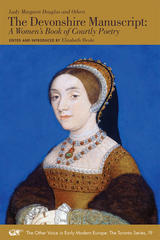 The Devonshire Manuscript: A Women's Book of Courtly Poetry
Lady Margaret Douglas and Others
Iter Press, 2012 This is an essential volume, and there’s no scholar better equipped to edit it than Elizabeth Heale, whose expertise on early women’s writing in manuscript is unsurpassed. The Devonshire Manuscript is a vital source of Tudor literary history, illustrating the circulation of lyrics by Tudor poets such as Sir Thomas Wyatt, and offering evidence of collaborative forms of production and circulation that challenge prior assumptions about early forms of authorship, readership, and literary culture more broadly. Yet despite its importance, the Devonshire Manuscript has been all but inaccessible until now. With its extensive notes, thoughtful introduction, and carefully edited text, Heale’s edition will be a valuable reference work for scholars as well as an important textbook for students encountering the Devonshire Manuscript for the first time.
—Jennifer Summit
Professor of English, Stanford University
 Devonte Travels the Sorry Route
T.J. Anderson III
Omnidawn, 2019 Devonte, the eponymous subject of the poems in Devonte Travels the Sorry Route, has a gift: he can travel across space and time. This extraordinary quality brings Devonte into contact with a broad array of events and phenomena from black history and culture. Unlike most of us, who perceive of history as a sequence of fleeting events, Devonte is able to experience all of his diverse travels to varied historical epochs and places simultaneously, and in doing so is able to become a “stalker of history,” chasing down the elusive narratives that have been erased or ignored by the building of empires and the destruction of ecosystems.
As fantastical as this account seems, in these poems, T.J. Anderson III captures a critical aspect of the ways identity is formed through community and collective memory, particularly among the peoples of the African diaspora. The way the words expand across the page enacts this polyvocal coalescing, and the blank space in between evokes the vast oceans that first separated and continue to resonate in the collective imagination of the Black community. At the same time that he relates the difficulty of crossing vast expanses of time and space to connect with our history, in these gripping poems Anderson proposes that the past is never far off—in fact, like Devonte, it lives in our own personalities and experiences today.
 Devotion in Motion: Pilgrimage in Modern Mexico
Edward Wright-Ríos
University of Chicago Press, 2025 A study of contemporary pilgrimage through the elastic history of a shrine in Oaxaca, Mexico.
For many, pilgrimage conjures ideas about ancient traditions and somber journeys of self-discovery—an escape from modern life. In Devotion in Motion, Edward Wright-Ríos argues that we misunderstand pilgrimage (past and present) if we ignore its dynamic relationship with the rhythms of daily life and community.
Through the story of a centuries-old, ever-changing Catholic shrine to Our Lady of Juquila in Oaxaca, Mexico, Wright-Ríos reveals how tradition, innovation, marketing, and devotion coexist and interact in pilgrimage. Devotees, he shows, are not dissuaded by the embeddedness of the sacred site in the complexities, hierarchies, or conflicts of their lives. In fact, the truckers, accountants, and health-care workers we meet in this book actively seek new resources (including social media) to aid and share their devotion. Part microhistory, part ethnography, Devotion in Motion is a celebration of pilgrimage as a living experience in every generation.
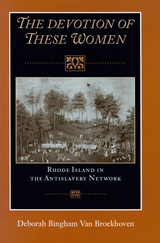 Devotion of These Women: Rhode Island in the Antislavery Network
Deborah B. Van Broekhoven
University of Massachusetts Press, 2009 During the 1830s, the small state of Rhode Island flourished as a center of radical abolitionism. Inspired by William Lloyd Garrison's call for immediate emancipation, some twenty-five anti-slavery societies were formed under the leadership of the African American communities in Providence and Newport, several energetic Baptist and Congregational clergymen, and the wealthy elder statesman of the New England Friends, Moses Brown.
Despite the efforts of these groups, by 1842 the antislavery movement in Rhode Island was nearly moribund, the unified hopes of earlier years having fallen victim to political wrangling. A year later the largest auxiliary in the state, the Providence Antislavery Society, turned its funds over to Amarancy Paine, who in concert with other women not only revived the abolitionist movement in the state but kept it running for another ten years.
This detailed study explores how and why women like Paine emerged from the background to resuscitate and lead the antislavery cause in Rhode Island. It suggests that women more than men were accustomed to working behind the scenes, informally and without much public recognition.
The crumbling of the male-centered organization revealed a previously invisible female-based structure of personal ties on which leaders were able to build the Rhode Island State Anti-Slavery Society. Because these informal ties crossed traditional racial, geographic, and gender-role boundaries, they were often tenuous and fragile. Nevertheless, by developing this network among themselves and then extending it to national leaders, a few dedicated women managed to continue a program of antislavery petitioning, meetings, and literature circulation.
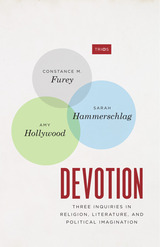 Devotion: Three Inquiries in Religion, Literature, and Political Imagination
Constance M. Furey, Sarah Hammerschlag, and Amy Hollywood
University of Chicago Press, 2021 Three scholars of religion explore literature and the literary as sites of critical transformation.
We are living in a time of radical uncertainty, faced with serious political, ecological, economic, epidemiological, and social problems. Scholars of religion Constance M. Furey, Sarah Hammerschlag, and Amy Hollywood come together in this volume with a shared conviction that what and how we read opens new ways of imagining our political futures and our lives.
Each essay in this book suggests different ways to characterize the object of devotion and the stance of the devout subject before it. Furey writes about devotion in terms of vivification, energy, and artifice; Hammerschlag in terms of commentary, mimicry, and fetishism; and Hollywood in terms of anarchy, antinomianism, and atopia. They are interested in literature not as providing models for ethical, political, or religious life, but as creating the site in which the possible—and the impossible—transport the reader, enabling new forms of thought, habits of mind, and ways of life. Ranging from German theologian Martin Luther to French-Jewish philosopher Sarah Kofman to American poet Susan Howe, this volume is not just a reflection on forms of devotion and their critical and creative import but also a powerful enactment of devotion itself.
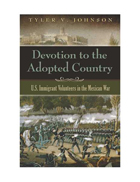 Devotion to the Adopted Country: U.S. Immigrant Volunteers in the Mexican War
Tyler V. Johnson
University of Missouri Press, 2012 In Devotion to the Adopted Country, Tyler V. Johnson looks at the efforts of America’s Democratic Party and Catholic leadership to use the service of immigrant volunteers in the U.S.–Mexican War as a weapon against nativism and anti-Catholicism. Each chapter focuses on one of the five major events or issues that arose during the war, finishing with how the Catholic and immigrant community remembered the war during the nativist resurgence of the 1850s and in the outbreak of the Civil War. Johnson’s book uncovers a new social aspect to military history by connecting the war to the larger social, political, and religious threads of antebellum history. Having grown used to the repeated attacks of nativists upon the fidelity and competency of the German and Irish immigrants flooding into the United States, Democratic and Catholic newspapers vigorously defended the adopted citizens they valued as constituents and congregants. These efforts frequently consisted of arguments extolling the American virtues of the recent arrivals, pointing to their hard work, love of liberty, and willingness to sacrifice for their adopted country. However, immigrants sometimes undermined this portrayal by prioritizing their ethnic and/or religious identities over their identities as new U.S. citizens. Even opportunities seemingly tailor-made for the defenders of Catholicism and the nation’s adopted citizens could go awry. When the supposedly well-disciplined Irish volunteers from Savannah brawled with soldiers from another Georgia company on a Rio Grande steamboat, the fight threatened to confirm the worst stereotypes of the nation’s new Irish citizens. In addition, although the Jesuits John McElroy and Anthony Rey gained admirers in the army and in the rest of the country for their untiring care for wounded and sick soldiers in northern Mexico, anti-Catholic activists denounced them for taking advantage of vulnerable young men to win converts for the Church. Using the letters and personal papers of soldiers, the diaries and correspondence of Fathers McElroy and Rey, Catholic and Democratic newspapers, and military records, Johnson illuminates the lives and actions of Catholic and immigrant volunteers and the debates over their participation in the war. Shedding light on this understudied and misunderstood facet of the war with Mexico, Devotion to the Adopted Country adds to the scholarship on immigration and religion in antebellum America, illustrating the contentious and controversial process by which immigrants and their supporters tried to carve out a place in U.S. society.
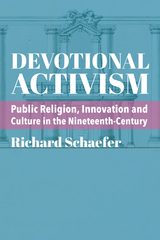 Devotional Activism: Public Religion, Innovation and Culture in the Nineteenth-Century
Richard Schaefer
St. Augustine's Press, 2023 Modern history has not been neutral in telling the story of religion. Since it presumes the centrality of human motives and machinations as the one and only means of explicating the unfolding of ‘events’, it has helped set the terms for what counts as a viable motive and what does not, and this is evident in the systematic unmasking of religion as only really ever about ‘something else’. By distilling more substantive/primary economic, political or other kinds of motives from the detritus of ‘religion’, the latter is thus consigned to the past as the primitive husk of more substantive and rational ways of thinking and acting. As a set of historical case studies, the essays collected here forgo that tendency, and suggest different possibilities for conceptualizing the fate of religion in the modern world. They chart a different course, one of faith and self-assertion.
The essays take up a variety of episodes from modern European and American history and explore, from various angles, three interrelated themes: 'public religion', and the role of Catholicism as a determined critic of modernity; religion as an impetus for innovation; and the tendency to reduce religion to culture.
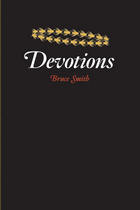 Devotions
Bruce Smith
University of Chicago Press, 2011 In the hands of Bruce Smith, devotions are momentary stops to listen to the motor of history. They are meditations and provocations. They are messages received from the chatter of the street and from transmissions as distant as Memphis and al-Mansur. Bulletins and interruptions come from brutal elsewheres and from the interior where music puts electrodes on the body to take an EKG. These poems visit high schools, laundromats, motels, films, and dreams in order to measure the American hunger and thirst. They are interested in the things we profess to hold most dear as well as what’s unspoken and unbidden. While we’re driving, while riding a bus, while receiving a call, while passing through an X-ray machine, the personal is intersected—sometimes violently, sometimes tenderly—with the hum and buzz of the culture. The culture, whether New York or Tuscaloosa, Seattle or Philadelphia, past or present, carries the burden of race and “someone’s idea of beauty.” The poems fluctuate between the two poles of “lullaby and homicide” before taking a vow to remain on earth, to look right and left, to wait and to witness.
Devotions Upon Emergent Occasions: Together with Death's Duel
John Donne
University of Michigan Press, 1959 Devotions upon Emergent Occasions: Together with Death's Duel is a profound collection of meditations and sermons by John Donne that reflect on the human condition, mortality, and spirituality. Written during a severe illness in 1623, the Devotions are a series of reflections that combine Donne's experience of personal anguish with deep theological insights. He explores themes of suffering, divine intervention, and redemption. In addition, Death's Duel, often considered Donne's final sermon before his death, serves as a poignant and eloquent meditation on the inevitability of death and the promise of eternal life. Together, these writings offer readers a timeless contemplation of life, faith, and death.
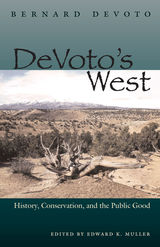 DeVoto’s West: History, Conservation, and the Public Good
Bernard DeVoto
Ohio University Press, 2005 Social commentator and preeminent Western historian Bernard DeVoto vigorously defended public lands in the West against commercial interests. At his death in 1955, DeVoto had won both the Pulitzer and Bancroft prizes. But he was most famous for his eloquent writing that advocated conservation of America's prairies, rangeland, forests, mountains, canyons, and deserts.DeVoto's West: Essays on History, Conservation, and the Public Good showcases the complexity, depth, and breadth of DeVoto's thinking. Editor Edward K. Muller introduces these twenty-two essays (many of which originally appeared in Harper's renowned column The Easy Chair) that passionately and coherently advocate federal control for vast tracts of public land. DeVoto addressed many issues, including the plundering of resources by absentee eastern corporations, Westerners' conflicted relationship to exploitation, and the degradation of the national parks. He believed that conservation of natural resources in the West required government control of public lands against livestock associations, timber interests, and their congressional allies who plotted the privatization of the national forests and the extraction of resources in the national parks.DeVoto's West collects the best of DeVoto's conservation pieces for the first time. It will introduce a new generation to prose that has retained its relevance and remains a remarkably current and timely argument for protecting public lands. Bernard DeVoto was born in Ogden, Utah, in 1897. He spent his adult life in the East, first teaching English at Northwestern University, Chicago, then living in New York, and finally settling in Cambridge, Massachusetts. He is the subject of an acclaimed biography, The Uneasy Chair, by Wallace Stegner.
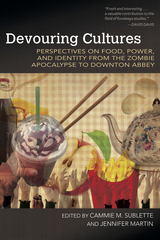 Devouring Cultures: Perspectives on Food, Power, and Identity from the Zombie Apocalypse to Downton Abbey
Cammie M. Sublette
University of Arkansas Press, 2016 Devouring Cultures brings together contributors from a wide range of disciplines including media studies, rhetoric, gender studies, philosophy, anthropology, literary criticism, film criticism, race theory, history, and linguistics to examine the ways food signifies both culture and identity. These scholars look for answers to intriguing questions: What does our choice of dining house say about our social class? Can restaurants teach us about a culture? How does food operate in Downton Abbey? How does food consumption in zombie apocalypse films and apocalyptic literature relate to contemporary food-chain crises and food nostalgia? What aspects of racial conflict, assimilation, and empowerment may be represented in restaurant culture and food choice? Restaurants, from their historical development to their modern role as surrogate kitchen, are studied as markers of gender, race, and social class, and also as forums for the exhibition of tensions or spaces where culture is learned through the language of food. Food, as it is portrayed in literature, movies, and television, is illuminated as a platform for cultural assimilation, a way for the oppressed to find agency, or even a marker for the end of a civilization. The essays in Devouring Cultures show how our choices about what we eat, where we eat, and with whom we eat are linked to identity and meaning and how the seemingly simple act of consumption has implications that extend far beyond sustenance.
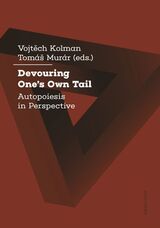 Devouring One's Own Tail: Autopoiesis in Perspective
Edited by Vojtech Kolman and Tomáš Murár
Karolinum Press, 2022 Drawing on continental philosophy, Devouring One’s Own Tail examines culture and society as a type of ouroboros.
Inspired by Niklas Luhmann’s theories on social systems, this book examines the concept of autopoiesis, or self-creation, as it relates to society and culture. Approaching the concept from a variety of fields—philosophy, philology, aesthetics, linguistics, archaeology, and religious and media studies—the contributors present the products of humanity as self-referential, self-sustaining, and self-creating systems. Through four sections, the book addresses the philosophical concept of autopoiesis and its relations to creativity, destruction, and self-organization; autopoiesis in literature and art history; autopoiesis in religion; and autopoiesis in historiography, cognitive linguistics, and social media. Whether exploring Hegel’s theory of knowledge or the viral spread of conspiracy theories on the internet, the authors concentrate on the ouroboros-like nature of their subjects in the ways they feed off of themselves.
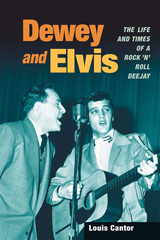 Dewey and Elvis: The Life and Times of a Rock 'n' Roll Deejay
Louis Cantor
University of Illinois Press, 2010 Beginning in 1949, while Elvis Presley and Sun Records were still virtually unknown--and two full years before Alan Freed famously "discovered" rock 'n' roll--Dewey Phillips brought the budding new music to the Memphis airwaves by playing Howlin' Wolf, B. B. King, and Muddy Waters on his nightly radio show Red, Hot and Blue. The mid-South's most popular white deejay, "Daddy-O-Dewey" soon became part of rock 'n' roll history for being the first major disc jockey to play Elvis Presley and, subsequently, to conduct the first live, on-air interview with the singer. Louis Cantor illuminates Phillips's role in turning a huge white audience on to previously forbidden race music. Phillips's zeal for rhythm and blues legitimized the sound and set the stage for both Elvis's subsequent success and the rock 'n' roll revolution of the 1950s. Using personal interviews, documentary sources, and oral history collections, Cantor presents a personal view of the disc jockey while restoring Phillips's place as an essential figure in rock 'n' roll history.
 The Dewey Experiment in China: Educational Reform and Political Power in the Early Republic
Barry Keenan
Harvard University Press, 1977 After the May Fourth Incident, John Dewey’s followers in China assumed the leadership of an important group of intellectuals who were largely veterans of the New Culture movement. The Chinese Communist movement had its inception in the same two years Dewey lectured in China (1919–1921); Dewey’s followers pitted their “liberalism” against this new radical alternative, in arguments that proved to be harbingers of a thirty-year conflict in Chinese politics.
The Dewey Experiment in China critically analyzes the careers and writings of John Dewey’s followers through the 1920s—particularly Kuo Ping-wen, Chiang Meng-lin, and T’ao Hsing-chih—as they attempted to implement Dewey’s political reform ideas and his progressive educational principles. The “new education” reform movement was spearheaded by Deweyites and directed a national-level educational reform effort for many years following World War I. Many of Dewey’s ideas that seemed most progressive in the United States are shown to be surprisingly conservative for China. The promise of progress implicit in problem-solving based upon conflicts in actual, concrete social conditions, as Dewey formulated it, deluded its proponents with a false hope of efficacy. The issue of political power was not adequately addressed. In education, unspoken assumptions about progressive reform in the United States proved to be absent in China.
The most dedicated Deweyites were forced to “turn Dewey on his head” by the end of the 1920s. What appeared to Dewey to be democracy through interest-group bartering among nations was often understood in “Third World” China as Big Power politics and the exploitation of the weak. The Dewey Experiment in China reflects, therefore, not only upon Dewey’s own thought but upon the fragility of many American ideas assumed to have been applicable again after World War II in China and Southeast Asia.
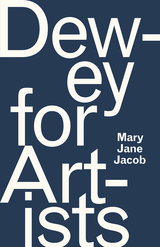 Dewey for Artists
Mary Jane Jacob
University of Chicago Press, 2018 John Dewey is known as a pragmatic philosopher and progressive architect of American educational reform, but some of his most important contributions came in his thinking about art.
Dewey argued that there is strong social value to be found in art, and it is artists who often most challenge our preconceived notions. Dewey for Artists shows us how Dewey advocated for an “art of democracy.” Identifying the audience as co-creator of a work of art by virtue of their experience, he made space for public participation. Moreover, he believed that societies only become—and remain—truly democratic if its citizens embrace democracy itself as a creative act, and in this he advocated for the social participation of artists.
Throughout the book, Mary Jane Jacob draws on the experiences of contemporary artists who have modeled Dewey’s principles within their practices. We see how their work springs from deeply held values. We see, too, how carefully considered curatorial practice can address the manifold ways in which aesthetic experience happens and, thus, enable viewers to find greater meaning and purpose. And it is this potential of art for self and social realization, Jacob helps us understand, that further ensures Dewey’s legacy—and the culture we live in.
Dewey, Russell, Whitehead: Philosophers as Educators
Brian Patrick Hendley
Southern Illinois University Press, 1986 In Philosophers as Educators Brian Patrick Hendley argues that philosophers of education should reject their preoccupation with defining terms and analyzing concepts and embrace the philosophical task of constructing general theories of education. Hendley discusses in detail the educational philosophies of John Dewey, Bertrand Russell, and Alfred North Whitehead. He sees in these men excellent role models that contemporary philosophers might well follow. Hendley believes that, like these mentors, philosophers should take a more active, practical role in education. Dewey and Russell ran their own schools, and Whitehead served as a university administrator and as a member of many committees created to study education.
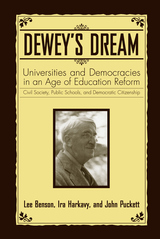 Dewey's Dream: Universities and Democracies in an Age of Education Reform
Lee Benson
Temple University Press, 2007 This timely, persuasive, and hopeful book reexamines John Dewey's idea of schools, specifically community schools, as the best places to grow a democratic society that is based on racial, social, and economic justice. The authors assert that American colleges and universities bear a responsibility for-and would benefit substantially from-working with schools to develop democratic schools and communities. Dewey's Dream opens with a reappraisal of Dewey's philosophy and an argument for its continued relevance today. The authors-all well-known in education circles-use illustrations from over 20 years of experience working with public schools in the University of Pennsylvania's local ecological community of West Philadelphia, to demonstrate how their ideas can be put into action. By emphasizing problem-solving as the foundation of education, their work has awakened university students to their social responsibilities. And while the project is still young, it demonstrates that Dewey's "Utopian ends" of creating optimally participatory democratic societies can lead to practical, constructive school, higher education and community change, development, and improvement.
 Dewey's Empirical Theory of Knowledge and Reality
John R. Shook
Vanderbilt University Press, 2000 The ongoing revival of interest in the work of American philosopher and pragmatist John Dewey has given rise to a burgeoning flow of commentaries, critical editions, and reevaluations of Dewey's writings. While previous studies of Dewey's work have taken either a historical or a topical focus, Shook offers an innovative, organic approach to understanding Dewey and eloquently shows that Dewey's instrumentalism grew seamlessly out of his idealism. He argues that most current scholarship operates under a mistaken impression of Dewey's early philosophical positions and convincingly demonstrates a number of key points: that Dewey's metaphysical empiricism remained more indebted to Kant and Hegel than is commonly supposed;
that Dewey owed more to the influence of Wundt than is commonly believed;
that the influence of Peirce and James was not as significant for the development of Dewey's theories of mind and truth as has been argued in the past;
and that Dewey's pragmatic theory of knowledge never really abandoned idealism. Shook's exposition of the unity of Dewey's thought challenges a large scholarly industry devoted to suppressing or explaining away the consistency between Dewey's early thought and his later work. In every respect, Dewey's Empirical Theory of Knowledge and Reality is a provocative and engaging study that will occupy a unique niche in this field. It is certain to stimulate discussion and controversy, forcing Dewey traditionalists out of habitual modes of thought and transforming our conventional understanding of the development of classical American philosophy.
 Dewey's Logical Theory: New Studies and Interpretations
F. Thomas Burke
Vanderbilt University Press, 2002 Despite the resurgence of interest in the philosophy of John Dewey, his work on logical theory has received relatively little attention. Ironically, Dewey's logic was his "first and last love." The essays in this collection pay tribute to that love by addressing Dewey's philosophy of logic, from his work at the beginning of the twentieth century to the culmination of his logical thought in the 1938 volume, Logic: The Theory of Inquiry. All the essays are original to this volume and are written by leading Dewey scholars. Ranging from discussions of propositional theory to logic's social and ethical implications, these essays clarify often misunderstood or misrepresented aspects of Dewey's work, while emphasizing the seminal role of logic to Dewey's philosophical endeavors. This collection breaks new ground in its relevance to contemporary philosophy of logic and epistemology and pays special attention to applications in ethics and moral philosophy.
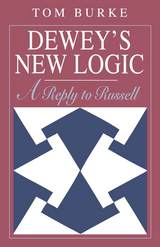 Dewey's New Logic: A Reply to Russell
Tom Burke
University of Chicago Press, 1994 Although John Dewey is celebrated for his work in the philosophy of education and acknowledged as a leading proponent of American pragmatism, he might also have enjoyed more of a reputation for his philosophy of logic had Bertrand Russell not attacked him so fervently on the subject. In Dewey's New Logic, Tom Burke analyzes the debate between Russell and Dewey that followed the 1938 publication of Dewey's Logic: The Theory of Inquiry. Here, he argues that Russell failed to understand Dewey's logic as Dewey intended, and despite Russell's resistance, Dewey's logic is surprisingly relevant to recent developments in philosophy and cognitive science.
Burke demonstrates that Russell misunderstood crucial aspects of Dewey's theory and contends that logic today has progressed beyond Russell and is approaching Dewey's broader perspective.
"[This] book should be of substantial interest not only to Dewey scholars and other historians of twentieth-century philosophy, but also to devotees of situation theory, formal semantics, philosophy of mind, cognitive science, and Artificial Intelligence."—Georges Dicker, Transactions of the C.S. Peirce Society
"No scholar, thus far, has offered such a sophisticated and detailed version of central themes and contentions in Dewey's Logic. This is a pathbreaking study."—John J. McDermott, editor of The Philosophy of John Dewey
Dexterity: A Novel
Douglas Bauer
University of Iowa Press, 2014 Douglas Bauer’s profound and exquisitely written first novel quickly established him as one of America’s best new writers. This is the story of Ed and Ramona, high school lovers who married young. And when Ramona, seeing the ever-clearer reality of life with Ed, turns and walks away from her house, from her life, and from her small baby boy, Ed is stunned into a depth of uncomprehending rage. With a deer hunter’s patience and a maniacal precision, Ed gathers what he needs and, in the dark of early winter, leaves to find his wife.
This darkly poetic novel is imbued with the same tough and tender understanding of the emotional lives of real people that distinguishes Bauer’s subsequent novels, The Very Air and The Book of Famous Iowans.
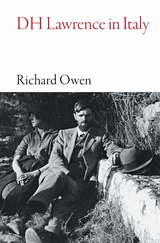 DH Lawrence in Italy
Richard Owen
Haus Publishing, 2014 November 1925: In search of health and sun, the writer D. H. Lawrence arrives on the Italian Riviera with his wife, Frieda, and is exhilarated by the view of the sparkling Mediterranean from his rented villa, set amid olives and vines. But over the next six months, Frieda will be fatally attracted to their landlord, a dashing Italian army officer. This incident of infidelity influenced Lawrence to write two short stories, “Sun” and “The Virgin and the Gypsy,” in which women are drawn to earthy, muscular men, both of which prefigured his scandalous novel Lady Chatterley’s Lover.
In DH Lawrence in Italy, Owen reconstructs the drama leading up to the creation of one of the most controversial novels of all time by drawing on the unpublished letters and diaries of Rina Secker, the Anglo-Italian wife of Lawrence’s publisher. In addition to telling the story of the origins of Lady Chatterley, DH Lawrence in Italy explores Lawrence’s passion for all things Italian, tracking his path to the Riviera from Lake Garda to Lerici, Abruzzo, Capri, Sicily, and Sardinia.
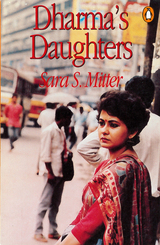 Dharma's Daughters: Contemporary Indian Women and Hindu Culture
Mitter, Sara S
Rutgers University Press, 1991 Women in India today are faced with a major conflict: how to adjust to rapid modernization and industrialization without abandoning traditional roles and customs. One of the assets of Hinduism has been its ability to incorporate seemingly unorthodox ideas, not fight against them. Contemporary Indian women today are trying to reconcile innovation with tradition as they assert that women are significant participants in the economy, that crimes against women should be investigated and prosecuted, and that a woman can divorce her husband. This is no easy task in light of the highly structured nature of Indian society. It is both hierarchical and patriarchal. Regardless of a family's economic position, women in the family are considered inferior. It is the woman's job, first and foremost, to be loyal to her husband and to be a good mother to her children.
Dharma's Daughters is divided into three sections. The first introduces us to women who live and work in Bombay, where the population is dense and the housing is inadequate. We meet manual laborers, members of construction crews, and illiterate domestic workers who live in shanties. Mitter paints a vivid picture of the harried lives of these women. In the second section Mitter describes Hindu mythology and the traditions that form the basis for women's lives. In the final section, Mitter tells of the increasing mobilization and resistance of Indian women since the 1970s.
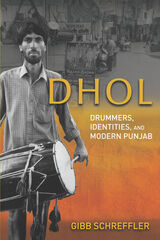 Dhol: Drummers, Identities, and Modern Punjab
Gibb Schreffler
University of Illinois Press, 2021 An icon of global Punjabi culture, the dhol drum inspires an unbridled love for the instrument far beyond its application to regional vernacular music. Yet the identities of dhol players within their local communities and the broadly conceived Punjabi nation remain obscure. Gibb Schreffler draws on two decades of research to investigate dhol's place among the cultural formations within Punjabi communities. Analyzing the identities of musicians, Schreffler illuminates concepts of musical performance, looks at how these concepts help create or articulate Punjabi social structure, and explores identity construction at the intersections of ethnicity, class, and nationality in Punjab and the diaspora. As he shows, understanding the identities of dhol players is an ethical necessity that acknowledges their place in Punjabi cultural history and helps to repair their representation. An engaging and rich ethnography, Dhol reveals a beloved instrumental form and the musical and social practices of its overlooked performers.
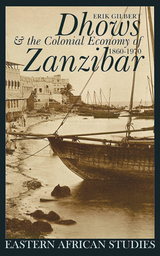 Dhows and the Colonial Economy of Zanzibar, 1860-1970: 1860-1970
Erik Gilbert
Ohio University Press, 2004 Conventional history assumes that the rise of the steamship trade killed off the Indian Ocean dhow trade in the twentieth century. Erik Gilbert argues that the dhow economy played a major role in shaping the economic and social life of colonial Zanzibar. Dhows, and the regional trade they fostered, allowed a class of indigenous entrepreneurs to thrive in Zanzibar. These entrepreneurs, whose economic interests stretched across continents and colonial boundaries, were able to thwart or shape many of the colonial state’s pet projects. Not only did steamships fail to drive out indigenous sailing craft, but in some cases dhows were able to drive the steamer out of specific market niches. In highlighting the role of East Africa’s commercial connections to the Middle East and India during the colonial period, Dhows and the Colonial Economy of Zanzibar, 1860-1970 makes a major contribution to African history as part of world history.
DIA vol 92 num 1-4
The University of Chicago Press
University of Chicago Press Journals, 2018
DIA vol 93 num 1
The University of Chicago Press
University of Chicago Press Journals, 2019
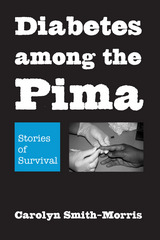 Diabetes among the Pima: Stories of Survival
Carolyn Smith-Morris
University of Arizona Press, 2006 For the past forty years, the Pima Indians living in the Gila River Indian Community have been among the most consistently studied diabetic populations in the world. But despite many medical advances, the epidemic is continuing and prevalence rates are increasing. Diabetes among the Pima is the first in-depth ethnographic volume to delve into the entire spectrum of causes, perspectives, and conditions that underlie the occurrence of diabetes in this community. Drawing on the narratives of pregnant Pima women and nearly ten years’ work in this community, this book reveals the Pimas’ perceptions and understanding of type 2 and gestational diabetes, and their experience as they live in the midst of a health crisis. Arguing that the prenatal period could offer the best hope for curbing this epidemic, Smith-Morris investigates many core values informing the Pimas’ experience of diabetes: motherhood, foodways, ethnic identity, exercise, attitude toward health care, and a willingness to seek care. Smith-Morris contrasts gripping first-person narratives with analyses of several political, economic, and biomedical factors that influence diabetes among the Pimas. She also integrates major theoretical explanations for the disease and illuminates the strengths and weaknesses of intervention strategies and treatment. An important contribution to the ongoing struggle to understand and prevent diabetes, this volume will be of special interest to experts in the fields of epidemiology, genetics, public health, and anthropology. Click here for a Facilitator’s Guide to Diabetes among the Pima
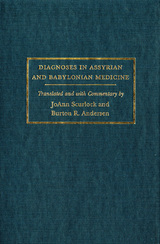 Diagnoses in Assyrian and Babylonian Medicine: Ancient Sources, Translations, and Modern Medical Analyses
Translated and with Commentary by JoAnn Scurlock and Burton R. Andersen
University of Illinois Press, 2005 To date, the pathbreaking medical contributions of the early Mesopotamians have been only vaguely understood. Due to the combined problems of an extinct language, gaps in the archeological record, the complexities of pharmacy and medicine, and the dispersion of ancient tablets throughout the museums of the world, it has been nearly impossible to get a clear and comprehensive view of what medicine was really like in ancient Mesopotamia.
The collaboration of medical expert Burton R. Andersen and cuneiformist JoAnn Scurlock makes it finally possible to survey this collected corpus and discern magic from experimental medicine in Ashur, Babylon, and Nineveh. Diagnoses in Assyrian and Babylonian Medicine is the first systematic study of all the available texts, which together reveal a level of medical knowledge not matched again until the nineteenth century A.D. Over the course of a millennium, these nations were able to develop tests, prepare drugs, and encourage public sanitation. Their careful observation and recording of data resulted in a description of symptoms so precise as to enable modern identification of numerous diseases and afflictions.
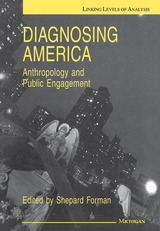 Diagnosing America: Anthropology and Public Engagement
Shepard Forman, Editor
University of Michigan Press, 1995 For years, anthropology has brought the lives and beliefs of "exotic" peoples to audiences in the West. Diagnosing America: Anthropology and Public Engagement reveals the power of anthropological description and analysis when applied to social, economic, and political problems in the contemporary United States and demonstrates the urgent need for this work.
Debunking the notion of anthropology as a "value-free" science, the authors argue forcefully for an anthropology expressly committed to cultural pluralism and democratic participation.
At the same time, individual essays demonstrate the applicability of standard anthropological methods to the study of contemporary U.S. society and culture as they investigate contested values, community politics, middle-class economics, and workplace culture or describe the psychophysiological stress effects of exclusion on African- Americans and the coping mechanisms of Mexican-Americans along the border.
Diagnosing America and the challenging "Statement to the Profession" that concludes it call for anthropologists to reach beyond the parochialism of their own discipline and to engage history, economics, sociology, and the policy sciences. It will be of interest to scholars in each of these fields who are concerned with the study and resolution of contemporary social problems in the United States and to students of American culture in this country and abroad.
Shepard Forman is Director of the International Affairs Program of the Ford Foundation and a former Professor of Anthropology, University of Michigan.
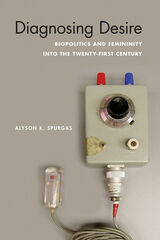 Diagnosing Desire: Biopolitics and Femininity into the Twenty-First Century
Alyson K. Spurgas
Ohio State University Press, 2020 Winner, 2021 Cultural Studies Association First Book Prize
In Diagnosing Desire: Biopolitics and Femininity into the Twenty-First Century, Alyson K. Spurgas examines the “new science of female sexuality” from a critical, sociological perspective, considering how today’s feminist-identified sex researchers study and manage women with low desire. Diagnosing Desire investigates experimental sex research that measures the disconnect between subjective and genital female arousal, contemporary psychiatric diagnoses for low female desire, new models for understanding women’s sexual response, and cutting-edge treatments for low desire in women—including from the realms of mindfulness and alternative healing.
Spurgas makes the case that, together, all of these technologies create a “feminized responsive desire framework” for understanding women’s sexuality, and that this, in fact, produces women’s sexuality as a complex problem to be solved. The biggest problem, Spurgas argues, is that gendered and sexualized trauma—including as it is produced within technoscientific medicine itself—is too often ignored in contemporary renderings. Through incisive textual analysis and in-depth qualitative research based on interviews with women with low desire, Spurgas argues for a more radical and communal form of care for feminized—and traumatized—populations, in opposition to biopolitical mandates to individualize and neoliberalize forms of self-care. Ultimately, this is a book not just about a specific diagnosis or dysfunction but about the material-discursive regimes that produce and regulate femininity.
Diagnosis and Fault Tolerance of Electrical Machines, Power Electronics and Drives
Antonio J. Marques Cardoso
The Institution of Engineering and Technology, 2019 Electrical machines and drives, and their associated power electronics, are a key part of an industrialized society. Reliability is a major challenge in systems design, operation, and maintenance of these technologies. Unreliable systems drive up costs, so diagnostics and fault tolerance become important to help maintain the system and estimate its operational lifetime.
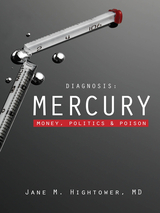 Diagnosis: Mercury: Money, Politics, and Poison
Jane M. Hightower, M.D.
Island Press, 2010 One morning in 2000, Dr. Jane Hightower walked into her exam room to find a patient with disturbing symptoms she couldn’t explain. The woman was nauseated, tired, and had difficulty concentrating, but a litany of tests revealed no apparent cause. She was not alone. Dr. Hightower saw numerous patients with similar, inexplicable ailments, and eventually learned that there were many more around the nation and the world. They had little in common—except a healthy appetite for certain fish.
Dr. Hightower’s quest for answers led her to mercury, a poison that has been plaguing victims for centuries and is now showing up in seafood. But this “explanation” opened a Pandora’s Box of thornier questions. Why did some fish from supermarkets and restaurants contain such high levels of a powerful poison? Why did the FDA base its recommendations for “safe” mercury consumption on data supplied by Saddam Hussein’s Ba’athist extremists? And why wasn’t the government warning its citizens?
In Diagnosis: Mercury, Dr. Hightower retraces her investigation into the modern prevalence of mercury poisoning, revealing how political calculations, dubious studies, and industry lobbyists endanger our health. While mercury is a naturally occurring element, she learns there’s much that is unnatural about this poison’s prevalence in our seafood. Mercury is pumped into the air by coal-fired power plants and settles in our rivers and oceans, and has been dumped into our waterways by industry. It accumulates in the fish we eat, and ultimately in our own bodies. Yet government agencies and lawmakers have been slow to regulate pollution or even alert consumers.
Why? The trail of evidence leads to Canada, Japan, Iraq, and various U.S. institutions, and as Dr. Hightower puts the pieces together, she discovers questionable connections between ostensibly objective researchers and industries that fear regulation and bad press. Her tenacious inquiry sheds light on a system in which, too often, money trumps good science and responsible government. Exposing a threat that few recognize but that touches many, Diagnosis: Mercury should be required reading for everyone who cares about their health.
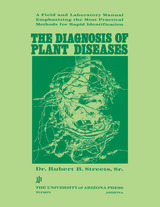 The Diagnosis of Plant Diseases
Rubert B. Streets, Sr.
University of Arizona Press, 1984 The diagnosis of plant ailments is an art. Rapid and accurate diagnosis of plant disease is necessary before timely and proper measures can be suggested for control or prevention, however the scarcity of local, professional practitioners means that plant pathologists at universities are often requested to assist in diagnostic work. Yet the many professional demands of university plant pathologists have left those who encounter plant, crop, and forest problems without qualified individuals to turn to for help.
Drawing on the knowledge, research, and experience of university and industry plant pathologists, this manual will guide everyone—researchers, teachers, personnel from federal and state agencies, plant nursery staff, hobbyist gardeners, or anyone else who works with plants—to better plant-disease work and less time spent in learning diagnostic procedures.
In this manual for rapid and accurate diagnosis, control, and prevention of plant diseases, Dr. Rubert B. Streets has not only developed a practical field and laboratory guide for plant-disease diagnosis, but also articulated a vision for the role of the plant pathologist: a careful observer, a dedicated practitioner who embraces the personal challenge of identifying plant diseases—and a questioner.
With 44 years of distinguished post-doctoral experience in many areas of his field, Dr. Rupert B. Streets, Sr., is best known for his research on the control of Texas root rot in field crops, tree crops, and ornamentals; diseases of dates, citrus, and guar; brown rot of stone fruits and roses; his selection of flax resistance to wilt; the serology of citrus viruses; and the use of antibiotics for the control of crown gall and fire blight. Joining the University of Arizona faculty in 1924, Dr. Streets served for eight years as head of the department of Plant Pathology and taught courses at every level, instructing students on the identification and control of plant diseases.
Diagnosis, Therapy, and Evidence: Conundrums in Modern American Medicine
Grob, Gerald N
Rutgers University Press, 2010 In Diagnosis, Therapy, and Evidence, Gerald N. Grob and Allan V. Horwitz employ historical and contemporary data and case studies, combining into one book a variety of medical and psychiatric conditions. They utilize case studies and examine tonsillectomy, cancer, heart disease, PTSD, anxiety, and depression, and identify differences between rhetoric and reality and the weaknesses in diagnosis and treatment
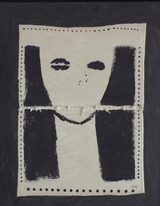 Diago: The Pasts of This Afro-Cuban Present
Alejandro de la Fuente
Harvard University Press A leading member of the new Afro-Cuban cultural movement, visual artist Juan Roberto Diago (b. 1971) has produced a body of work that offers a revisionist history of the Cuban nation. His “history”—a term he frequently inserts in his works using the visual language of graffiti—is not the official narrative of a racially harmonious nation, built thanks to the selfless efforts of generous white patriots. Diago’s Cuba is a nation built on pain, rape, greed, and the enslavement of millions of displaced Africans, a nation still grappling with the long-term effects of slavery and colonialism. To him, slavery is not the past, but a daily experience of racism and discrimination. Africa is not a root, but a wellspring of cultural renovation and personal affirmation, the ancestors that sustain him in his journey.
In the first examination of Diago’s creative work during his entire career, Alejandro de la Fuente provides parallel English- and Spanish-language text, illustrated throughout. The book traces Diago’s singular efforts to construct new pasts—the pasts required to explain the racial tensions of contemporary Cuba and the pasts of this Afro-Cuban present.
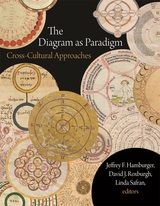 The Diagram as Paradigm: Cross-Cultural Approaches
Jeffrey F. Hamburger
Harvard University Press The Diagram as Paradigm is the first book that looks at medieval diagrams in a cross-cultural perspective, focusing on three regions—Byzantium, the Islamicate world, and the Latin West—each culturally diverse and each closely linked to the others through complex processes of intellectual, artistic, diplomatic, and mercantile exchange.
The volume unites case studies, often of little-known material, by an international set of specialists, and is prefaced by four introductory essays that provide broad overviews of diagrammatic traditions in these regions in addition to considering the theoretical dimensions of diagramming. Among the historical disciplines whose use of diagrams is explored are philosophy, theology, mysticism, music, medicine, mathematics, astronomy, and cosmology. Despite the sheer variety, ingenuity, and visual inventiveness of diagrams from the premodern world, in conception and practical use they often share many similarities, both in construction and application. Diagrams prove to be an essential part of the fabric of premodern intellectual, scientific, religious, artistic, and artisanal life.
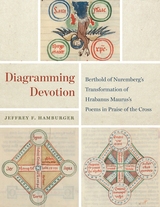 Diagramming Devotion: Berthold of Nuremberg’s Transformation of Hrabanus Maurus’s Poems in Praise of the Cross
Jeffrey F. Hamburger
University of Chicago Press, 2020 During the European Middle Ages, diagrams provided a critical tool of analysis in cosmological and theological debates. In addition to drawing relationships among diverse areas of human knowledge and experience, diagrams themselves generated such knowledge in the first place. In Diagramming Devotion, Jeffrey F. Hamburger examines two monumental works that are diagrammatic to their core: a famous set of picture poems of unrivaled complexity by the Carolingian monk Hrabanus Maurus, devoted to the praise of the cross, and a virtually unknown commentary on Hrabanus’s work composed almost five hundred years later by the Dominican friar Berthold of Nuremberg. Berthold’s profusely illustrated elaboration of Hrabnus translated his predecessor’s poems into a series of almost one hundred diagrams. By examining Berthold of Nuremberg’s transformation of a Carolingian classic, Hamburger brings modern and medieval visual culture into dialogue, traces important changes in medieval visual culture, and introduces new ways of thinking about diagrams as an enduring visual and conceptual model.
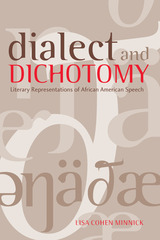 Dialect and Dichotomy: Literary Representations of African American Speech
Lisa Cohen Minnick
University of Alabama Press, 2007 Applies linguistics methods for a richer understanding of literary texts and spoken language. Dialect and Dichotomy outlines the history of dialect writing in English and its influence on linguistic variation. It also surveys American dialect writing and its relationship to literary, linguistic, political, and cultural trends, with emphasis on African American voices in literature. Furthermore, this book introduces and critiques canonical works in literary dialect analysis and covers recent, innovative applications of linguistic analysis of literature. Next, it proposes theoretical principles and specific methods that can be implemented in order to analyze literary dialect for either linguistic or literary purposes, or both. Finally, the proposed methods are applied in four original analyses of African American speech as represented in major works of fiction of the American South—Mark Twain's Adventures of Huckleberry Finn, Charles W. Chesnutt's The Conjure Woman, William Faulkner's The Sound and the Fury, and Zora Neale Hurston's Their Eyes Were Watching God. Dialect and Dichotomy is designed to be accessible to audiences with a variety of linguistic and literary backgrounds. It is an ideal research resource and course text for students and scholars interested in areas including American, African American, and southern literature and culture; linguistic applications to literature; language in the African American community; ethnicity and representation; literary dialect analysis and/or computational linguistics; dialect writing as genre; and American English.
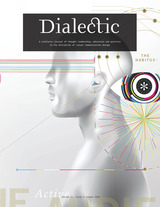 Dialectic: A scholarly journal of thought leadership, education and practice in the discipline of visual communication design - Volume II, Issue I - Summer 2018
Michael R. Gibson
Michigan Publishing, 2018 Dialectic seeks to publish scholarship, analytical study and criticism that will enlighten and inform a diverse audience of design educators engaged not only in classroom teaching experiences but also in differing forms of research and professional practice. The journal's advisory and editorial boards recognize that design education, along with design research and professional practice, exist in relationships that are now broadly informed by theoretical frameworks and applications of knowledge derived from the social and applied sciences, the humanities, and other professions such as business, education, information technology and media studies. The outcomes of these synergies often result in the invention, discovery, understanding, and dissemination of new knowledge, innovation, and best practices.
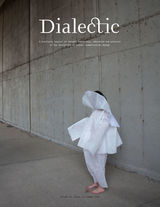 Dialectic: A Scholarly Journal of Thought Leadership, Education and Practice in the Discipline of Visual Communication Design - Volume II, Issue II - Summer 2019
Michael R. Gibson
Michigan Publishing, 2019 Dialectic seeks to publish scholarship, analytical study and criticism that will enlighten and inform a diverse audience of design educators engaged not only in classroom teaching experiences but also in differing forms of research and professional practice. The journal's advisory and editorial boards recognize that design education, along with design research and professional practice, exist in relationships that are now broadly informed by theoretical frameworks and applications of knowledge derived from the social and applied sciences, the humanities, and other professions such as business, education, information technology and media studies. The outcomes of these synergies often result in the invention, discovery, understanding, and dissemination of new knowledge, innovation, and best practices.
Dialectic and Dialogue: Plato's Practice of Philosophical Inquiry
Francisco J. Gonzalez
Northwestern University Press, 1998
Dialectic and Dialogue seeks to define the method and the aims of Plato's dialectic in both the "inconclusive" dialogues and the dialogues that describe and practice a method of hypothesis. Departing from most treatments of Plato, Gonzalez argues that the philosophical knowledge at which dialectic aims is nonpropositional, practical, and reflexive. The result is a reassessment of how Plato understood the nature of philosophy.
 Dialectic and Narrative in Aquinas: An Interpretation of the 'Summa Contra Gentiles'
Thomas S. Hibbs
University of Notre Dame Press, 1995 ". . . A brilliant interpretation of Thomas Aquinas's Summa Contra Gentiles. Hibbs convincingly shows that, contrary to longstanding legend, the Summa is neither a manual for Christian missionaries nor primarily a work of apologetics, but is instead a dialectical confrontation with the newly rediscovered Aristotle and a restatement of the fundamentals of the Christian faith in the light of that confrontation." —Ernest L. Fortin, Boston College
Dialectic and Narrative in Aquinas investigates the intent, method, and structural unity of Thomas Aquinas's Summa Contra Gentiles. In this innovative study Thomas S. Hibbs goes against the grain of most traditional interpretations of the work and argues that the intended audience is Christian and that its subject is Christian wisdom. In the process of making his argument, Hibbs demonstrates that the Summa Contra Gentiles is the most important of Aquinas's texts on the relationship between faith and reason, theology, and philosophy.
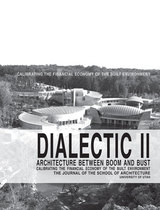 Dialectic II
Shundana The School of Architecture Univ of Utah
University of Utah Press, 2014 Dialectic is the new journal of the School of Architecture at the University of Utah. True to dialectical thinking, the journal brings together opposing voices in the discipline on architectural, urban and wider cultural issues. Deliberately housed within academia, it invites voices from practitioners, scholars and educators to address pedagogy as much as practice. It publishes global perspectives for taking local action. Dialectic is a critical venue for articulating alternative positions on challenges in the highly interconnected, yet tragically disconnected world of contemporary architecture.
The second issue of Dialectic, “Architecture between Boom and Bust,” is dedicated to the question of economy. While the boom of the 1990s and 2000s made architects and media designers the epitome of the urban creative class, the credit crunch and economic downturn of 2008 dramatically shrunk the profession. With the collapse of the U.S. housing market arguably the trigger for global financial and economic crisis, the building industry became a primary victim. All this has directly affected architects, whose fees are linked to building costs and built volume.
Dramatic economic turns, while involving individual hardship, are nevertheless great indices for making visible the immanent connections of the discipline to the marketplace. They challenge our understanding of what it means “to architect.” The history of the architecture profession in the twentieth century bears witness to the attempts of the Modern Movement to bring the elite cultural products to the ordinary person. Architects in the 1960s critiqued the paternalism of their disciplinary forebears and interrogated the role of an architect both as a social engineer and as a moderator of participatory design. The accompanying post-modern turn to semiotics and imagery moved the discipline to the opposite position of “art for art’s sake.” The public learned to expect extravagant signature buildings, formal experiments and endless artistic ingenuity. With this, they traded the role of the architect as a keeper of a common good for a celebrity figure who would bring global fame and tourists to their communities. Now, following the economic downturn in 2008, what may we expect from the next calibration of architecture to society?
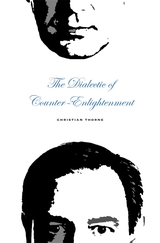 The Dialectic of Counter-Enlightenment
Christian Thorne
Harvard University Press, 2009 In this wide-ranging, ambitious, and engaging study, Christian Thorne confronts the history and enduring legacy of anti-foundationalist thought.
Anti-foundationalism—the skeptical line of thought that contends our beliefs cannot be authoritatively grounded and that most of what passes for knowledge is a sham—has become one of the dominant positions in contemporary criticism. Thorne argues that despite its ascendance, anti-foundationalism is wrong. In The Dialectic of Counter-Enlightenment, he uses deft readings of a range of texts to offer new perspectives on the ongoing clash between philosophy and comprehensive doubt.
The problem with anti-foundationalism is not, as is often thought, that it radiates uncertainty or will unglue the university, but instead that it is a system of thought—with set habits that generate unearned certainties. The shelves are full of histories of modern philosophy, but the history of the resistance to philosophical thought remains to be told. At its heart, The Dialectic of Counter-Enlightenment is a plea not to take doubt at its word—a plea for the return of a vanished philosophical intelligence and for the retirement of an anti-Enlightenment thinking that commits, over and over again, the very crimes that it lays at Enlightenment’s door.
The Dialectical Biologist
Richard Levins and Richard Lewontin
Harvard University Press, 1985 Scientists act within a social context and from a philosophical perspective that is inherently political. Whether they realize it or not, scientists always choose sides. The Dialectical Biologist explores this political nature of scientific inquiry, advancing its argument within the framework of Marxist dialectic. These essays stress the concepts of continual change and codetermination between organism and environment, part and whole, structure and process, science and politics. Throughout, this book questions our accepted definitions and biases, showing the self-reflective nature of scientific activity within society.
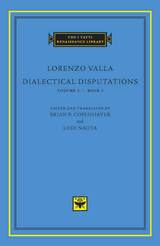 Dialectical Disputations
Lorenzo Valla
Harvard University Press, 2012 Lorenzo Valla (1407–1457) ranks among the greatest scholars and thinkers of the Renaissance. He secured lasting fame for his brilliant critical skills, most famously in his exposure of the “Donation of Constantine,” the forged document upon which the papacy based claims to political power. Lesser known in the English-speaking world is Valla’s work in the philosophy of language—the basis of his reputation as the greatest philosopher of the humanist movement.
Dialectical Disputations, translated here for the first time into any modern language, is his principal contribution to the philosophy of language and logic. With this savage attack on the scholastic tradition of Aristotelian logic, Valla aimed to supersede it with a new logic based on the actual historical usage of classical Latin and on a commonsense approach to semantics and argument. Valla provides a logic that could be used by lawyers, preachers, statesmen, and others who needed to succeed in public debate—one that was stylistically correct and rhetorically elegant, and thus could dispense with the technical language of the scholastics, a “tribe of Peripatetics, perverters of natural meanings.” Valla’s reformed dialectic became a milestone in the development of humanist logic and contains startling anticipations of modern theories of semantics and language.
Volume 1 contains Book I, in which Valla refutes Aristotle’s logical works on the categories, transcendentals, and predicables, with excursions into natural and moral philosophy and theology.
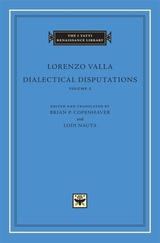 Dialectical Disputations
Lorenzo Valla
Harvard University Press, 2012 Lorenzo Valla (1407–1457) ranks among the greatest scholars and thinkers of the Renaissance. He secured lasting fame for his brilliant critical skills, most famously in his exposure of the “Donation of Constantine,” the forged document upon which the papacy based claims to political power. Lesser known in the English-speaking world is Valla’s work in the philosophy of language—the basis of his reputation as the greatest philosopher of the humanist movement.
Dialectical Disputations, translated here for the first time into any modern language, is his principal contribution to the philosophy of language and logic. With this savage attack on the scholastic tradition of Aristotelian logic, Valla aimed to supersede it with a new logic based on the actual historical usage of classical Latin and on a commonsense approach to semantics and argument. Valla provides a logic that could be used by lawyers, preachers, statesmen, and others who needed to succeed in public debate—one that was stylistically correct and rhetorically elegant, and thus could dispense with the technical language of the scholastics, a “tribe of Peripatetics, perverters of natural meanings.” Valla’s reformed dialectic became a milestone in the development of humanist logic and contains startling anticipations of modern theories of semantics and language.
Volume 2 contains Books II–III, in which Valla refutes Aristotle’s logical works on propositions, topics, and the syllogistic.
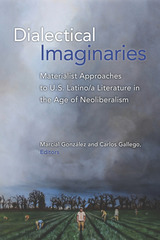 Dialectical Imaginaries: Materialist Approaches to U.S. Latino/a Literature in the Age of Neoliberalism
Marcial González and Carlos Gallego, editors
University of Michigan Press, 2018 Dialectical Imaginaries brings together essays that analyze the effects of class conflict and capitalist ideology on contemporary works of U.S. Latino/a literature. The editors argue that recent global events have compelled contemporary scholars to reexamine traditional interpretive models that center on identity politics and an ethics of multiculturalism. The volume seeks to demonstrate that materialist methodologies have a greater critical reach than other methods, and that Latino/a literary criticism should be more attuned to interpretive approaches that draw on Marxism and other globalizing social theories. The contributors analyze a wide range of literary works in fiction, poetry, drama, and memoir by writers including Rudolfo Anaya, Gloria Anzaldúa, Daniel Borzutzky, Angie Cruz, Sergio de la Pava, Mónica de la Torre, Sergio Elizondo, Juan Felipe Herrera, Rolando Hinojosa, Quiara Alegría Hudes, Lin-Manuel Miranda, Óscar Martínez, Cherríe Moraga, Urayoán Noel, Emma Pérez, Pedro Pietri, Miguel Piñero, Ernesto Quiñónez, Ronald Ruiz, Hector Tobar, Rodrigo Toscano, Alfredo Véa, Helena María Viramontes, and others.
Dialectical Materialism
Henri Lefebvre
University of Minnesota Press, 2009 With the aim of widening the scope of Marxist theory, Henri Lefebvre finished Dialectical Materialism just before the beginning of World War II and the Resistance movement against the Vichy regime. As the culmination of Lefebvre’s interwar activities, the book highlights the tension-fraught relationship between Lefebvre and the French Communist Party (PCF). For Lefebvre, unlike for the PCF, Marxism was above all a dynamic movement of theory and practice. Dialectical Materialism is an implicit response to Joseph Stalin’s Dialectical and Historical Materialism and an attempt to show that the Stalinist understanding of the concept was dogmatic and oversimplified.
This edition contains a new introduction by Stefan Kipfer, explaining the book’s contemporary ramifications in the ever-expanding reach of the urban in the twentieth-century Western world.
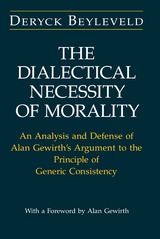 The Dialectical Necessity of Morality: An Analysis and Defense of Alan Gewirth's Argument to the Principle of Generic Consistency
Deryck Beyleveld
University of Chicago Press, 1991 Alan Gewirth's Reason and Morality, in which he set forth the Principle of Generic Consistency, is a major work of modern ethical theory that, though much debated and highly respected, has yet to gain full acceptance. Deryck Beyleveld contends that this resistance stems from misunderstanding of the method and logical operations of Gewirth's central argument. In this book Beyleveld seeks to remedy this deficiency. His rigorous reconstruction of Gewirth's argument gives its various parts their most compelling formulation and clarifies its essential logical structure.
Beyleveld then classifies all the criticisms that Gewirth's argument has received and measures them against his reconstruction of the argument. The overall result is an immensely rich picture of the argument, in which all of its complex issues and key moves are clearly displayed and its validity can finally be discerned.
The comprehensiveness of Beyleveld's treatment provides ready access to the entire debate surrounding the foundational argument of Reason and Morality. It will be required reading for all who are interested in Gewirth's theory and deontological ethics and will be of central importance to moral and legal theorists.
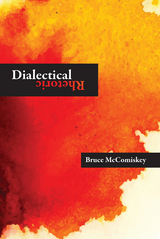 Dialectical Rhetoric
Bruce Mccomiskey
Utah State University Press, 2015 In Dialectical Rhetoric, Bruce McComiskey argues that the historical conflict between rhetoric and dialectic can be overcome in ways useful to both composition theory and the composition classroom.
Historically, dialectic has taken two forms in relation to rhetoric. First, it has been the logical development of linear propositions leading to necessary conclusions, a one-dimensional form that was the counterpart of rhetorics in which philosophical, metaphysical, and scientific truths were conveyed with as little cognitive interference from language as possible. Second, dialectic has been the topical development of opposed arguments on controversial issues and the judgment of their relative strengths and weaknesses, usually in political and legal contexts, a two-dimensional form that was the counterpart of rhetorics in which verbal battles over competing probabilities in public institutions revealed distinct winners and losers.
The discipline of writing studies is on the brink of developing a new relationship between dialectic and rhetoric, one in which dialectics and rhetorics mediate and negotiate different arguments and orientations that are engaged in any rhetorical situation. This new relationship consists of a three-dimensional hybrid art called “dialectical rhetoric,” whose method is based on five topoi: deconstruction, dialogue, identification, critique, and juxtaposition. Three-dimensional dialectical rhetorics function effectively in a wide variety of discursive contexts, including digital environments, since they can invoke contrasts in stagnant contexts and promote associations in chaotic contexts. Dialectical Rhetoric focuses more attention on three-dimensional rhetorics from the rhetoric and composition community.
Dialectical Societies: The Ge and Bororo of Central Brazil
David Maybury-Lewis
Harvard University Press, 1979 The Gê-speaking tribes of Central Brazil have always been an anomaly in the annals of anthropology; their exceedingly simple technology contrasts sharply with their highly complex sociological and ideological traditions. Dialectical Societies, the outgrowth of extended anthropological research organized by David Maybury-Lewis, at long last demystifies Gê social structure while modifying and reinterpreting some of the traditional ideas held about kinship, affiliation, and descent.
Each of the seven contributors deals with a different lowland tribe, butall of them address an ideological focus on the dualistic tribal organization that is here defined as fundamental to the Gê As a collection, their work comprises a substantial revision of the hitherto undeveloped and largely ignored ethnography of Central Brazil.
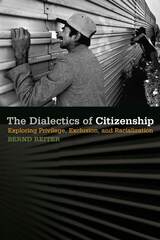 The Dialectics of Citizenship: Exploring Privilege, Exclusion, and Racialization
Bernd Reiter
Michigan State University Press, 2013 What does it mean to be a citizen? What impact does an active democracy have on its citizenry and why does it fail or succeed in fulfilling its promises? Most modern democracies seem unable to deliver the goods that citizens expect; many politicians seem to have given up on representing the wants and needs of those who elected them and are keener on representing themselves and their financial backers. What will it take to bring democracy back to its original promise of rule by the people? Bernd Reiter’s timely analysis reaches back to ancient Greece and the Roman Republic in search of answers. It examines the European medieval city republics, revolutionary France, and contemporary Brazil, Portugal, and Colombia. Through an innovative exploration of country cases, this study demonstrates that those who stand to lose something from true democracy tend to oppose it, making the genealogy of citizenship concurrent with that of exclusion. More often than not, exclusion leads to racialization, stigmatizing the excluded to justify their non-membership. Each case allows for different insights into the process of how citizenship is upheld and challenged. Together, the cases reveal how exclusive rights are constituted by contrasting members to non-members who in that very process become racialized others. The book provides an opportunity to understand the dynamics that weaken democracy so that they can be successfully addressed and overcome in the future.
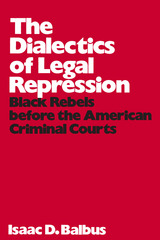 The Dialectics of Legal Repression: Black Rebels Before the American Criminal Courts
Isaac D. Balbus
Russell Sage Foundation, 2015 Less than 2 percent of some 4000 adults prosecuted for participating in the bloodiest ghetto revolt of this generation served any time in jail as a result of their conviction and sentencing. Why? Why, in contrast, did the majority of those arrested following a brief and minor confrontation with police in a different city receive far harsher treatment than ordinarily meted out for comparable offenses in "normal" times? What do these incidents tell us about the nature of legal repression in the American state? No coherent theory of political repression in the liberal state exists today. Neither the liberal view of repression as "anomaly" nor the radical view of repression as "fascist core" appears to come to grips with the distinctive characteristics of legal repression in the liberal state. This book attempts to arrive at a more adequate understanding of these "distinctive characteristics" by means of a detailed analysis of the legal response to the most serious violent challenge to the existing political order since the Great Depression—the black ghetto revolts between 1964 and 1968. Using police and court records, and extensive interviews with judges, defense attorneys, prosecutors, and detention officials, Professor Balbus provides a complete reconstruction of the response of the criminal courts of Los Angeles, Detroit, and Chicago to the "civil disorders" that occurred in these cities. What emerges is a disturbing picture of the relationship between court systems and participants and the local political environments in which they operate.
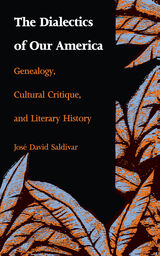 The Dialectics of Our America: Genealogy, Cultural Critique, and Literary History
José David Saldívar
Duke University Press, 1991 Joining the current debates in American literary history, José David Saldívar offers a challenging new perspective on what constitutes not only the canon in American literature, but also the notion of America itself. His aim is the articulation of a fresh, transgeographical conception of American culture, one more responsive to the geographical ties and political crosscurrents of the hemisphere than to narrow national ideologies.
Saldívar pursues this goal through an array of oppositional critical and creative practices. He analyzes a range of North American writers of color (Rolando Hinojosa, Gloria Anzaldúa, Arturo Islas, Ntozake Shange, and others) and Latin American authors (José Martí, Roberto Fernández Retamar, Gabriel García Márquez, and others), whose work forms a radical critique of the dominant culture, its politics, and its restrictive modes of expression. By doing so, Saldívar opens the traditional American canon to a dialog with other voices, not just the voices of national minorities, but those of regional cultures different from the prevalent anglocentric model.
The Dialectics of Our America, in its project to expand the “canon” and define a pan-American literary tradition, will make a critical difference in ongoing attempts to reconceptualize American literary history.
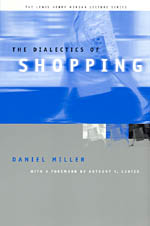 The Dialectics of Shopping
Daniel Miller
University of Chicago Press, 2001 Shopping is generally considered to be a pleasurable activity. But in reality it can often be complicated and frustrating. Daniel Miller explores the many contradictions faced by shoppers on a typical street in London, and in the process offers a sophisticated examination of the way we shop, and what it reveals about our relationships to our families and communities, as well as to the environment and the economy as a whole.
Miller's companions are mostly women who confront these contradictions as they shop. They placate their children with items that combine nutrition with taste or usefulness with style. They decide between shopping at the local store or at the impersonal, but less expensive, mall. They tell of their sympathy for environmental concerns but somehow avoid much ethical shopping. They are faced with a selection of shops whose shifts and mergers often reveal extraordinary stories of their own. Filled with entertaining—and thoroughly familiar—stories of shoppers and shops, this book will interest scholars across a broad range of disciplines.
The Dialects of Ancient Gaul: Prolegomena and Records of the Dialects
Joshua Whatmough
Harvard University Press, 1970 Joshua Whatmough's monumental study of the dialects of Ancient Gaul heretofore has been available only in copies made from microfilm at considerable cost. This new edition makes readily accessible a book of first importance to Keltic scholarship. The work is organized by geographic areas and covers the Alpine Regions, Gallia Narbonensis, Aquitania, Lugdunensis, Belgica, Germania Inferior, Germania Superior, and the Agri Decumates with the Upper Rhine and Danube. There are several appendices, and Whatmough's “Keltika,” originally published in 1944, is included as an introduction.
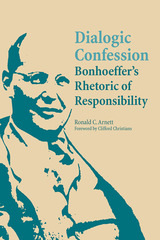 Dialogic Confession: Bonhoeffer's Rhetoric of Responsibility
Ronald C. Arnett. Foreword by Clifford Christians
Southern Illinois University Press, 2005 In this landmark volume of contemporary communication theory, Ronald C. Arnett applies the metaphor of dialogic confession—which enables historical moments to be addressed from a confessed standpoint and through a communicative lens—to the works of German theologian Dietrich Bonhoeffer, who pointed to an era of postmodern difference with his notion of "a world come of age." Arnett’s interpretations of Bonhoeffer’s life and scholarship in contention with Nazi dominance offer implications for a dialogic confession that engages the complexity of postmodern narrative contention. Rooted in classical theory, the field of communication ethics is abstract and arguably outmoded. In Dialogic Confession: Bonhoeffer’s Rhetoric of Responsibility, Arnett locates cross-cultural and comparative anchors that not only bring legitimacy and relevance to the field but also develop a conceptual framework that will advance and inspire future scholarship.
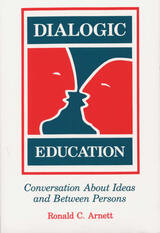 Dialogic Education: Conversation About Ideas and Between Persons
Ronald C. Arnett
Southern Illinois University Press, 1993 Examining undergraduate education from the point of view of a philosopher of communication, Ronald C. Arnett takes a positive view of higher education during a time when education is being assailed as seldom before. Arnett responds to this criticism with convincing support of the academy reinforced by his personal experiences as well as those of others scholars and teachers. Arnett's book is an invitation to converse about higher education as well as a reminder of the potential for dialogue between teacher and student, dialogue that the author defines as a "willingness to enter conversation about ideas," to maintain relationships through differences, and to ask value questions. Arnett see education as more than the dispensing of information. He emphasizes the importance of character development as well as the the development of relationships between students and teachers. Arnett stresses the importance of honesty and integrity in students, teachers, and administrators, and he insists that education should focus more on the good of the entire school than on the individual. Arnett does not offer this book as the truth about education nor as a "how to teach" manual. Rather, he regards it as an attempt to understand education from a communication perspective and as a reminder of the positive and constructive aspects of teaching. The book is based on Arnett's belief that educators who care about ideas and people not only improve education but also benefit the community.
 The Dialogic Emergence of Culture
Dennis Tedlock and Bruce Mannheim
University of Illinois Press, 1995 Major figures in contemporary anthropology present a dialogic critique
of ethnography. Moving beyond sociolinguistics and performance theory,
and inspired by Bakhtin and by their own field experiences, the contributors
revise notions of where culture actually resides. This pioneering effort
integrates a concern for linguistic processes with interpretive approaches
to culture.
Culture and ethnography are located in social interaction. The collection
contains dialogues that trace the entire course of ethnographic interpretation,
from field research to publication. The authors explore an anthropology
that actively acknowledges the dialogical nature of its own production.
Chapters strike a balance between theory and practice and will also be
of interest in cultural studies, literary criticism, linguistics, and
philosophy.
CONTRIBUTORS: Deborah Tannen, John Attinasi, Paul Friedrich, Billie
Jean Isbell, Allan F. Burns, Jane H. Hill, Ruth Behar, Jean DeBernardi,
R. P. McDermott, Henry Tylbor, Alton L. Becker, Bruce Mannheim, Dennis
Tedlock
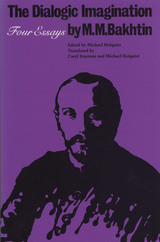 The Dialogic Imagination: Four Essays
By M. M. Bakhtin
University of Texas Press, 1982 These essays reveal Mikhail Bakhtin (1895-1975)—known in the West largely through his studies of Rabelais and Dostoevsky—as a philosopher of language, a cultural historian, and a major theoretician of the novel. The Dialogic Imagination presents, in superb English translation, four selections from Voprosy literatury i estetiki (Problems of literature and esthetics), published in Moscow in 1975. The volume also contains a lengthy introduction to Bakhtin and his thought and a glossary of terminology. Bakhtin uses the category "novel" in a highly idiosyncratic way, claiming for it vastly larger territory than has been traditionally accepted. For him, the novel is not so much a genre as it is a force, "novelness," which he discusses in "From the Prehistory of Novelistic Discourse." Two essays, "Epic and Novel" and "Forms of Time and of the Chronotope in the Novel," deal with literary history in Bakhtin's own unorthodox way. In the final essay, he discusses literature and language in general, which he sees as stratified, constantly changing systems of subgenres, dialects, and fragmented "languages" in battle with one another.
 Dialogic Novels of Malcolm Bradbury and David Lodge
Robert A. Morace
Southern Illinois University Press, 1989 Morace analyzes the novels of Malcolm Bradbury and David Lodge together because they provide a dialogue of conflicting views, styles, and forms of the contemporary novel. This dialogue parallels the views of these two British novelists as critics. Beginning as realists, as novelists of manners, as writers of campus novels, Bradbury and Lodge explore the possibilities and the limitations of realistic writing. Bradbury and Lodge, however, are not only heirs of English literary tradition. Both are also literary critics with a keen interest in recent critical theories. Morace shows us how the debate between Bradbury and Lodge over the nature and purpose of fiction and criticism has found its way into their novels. The realistic conflicts between civilian and military, English and American, pre- and post-Vatican II values gradually give way to an exploration of the semiotics behind such conflicts. Morace finds Bradbury’s and Lodge’s works far more open-ended than the "doggedly indeterminate fictions" of many contemporary writers. Using Mikhail Bakhtin’s theory of dialogism, he identifies the ways in which language and values simultaneously compete with and support one another in their novels. This first book-length study of Bradbury or Lodge deals with all of their novels, including Changing Places, How Far Can You Go?, and Small World by Lodge, as well as Bradbury’s The History of Man and Rates of Exchange.
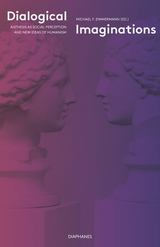 Dialogical Imaginations: Aisthesis as Social Perception and New Ideas of Humanism
Edited by Michael F. Zimmermann with Gernot Müller, Christian Sauer, Kerstin Schmidt, Robert Schmidt, and Fosca Mariani Zini
Diaphanes Whereas language is situated in the communicative zones between subjects, the imagination, according to a widespread prejudice concerning its freedom, is often treated as obscurely originating from the inner self. Instead of focusing on individual or “private” imaginations by means of introspection, the contributors to the volume inquire into the dialogical formations the imagination shares with language, and into social ways of world making.
“Aisthesis” means perception, but, in this volume, as the cover illustration the artist Giulio Paolini made for us demonstrates, it is treated as inscribed into dialogue. Furthermore, the range of its meaning is extended to include societies’ capacities to perceive their own conditions and dispositions—those concerning their inner structures and their external, cultural, and natural contexts. The essays present a wide variety of cultural manifestations of social perception—from the documentary to the fictional. Philosophers and sociologists, literary and art historians, media and film analysts deal with figurations, topoi, and stereotypes as created in various communal spheres and as resulting from media and epistemological practices.
Many of the debates turn around dialogical humanism, but this is certainly not aimed at returning to normative models more regulating than describing the human. Our period has been marked by debates around the post-human, biopolitics, and an increasing awareness of crisis and of global interdependence. Previously, the concept of humanism had been criticized, for good reasons, by Foucault and by philosophers such as Judith Butler. If the editors propose to discuss humanism again, a reevaluation of the dialogical character of humanism—and a reconstruction of its history as marked by dialogical strategies—is the starting point. In dialogical humanism, man, instead of being defined by a system of norms, is and remains an argument—even if, in the final instance, inscrutable, inexhaustible.
 Dialogics of the Oppressed
Peter Hitchcock
University of Minnesota Press, 1992
Dialogics of the Oppressed was first published in 1992. Minnesota Archive Editions uses digital technology to make long-unavailable books once again accessible, and are published unaltered from the original University of Minnesota Press editions.
Formulated within and against the context of Russian formalism that became the backbone of semiotics, Mikhail Bakhtin's work has enabled contemporary critical theories to return to specific sociopolitical and historical moments that had been closed off by formalist abstractions. In Dialogics of the Oppressed, Peter Hitchcock looks through the lens of Bakhtin's theory of dialogism for an analysis of subaltern writing. Rather than assume an integral "subaltern subject" as the object of analysis, Hitchcock - in case studies of four global feminists, Nawal el Saadawi, Pat Barker, Zhang Jie, and Agnes Smedley - emphasizes the cultural agency of the subaltern and shows the political implications this agency might have for literary analysis in general and cultural studies in particular.
"Presents a provocative set of readings-through the Bakhtinian model of dialogism-of texts by four women writers of the twentieth century. . . instructive and compelling." Barbara Harlow, University of Texas
Dialogics of the Oppressed argues from an internationalistic perspective to underline that the heterogeneity of dialogic feminism itself constitutes a significant array of discursive resistance to the hegemony of disciplines and so-called area studies operative in the metropolitan First World academy. Hitchcock demonstrates through dialogic analyses of the writings of these four feminists that a form of multicultural materialism can itself disrupt the restrictive logics and practices of literary studies in the Western academy, and that indeed, there is a counterlogic in the culture of the subaltern. Hitchcock's underlying objective is the development of a powerful critique of the epistemological bases of the academy that marginalize and devalorize certain cultural productions and subjects, as well as a cognitive mapping of the politics of pedagogy in current transformations of disciplinarity.
Peter Hitchcock is professor of English at Baruch College of the City University of New York. He is the author of Working-Class Fiction in Theory and Practice and has published essays on radical writing, multiculturalism, film, and Third World fiction.
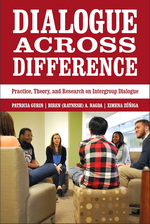 Dialogue Across Difference: Practice, Theory, and Research on Intergroup Dialogue
Patricia Gurin
Russell Sage Foundation, 2013 Due to continuing immigration and increasing racial and ethnic inclusiveness, higher education institutions in the United States are likely to grow ever more diverse in the 21st century. This shift holds both promise and peril: Increased inter-ethnic contact could lead to a more fruitful learning environment that encourages collaboration. On the other hand, social identity and on-campus diversity remain hotly contested issues that often raise intergroup tensions and inhibit discussion. How can we help diverse students learn from each other and gain the competencies they will need in an increasingly multicultural America? Dialogue Across Difference synthesizes three years’ worth of research from an innovative field experiment focused on improving intergroup understanding, relationships and collaboration. The result is a fascinating study of the potential of intergroup dialogue to improve relations across race and gender. First developed in the late 1980s, intergroup dialogues bring together an equal number of students from two different groups – such as people of color and white people, or women and men – to share their perspectives and learn from each other. To test the possible impact of such courses and to develop a standard of best practice, the authors of Dialogue Across Difference incorporated various theories of social psychology, higher education, communication studies and social work to design and implement a uniform curriculum in nine universities across the country. Unlike most studies on intergroup dialogue, this project employed random assignment to enroll more than 1,450 students in experimental and control groups, including in 26 dialogue courses and control groups on race and gender each. Students admitted to the dialogue courses learned about racial and gender inequalities through readings, role-play activities and personal reflections. The authors tracked students’ progress using a mixed-method approach, including longitudinal surveys, content analyses of student papers, interviews of students, and videotapes of sessions. The results are heartening: Over the course of a term, students who participated in intergroup dialogues developed more insight into how members of other groups perceive the world. They also became more thoughtful about the structural underpinnings of inequality, increased their motivation to bridge differences and intergroup empathy, and placed a greater value on diversity and collaborative action. The authors also note that the effects of such courses were evident on nearly all measures. While students did report an initial increase in negative emotions – a possible indication of the difficulty of openly addressing race and gender – that effect was no longer present a year after the course. Overall, the results are remarkably consistent and point to an optimistic conclusion: intergroup dialogue is more than mere talk. It fosters productive communication about and across differences in the service of greater collaboration for equity and justice. Ambitious and timely, Dialogue Across Difference presents a persuasive practical, theoretical and empirical account of the benefits of intergroup dialogue. The data and research presented in this volume offer a useful model for improving relations among different groups not just in the college setting but in the United States as well.
Dialogue against the Jews
Petrus Alfonsi
Catholic University of America Press, 2006 Never before translated into English, this work presents to the reader perhaps the most important source for an intensifying medieval Christian-Jewish debate.
Dialogue at the Margins: Whorf, Bakhtin, and Linguistic Relativity
Emily A. Schultz
University of Wisconsin Press, 1990 The “linguistic relativity principle” of pioneering American linguist Benjamin Whorf has been a focus of controversy among scholars of language for half a century. Many claim that this principle amounts to Whorf’s assertion that language determines thought and culture, while others vigorously reject such a claim. Emily Schultz rereads Whorf in terms of Russian theorist Mikhail Bakhtin, and argues that the Whorfian controversy is rooted in the polyphonic character of his best known texts. By combining Whorfian and Bakhtinian insights concerning variation within and across languages, Schultz offers a new dialogic interpretation of linguistic relativity that has profound implications for students and scholars of anthropology, linguistics, cognitive psychology, philosophy of language, and literary and art criticism.
 A Dialogue between a Philosopher and a Student of the Common Laws of England
Thomas Hobbes
University of Chicago Press, 1997 This little-known late writing of Hobbes reveals an unexplored dimension of his famous doctrine of sovereignty. The essay was first published posthumously in 1681, and from 1840 to 1971 only a generally unreliable edition has been in print. This edition provides the first dependable and easily accessible text of Hobbes's Dialogue. In the Dialogue, Hobbes sets forth his mature reflections of the relation between reason and law, reflections more "liberal" than those found in Leviathan and his other well-known writings. Hobbes proposes a separation of the functions of government in the interest of common sense and humaneness without visibly violating his dictum that the sharing or division of sovereignty is an absurdity. This new edition of the Dialogue is a significant contribution to our understanding of seventeenth-century political philosophy.
"Hobbes students are indebted to Professor Cropsey for this scholarly and accessible edition of Dialogue."—J. Roland Pennock, American Political Science Review
"An invaluable aid to the study of Hobbes."—Review of Metaphysics
Dialogue, Dialectic and Conversation: A Social Perspective on the Function of Writing
Gregory Clark. Foreword by Robert J. Connors
Southern Illinois University Press, 1990 This book articulates an ethics for reading that places primary responsibility for the social influences of a text on the response of its readers. We write and read as participants in a process through which we negotiate with others whom we must live or work with and with whom we share values, beliefs, and actions. Clark draws on current literary theory, rhetoric, philosophy, communication theory, and composition studies as he builds on this argument. Because reading and writing are public actions that address and direct matters of shared belief, values, and action, reading and writing should be taught as public discourse. We should teach not writing or reading so much as the larger practice of public discourse—a discourse that sustains the many important communities of which students are and will be active members.
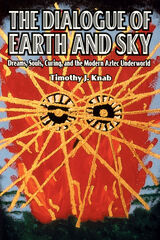 The Dialogue of Earth and Sky: Dreams, Souls, Curing, and the Modern Aztec Underworld
Timothy J. Knab
University of Arizona Press, 2004 In Mexico’s Sierra Norte de Puebla, beliefs that were held before the coming of Europeans continue to guide the lives of modern Aztecs. For residents of San Martín Zinacapan, life in and on the earth is animated by the same forces, through which people seek to maintain a cohesive view of the relationship of mankind, the cosmos, and the natural world. This delicate balance of the human spirit maintains the health and well-being of villagers, and is an essential part of the social and ideological framework that makes a person’s life whole. This book describes the basic elements of a belief system that has survived the onslaught of Catholicism, colonialism, and the modern world. Timothy Knab has spent thirty years working in this area of Mexico, learning of the Most Holy Earth and following what its people there call "the good path." He was initiated as a dreamer, learned the prayers and techniques for curing maladies of the human soul, and from his long association with the Sanmartinos has constructed a thorough account of their beliefs and practices. Learning to recount dreams, forming a dreamtale, and "carrying it on one’s back" to the waking world is the first part of the practitioner’s labor in curing. But dreamtales are shown to be more than parables in this world, for they embody the ethos and cosmovision that link Sanmartinos with their traditions and the Most Holy Earth. Building on this background, Knab describes how the open-ended interpretation of dreams is the practitioner’s primary instrument for restoring a client’s soul to its proper equilibrium, thus providing a practical approach to finding and resolving everyday problems. Many anthropologists hold that such beliefs have long since disappeared into the nebulous past, but in San Martín they remain alive and well. The underworld of the ancestors, talocan or Tlalocan for the Aztecs, is still a vital part of everyday life for the people of the Sierra Norte de Puebla. The Dialogue of Earth and Sky is an important record of a culture that has maintained a precolumbian cosmovision for nearly 500 years, revealing that this system is as resonant today with the ethos of Mesoamerican peoples as it was for their ancestors.
 A Dialogue of Voices: Feminist Literary Theory and Bakhtin
Karen Hohne and Helen Wussow, Editors
University of Minnesota Press, 1994 A Dialogue of Voices was first published in 1994. Minnesota Archive Editions uses digital technology to make long-unavailable books once again accessible, and are published unaltered from the original University of Minnesota Press editions. The work of the Russian theorist Mikhail Bakhtin, particularly his notions of dialogics and genre, has had a substantial impact on contemporary critical practices. Until now, however, little attention has been paid to the possibilities and challenges Bakhtin presents to feminist theory, the task taken up in A Dialogue of Voices. The original essays in this book combine feminism and Bakhtin in unique ways and, by interpreting texts through these two lenses, arrive at new theoretical approaches. Together, these essays point to a new direction for feminist theory that originates in Bakhtin-one that would lead to a feminine être rather than a feminine écriture. Focusing on feminist theorists such as Hélène Cixous, Teresa de Lauretis, Julia Kristeva, and Monique Wittig in conjunction with Bakhtin's concepts of dialogism, heteroglossia, and chronotope, the authors offer close readings of texts from a wide range of multicultural genres, including nature writing, sermon composition, nineteenth-century British women's fiction, the contemporary romance novel, Irish and French lyric poetry, and Latin American film. The result is a unique dialogue in which authors of both sexes, from several countries and different eras, speak against, for, and with one another in ways that reveal their works anew as well as the critical matrices surrounding them. Karen Hohne is an independent scholar and artist living in Moorhead, Minnesota. Helen Wussow is an assistant professor of English at Memphis State University.
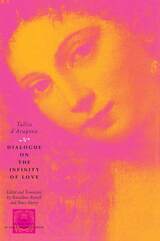 Dialogue on the Infinity of Love
Tullia d'Aragona
University of Chicago Press, 1997 Celebrated as a courtesan and poet, and as a woman of great intelligence and wit, Tullia d'Aragona (1510–56) entered the debate about the morality of love that engaged the best and most famous male intellects of sixteenth-century Italy. First published in Venice in 1547, but never before published in English, Dialogue on the Infinity of Love casts a woman rather than a man as the main disputant on the ethics of love.
Sexually liberated and financially independent, Tullia d'Aragona dared to argue that the only moral form of love between woman and man is one that recognizes both the sensual and the spiritual needs of humankind. Declaring sexual drives to be fundamentally irrepressible and blameless, she challenged the Platonic and religious orthodoxy of her time, which condemned all forms of sensual experience, denied the rationality of women, and relegated femininity to the realm of physicality and sin. Human beings, she argued, consist of body and soul, sense and intellect, and honorable love must be based on this real nature.
By exposing the intrinsic misogyny of prevailing theories of love, Aragona vindicates all women, proposing a morality of love that restores them to intellectual and sexual parity with men. Through Aragona's sharp reasoning, her sense of irony and humor, and her renowned linguistic skill, a rare picture unfolds of an intelligent and thoughtful woman fighting sixteenth-century stereotypes of women and sexuality.
Dialogue: Proceedings of the AIGA Design Educators Community Conferences: Decipher, Vol. 1
Written by AIGA DEC, Edited by Kelly M. Murdoch-Kitt and Omar Sosa-Tzec
Michigan Publishing, 2019 Decipher 2018 was a hands-on design research conference by the AIGA Design Educators Community in partnership with the new DARIA Network (Design as Research in the Americas). The conference brought together 228 people from 12 countries to address crucial themes of defining, doing, disseminating, supporting, and teaching design research. Hosted by the Penny W. Stamps School of Art & Design at the University of Michigan, Decipher: - Connected emerging and experienced design researchers in academia and beyond
- Gathered and shared best practices, resources, tools, and exemplary research matter
- Helped participants hone research plans and writing skills
- Created opportunities for dialogues to foster mentorship and collaborative connections
Dialogue: Proceedings of the AIGA Design Educators Community Conferences: Decipher, Vol. 2
Written by AIGA DEC, Edited by Kelly M. Murdoch-Kitt and Omar Sosa-Tzec
Michigan Publishing, 2019 Decipher 2018 was a hands-on design research conference by the AIGA Design Educators Community in partnership with the new DARIA Network (Design as Research in the Americas). The conference brought together 228 people from 12 countries to address crucial themes of defining, doing, disseminating, supporting, and teaching design research. Hosted by the Penny W. Stamps School of Art & Design at the University of Michigan, Decipher: - Connected emerging and experienced design researchers in academia and beyond
- Gathered and shared best practices, resources, tools, and exemplary research matter
- Helped participants hone research plans and writing skills
- Created opportunities for dialogues to foster mentorship and collaborative connections
Dialogue: Proceedings of the AIGA Design Educators Community Conferences: MAKE
Written by AIGA DEC, Edited by Pamela Napier and Aaron Ganci
Michigan Publishing, 2019 Dialogue is the ongoing series of fully open-access proceedings of the conferences and national symposia of the AIGA Design Educators Community (DEC). Issues of Dialogue contain papers from DEC conferences that focus on topics affecting design education, research, and professional practice, although each conference varies in theme. Michigan Publishing, the hub of scholarly publishing at the University of Michigan, publishes Dialogue on behalf of the AIGA DEC.
Dialogue: Proceedings of the AIGA Design Educators Community Conferences: SHIFT
Written by AIGA DEC, Edited by Liese Zahabi
Michigan Publishing, 2022 Dialogue is the ongoing series of fully open access proceedings of the conferences and national symposia of the AIGA Design Educators Committee. Although each conference varies in theme, issues of Dialogue contain papers from DEC conferences which focus on topics that affect design education, research, and professional practice. Michigan Publishing, the hub of scholarly publishing at the University of Michigan, publishes Dialogue on behalf of the AIGA DEC.
Dialogue: Proceedings of the AIGA Design Educators Community Conferences: SHIFT{ED}
AIGA Design Educators Community (DEC)
Michigan Publishing, 2024 Dialogue is the ongoing series of fully open access proceedings of the conferences and national symposia of the AIGA Design Educators Committee.
Although each conference varies in theme, issues of Dialogue contain papers from DEC conferences which focus on topics that affect design education, research, and professional practice. Michigan Publishing, the hub of scholarly publishing at the University of Michigan, publishes Dialogue on behalf of the AIGA DEC.
Dialogue with Death: The Journal of a Prisoner of the Fascists in the Spanish Civil War
Arthur Koestler
University of Chicago Press, 2011 In 1937 during the Spanish Civil War, Arthur Koestler, a German exile writing for a British newspaper, was arrested by Nationalist forces in Málaga. He was then sentenced to execution and spent every day awaiting death—only to be released three months later under pressure from the British government. Out of this experience, Koestler wrote Darkness at Noon, his most acclaimed work in the United States, about a man arrested and executed in a Communist prison.
Dialogue with Death is Koestler’s riveting account of the fall of Málaga to rebel forces, his surreal arrest, and his three months facing death from a prison cell. Despite the harrowing circumstances, Koestler manages to convey the stress of uncertainty, fear, and deprivation of human contact with the keen eye of a reporter.
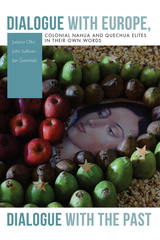 Dialogue with Europe, Dialogue with the Past: Colonial Nahua and Quechua Elites in Their Own Words
Justyna Olko
University Press of Colorado, 2018 Dialogue with Europe, Dialogue with the Past is a critical, annotated anthology of indigenous-authored texts, including the Nahua, Quechua, and Spanish originals, through which native peoples and Spaniards were able to convey their own perspectives on Spanish colonial order. It is the first volume to bring together native testimonies from two different areas of Spanish expansion in the Americas to examine comparatively these geographically and culturally distant realities of indigenous elites in the colonial period.
In each chapter a particular document is transcribed exactly as it appears in the original manuscript or colonial printed document, with the editor placing it in historical context and considering the degree of European influence. These texts show the nobility through documents they themselves produced or caused to be produced—such as wills, land deeds, and petitions—and prioritize indigenous ways of expression, perspectives, and concepts. Together, the chapters demonstrate that native elites were independent actors as well as agents of social change and indigenous sustainability in colonial society. Additionally, the volume diversifies the commonly homogenous term “cacique” and recognizes the differences in elites throughout Mesoamerica and the Andes.
Showcasing important and varied colonial genres of indigenous writing, Dialogue with Europe, Dialogue with the Past reveals some of the realities, needs, strategies, behaviors, and attitudes associated with the lives of the elites. Each document and its accompanying commentary provide additional insight into how the nobility negotiated everyday life. The book will be of great interest to students and researchers of Mesoamerican and Andean history, as well as those interested in indigenous colonial societies in the Spanish Empire.
Contributors: Agnieszka Brylak, Maria Castañeda de la Paz, Katarzyna Granicka, Gregory Haimovich, Anastasia Kalyuta, Julia Madajczak, Patrycja Prządka-Giersz
Dialogues
Saint Gregory the Great
Catholic University of America Press, 1959 No description available
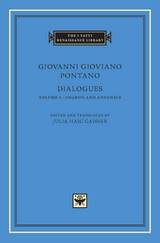 Dialogues
Giovanni Gioviano Pontano
Harvard University Press, 2012 Giovanni Pontano (1426–1503), whose academic name was Gioviano, was the most important Latin poet of the fifteenth century as well as a leading statesman who served as prime minister to the Aragonese kings of Naples. His Dialogues are our best source for the humanist academy of Naples which Pontano led for several decades. They provide a vivid picture of literary life in the capital of the Aragonese seaborne empire, based in southern Italy and the Western Mediterranean. This first volume contains the two earliest of Pontano’s five dialogues. Charon, set in the underworld of classical mythology, illustrates humanist attitudes to a wide range of topics, satirizing the follies and superstitions of humanity. Antonius, a Menippean satire named for the founder of the Neapolitan Academy, Antonio Beccadelli, is set in the Portico Antoniano in downtown Naples, where the academicians commemorate and emulate their recently-deceased leader, conversing on favorite topics and stopping from time to time to interrogate passersby.
This volume contains a freshly-edited Latin text of these dialogues and the first translation of them into English.
 Dialogues
Giovanni Gioviano Pontano
Harvard University Press, 2012 Giovanni Gioviano Pontano (1429–1503) served five kings of Naples as a courtier, official, and diplomat, and earned even greater fame as a scholar, prose author, and poet. His Dialogues reflect his diverse interests in religion, philosophy, and literature, as well as in everyday life in fifteenth-century Naples. They are especially important for their vivid picture of the contemporary gatherings of Pontano and his friends in the humanist academy over which he presided from around 1471 until shortly before his death.
This volume completes the I Tatti edition of Pontano’s five surviving dialogues and features both Aegidius and Asinus. The conversation in Aegidius, named for the Augustinian theologian Giles of Viterbo, ranges over various topics, including creation, dreams, free will, the immortality of the soul, the relation between heaven and earth, language, astrology, and mysticism. The Asinus is less a dialogue than a fantastical autobiographical comedy in which Pontano himself is represented as having gone mad and fallen in love with an ass. This is the first translation of these dialogues into English.
 Dialogues
Giovanni Gioviano Pontano
Harvard University Press, 2012 Giovanni Gioviano Pontano (1429–1503) served five kings of Naples as a courtier, official, and diplomat, and earned even greater fame as a scholar, prose author, and poet. His Dialogues reflect his diverse interests in religion, philosophy, and literature, as well as in everyday life in fifteenth-century Naples. They are especially important for their vivid picture of the contemporary gatherings of Pontano and his friends in the humanist academy over which he presided from around 1471 until shortly before his death.
Volume 2 includes the Actius, named for one of its principal speakers, the great Neo-Latin poet Jacopo Sannazaro, and contains a perceptive treatment of poetic rhythm, the first full treatment of the Latin hexameter in the history of philology. The dialogue continues with a discussion of style and method in history writing, a landmark in the history of historiography. This is a new critical edition of the Actius and the first translation of this dialogue into English.
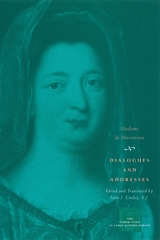 Dialogues and Addresses
Madame de Maintenon
University of Chicago Press, 2004 Born Françoise d'Aubigné, a criminal's daughter reduced to street begging as a child, Madame de Maintenon (1653-1719) made an improbable rise from impoverished beginnings to the summit of power as the second, secret wife of Louis XIV. An educational reformer, Maintenon founded and directed the celebrated academy for aristocratic women at Saint-Cyr. This volume presents the dialogues and addresses in which Maintenon explains her controversial philosophy of education for women.
Denounced by her contemporaries as a political schemer and religious fanatic, Maintenon has long been criticized as an opponent of gender equality. The writings in this volume faithfully reflect Maintenon's respect for social hierarchy and her stoic call for women to accept the duties of their state in life. But the writings also echo Maintenon's more feminist concerns: the need to redefine the virtues in the light of women's experience, the importance of naming the constraints on women's freedom, and the urgent need to remedy the scandalous neglect of the education of women.
In her writings as well as in her own model school at Saint-Cyr, Maintenon embodies the demand for educational reform as the key to the empowerment of women at the dawn of modernity.
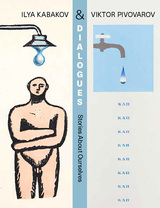 Dialogues: Ilya Kabakov and Viktor Pivovarov, Stories about Ourselves
Ksenia Nouril
Rutgers University Press, 2020 Artists in the Soviet Union faced a difficult choice: either join the official academies and make art that conformed to the state’s aesthetic and ideological dictates, or attempt to develop alternative artistic practices and spheres for exhibiting their work. In the early 1970s, conceptual artists Ilya Kabakov and Viktor Pivovarov chose the latter option, turning their limited resources into an asset by pioneering an entirely new artistic genre: the album. Somewhere between drawings and novels, Kabakov and Pivovarov’s albums were also the basis for unique performance pieces, as the artists invited select audiences to their Moscow apartments for private readings and viewings of the albums, helping to cultivate an alternative artistic community in the process.
This exhibition catalog brings together Kabakov and Pivovarov’s key works for the first time, putting the two artists in dialogue and recreating their artistic community. It not only includes nearly hundred pages of full-color illustrations, but also provides complete English translations of the Russian texts that appear in the volume, plus new interviews with each artist. Taken together, they give viewers a new appreciation of the different aesthetic strategies each artist used to depict the absurdities of everyday life in the Soviet era. Published in partnership with the Zimmerli Museum.
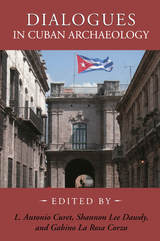 Dialogues in Cuban Archaeology
Edited by L. Antonio Curet, Shannon Lee Dawdy, and Gabino La Rosa Corzo
University of Alabama Press, 2005 Provides a politically and historically informed review of Cuban archaeology, from both American and Cuban perspectives. Many Americans are aware of the political, economic, and personal impacts of the U.S. embargo on Cuba. But the communication blockade between scholars has also affected the historical course of academic disciplines and research in general. With the easing of restrictions in the 1990s, academics are now freer to conduct research in Cuba, and the Cuban government has been more receptive to collaborative projects.
This volume provides a forum for the principal Cuban and American archaeologists to update the current state of Cuban archaeological research--from rock art and potsherds to mortuary practices and historical renovation--thereby filling in the information gap created by the political separation. Each group of researchers brings significant new resources to the effort, including strong conservation regulations, innovative studies of lithic and shell assemblages, and transculturation theories. Cuban research on the hacienda system, slavery, and urban processes has in many ways anticipated developments in North American archaeology by a decade or more. Of special interest are the recent renovation projects in Old Havana that fully integrate the work of historians, architects, and archaeologists--a model project conducted by agreement between the Cuban government and UNESCO.
The selection of papers for this collection is based on a desire to answer pressing research questions of interest for North American Caribbeanists and to present a cross-section of Cuban archaeological work. With this volume, then, the principal players present results of recent collaborations and begin a renewed conversation, a dialogue, that can provide a foundation for future coordinated efforts.
Dialogues in Paradise
Can Xue
Northwestern University Press, 1989 The thirteen stories of Dialogues in Paradise are eloquent in a way the West associates with both the modern and the ancient: the dark oracles of Aeschylus and Sophocles, the paranoid mystery of Kafka, the moving stream of Woolf. The work of Can Xue (a pseudonym of Changsa writer Deng Xiao-hua) renews our consciousness of the long tradition of the irrational in our literature, where dreams and reality constitute one territory, its borders open, the passage back and forth barely discernible. She fuses lyrical purity with the darkest visions of the grotesque and the result is a unique literary experience.
 Dialogues in the Dark: Interpreting “Heavenly Questions” across Two Millennia
Nicholas Morrow Williams
Harvard University Press, 2025 Dialogues in the Dark traces how Chinese readers and scholars since the Han dynasty have variously interpreted the ancient poem “Heavenly Questions” (Tianwen), an enigmatic work attributed to Qu Yuan (fl. ca. 300 BCE). The poem, composed entirely in the form of questions, is an extended inquiry into early Chinese cosmology and history. Over centuries, readers of the poem came to radically different understandings, each providing a unique perspective on its meaning. The poem’s reception history comprises three main stages: first, the commentary compiled by Han scholar Wang Yi (ca. 89–ca. 158); second, the response by Tang poet Liu Zongyuan (773–819); and third, the interpretations developed subsequently by late imperial and modern scholars. Nicholas Morrow Williams analyzes how the poem’s meaning evolved in different time periods and provides three new translations of “Heavenly Questions” to represent the three stages, respectively. The ultimate thesis of this study, inspired by the hermeneutics of Hans-Georg Gadamer, is that this poem is best understood in light of the different interpretations supplied by readers over time in lively dialogues that continue even now.
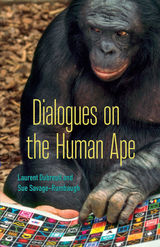 Dialogues on the Human Ape
Laurent Dubreuil
University of Minnesota Press, 2018 A primatologist and a humanist together explore the meaning of being a “human animal” Humanness is typically defined by our capacity for language and abstract thinking. Yet decades of research led by the primatologist Sue Savage-Rumbaugh has shown that chimpanzees and bonobos can acquire human language through signing and technology. Drawing on this research, Dialogues of the Human Ape brings Savage-Rumbaugh into conversation with the philosopher Laurent Dubreuil to explore the theoretical and practical dimensions of what being a “human animal” means. In their use of dialogue as the primary mode of philosophical and scientific inquiry, the authors transcend the rigidity of scientific and humanist discourses, offering a powerful model for the dissemination of speculative hypotheses and open-ended debates grounded in scientific research. Arguing that being human is an epigenetically driven process rather than a fixed characteristic rooted in genetics or culture, this book suggests that while humanness may not be possible in every species, it can emerge in certain supposedly nonhuman species. Moving beyond irrational critiques of ape consciousness that are motivated by arrogant, anthropocentric views, Dialogues on the Human Ape instead takes seriously the continuities between the ape mind and the human mind, addressing why language matters to consciousness, free will, and the formation of the “human animal” self.
Dialogues with Children
Gareth Matthews
Harvard University Press, 1984 Every week for a year, a professional philosopher and eight children at a school in Edinburgh met to craft stories reflecting philosophical problems. The philosopher, Gareth B. Matthews, believes that children are far more able and eager to think abstractly than adults generally recognize. This engaging book has profound implications for education and for our understating of the range of relationships between adults and children. With the example of these dialogues Matthews invites parents, teachers, and all adults to be open to those moments when they can share with children the pleasures of joint philosophical discovery.
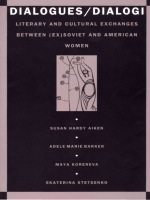 Dialogues/Dialogi: Literary and Cultural Exchanges Between (Ex)Soviet and American Women
Susan Hardy Aiken, Adele Barker, Maya Koreneva, and Ekaterina Stetsenko
Duke University Press, 1993 Co-authored by Russian, Ukrainian, and American critics, Dialogues/Dialogi is the first fully collaborative and comparative study of American and (ex)Soviet women writers. Truly a dialogue, the book juxtaposes fiction by American and Soviet women from the 1960s to the present to reveal their similarities and differences and to show how questions of gender, race, and ethnicity are enacted in the societies and psyches each text represents. Begun in the early days of glasnost and completed in 1992, the book conveys the spirit and excitement of an unprecedented critical conversation conducted during a time of historic transformation.
Dialogues/Dialogi pairs stories by Tillie Olsen, Toni Cade Bambara, Jayne Anne Phillips, and Leslie Marmon Silko (reprinted here in full) with Russian stories by I. Grekova, Liudmila Petrushevskaya, Elena Makarova, and Anna Nerkagi, many of them appearing here for the first time in English. Exquisite in their stylistic and thematic variety, suggestive of the range of women's experience and fiction in both countries, each story is the subject of paired interpretive essays by an American and an (ex)Soviet critic from among the book's authors.
A colloquy of diverse voices speaking together in multiple, mutually illuminating exchanges, Dialogues/Dialogi testifies to the possibility of evolving relationships among women across borders once considered impassable.
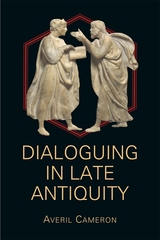 Dialoguing in Late Antiquity
Averil Cameron
Harvard University Press Christians talked, debated, and wrote dialogues in late antiquity and on throughout Byzantium. Some were philosophical, others more literary, theological, or Platonic; Aristotle also came into the picture as time went on. Sometimes the written works claim to be records of actual public debates, and we know that many such debates did take place and continued to do so. Dialoguing in Late Antiquity takes up a challenge laid down by recent scholars who argue that a wall of silence came down in the fifth century AD, after which Christians did not “dialogue.”
Averil Cameron now returns to questions raised in her book Christianity and the Rhetoric of Empire (1991), drawing on the large repertoire of surviving Christian dialogue texts from late antiquity to make a forceful case for their centrality in Greek literature from the second century and the Second Sophistic onward. At the same time, Dialoguing in Late Antiquity points forward to the long and neglected history of dialogue in Byzantium. Throughout this study, Cameron engages with current literary approaches and is a powerful advocate for the greater integration of Christian texts by literary scholars and historians alike.
 Diamond and Juba: The Raucous World of 19th-Century Challenge Dancing
April F. Masten
University of Illinois Press, 2025 During the tumultuous years before the Civil War, Irish American John Diamond and African American William Henry Lane, known as Juba, became internationally famous as competitors in the art and sport of challenge dancing. April F. Masten’s dual biography reconstructs the lives and work of these extraordinary dancers, casting fresh light on their contributions to the history of American popular culture. Challenge dancing was born from Black-Irish social interaction in the dockside markets, taverns, and theaters of antebellum New York. Promoted as a masculine art with close ties to boxing, it featured prolific gambling, hefty purses, and championship belts, yet also included women competitors, cross-dressing, and blackface. The astonishing jigs of its foremost practitioners attracted huge audiences across northeastern port cities, along Mississippi Valley circus routes, and into England’s provincial music halls. Diamond and Juba’s rivalry and parallel careers provide a rare glimpse into Black and immigrant strivings in an expanding nation keen for talent yet divided by prejudice. A vivid portrait of a forgotten world, Diamond and Juba tells the intertwined stories of two legendary performers.
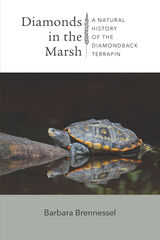 Diamonds in the Marsh: A Natural History of the Diamondback Terrapin
Barbara Brennessel
Brandeis University Press, 2021 A new edition of a classic on a beloved turtle species.
She’s the mascot for the University of Maryland’s sports teams and her ancestors were nearly driven to extinction by Victorians who indulged in turtle soup. But as she buries herself in the mud every night to sleep, the diamondback terrapin knows none of this. The size of a dinner plate and named for the beautiful concentric rings on her shell, she can live at least forty years and is the only turtle in North America who can live in brackish and salty waters. Several diamondback populations have been the subjects of ecological studies in recent years, but most of that information was buried in scientific literature and various state and federal reports—until this book.
Synthesizing all known research on this remarkable animal, Diamonds in the Marsh is the first full-scale natural history of the diamondback terrapin. Focusing on the northern diamondback, Barbara Brennessel examines its evolution, physiology, adaptations, behavior, growth patterns, life span, genetic diversity, land use, reproduction, and early years. She also discusses its relationship to humans, first as an important food source from colonial times through the nineteenth century, and more recently as a cultural icon, frequently depicted in Native American art and design. She concludes with a look at contemporary hazards to the terrapin and urges continued study of this marvelous creature. Updated with a new introduction by Brennessel, and with a foreword by Bob Prescott, former executive director of Massachusett’s Audubon Wellfleet Bay Sanctuary, Diamonds of the Marsh is perfect for those interested in the conservation of a species.
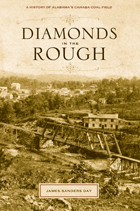 Diamonds in the Rough: A History of Alabama's Cahaba Coal Field
James Sanders Day
University of Alabama Press, 2013 Diamonds in the Rough reconstructs the historical moment that defined the Cahaba Coal Field, a mineral-rich area that stretches across sixty-seven miles and four counties of central Alabama. Combining existing written sources with oral accounts and personal recollections, James Sanders Day’s Diamonds in the Rough describes the numerous coal operations in this region—later overshadowed by the rise of the Birmingham district and the larger Warrior Field to the north. Many of the capitalists are the same: Truman H. Aldrich, Henry F. DeBardeleben, and James W. Sloss, among others; however, the plethora of small independent enterprises, properties of the coal itself, and technological considerations distinguish the Cahaba from other Alabama coal fields. Relatively short-lived, the Cahaba coal-mining operation spanned from discovery in the 1840s through development, boom, and finally bust in the mid-1950s. Day considers the chronological discovery, mapping, mining, and marketing of the field’s coal as well as the issues of convict leasing, town development, welfare capitalism, and unionism, weaving it all into a rich tapestry. At the heart of the story are the diverse people who lived and worked in the district—whether operator or miner, management or labor, union or nonunion, white or black, immigrant or native—who left a legacy for posterity now captured in Diamonds in the Rough. Largely obscured today by pine trees and kudzu, the mining districts of the Cahaba Coal Field forever influenced the lives of countless individuals and families, and ultimately contributed to the whole fabric of the state of Alabama. Winner of the 2014 Clinton Jackson Coley Award for Best Work on Alabama Local History from the Alabama Historical Association
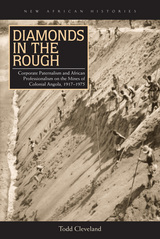 Diamonds in the Rough: Corporate Paternalism and African Professionalism on the Mines of Colonial Angola, 1917–1975
Todd Cleveland
Ohio University Press, 2015 Diamonds in the Rough explores the lives of African laborers on Angola’s diamond mines from the commencement of operations in 1917 to the colony’s independence from Portugal in 1975. The mines were owned and operated by the Diamond Company of Angola, or Diamang, which enjoyed exclusive mining and labor concessions granted by the colonial government. Through these monopolies, the company became the most profitable enterprise in Portugal’s African empire. After a tumultuous initial period, the company’s mines and mining encampments experienced a remarkable degree of stability, in striking contrast to the labor unrest and ethnic conflicts that flared in other regions. Even during the Angolan war for independence (1961–75), Diamang’s zone of influence remained comparatively untroubled. Todd Cleveland explains that this unparalleled level of quietude was a product of three factors: African workers’ high levels of social and occupational commitment, or “professionalism”; the extreme isolation of the mining installations; and efforts by Diamang to attract and retain scarce laborers through a calculated paternalism. The company’s offer of decent accommodations and recreational activities, as well as the presence of women and children, induced reciprocal behavior on the part of the miners, a professionalism that pervaded both the social and the workplace environments. This disparity between the harshness of the colonial labor regime elsewhere and the relatively agreeable conditions and attendant professionalism of employees at Diamang opens up new ways of thinking about how Africans in colonial contexts engaged with forced labor, mining capital, and ultimately, each other.
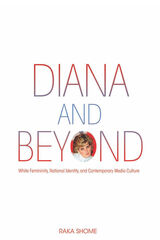 Diana and Beyond: White Femininity, National Identity, and Contemporary Media Culture
Raka Shome
University of Illinois Press, 2014 The death of Princess Diana unleashed an international outpouring of grief, love, and press attention virtually unprecedented in history. Yet the exhaustive effort to link an upper class white British woman with "the people" raises questions. What narrative of white femininity transformed Diana into a simultaneous signifier of a national and global popular? What ideologies did the narrative tap into to transform her into an idealized woman of the millennium? Why would a similar idealization not have appeared around a non-white, non-Western, or immigrant woman?
Raka Shome investigates the factors that led to this defining cultural/political moment and unravels just what the Diana phenomenon represented for comprehending the relation between white femininity and the nation in postcolonial Britain and its connection to other white female celebrity figures in the millennium. Digging into the media and cultural artifacts that circulated in the wake of Diana's death, Shome investigates a range of theoretical issues surrounding motherhood and the production of national masculinities, global humanitarianism, transnational masculinities, the intersection of fashion and white femininity, and spirituality and national modernity. Her analysis explores how images of white femininity in popular culture intersect with issues of race, gender, class, sexuality, and transnationality in the performance of Anglo national modernities.
Moving from ideas on the positioning of privileged white women in global neoliberalism to the emergence of new formations of white femininity in the millennium , Diana and Beyond fearlessly explains the late princess's never-ending renaissance and ongoing cultural relevance.
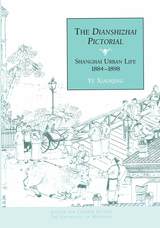 The Dianshizhai Pictorial: Shanghai Urban Life, 1884–1898
Ye Xiaoqing
University of Michigan Press, 2003 While twentieth-century Shanghai has received extensive scholarly treatment, the nineteenth century has remained understudied, even though it encompasses the first half-century of Shanghai's growth as a treaty port and the early years of Chinese-foreign contact. Published in the last quarter of the nineteenth century, the Dianshizhai Pictorial provides a record of the new urban popular culture that emerged in Shanghai's foreign settlements during this period. In this study, Ye Xiaoqing provides a comprehensive view into the Dianshizhai's detailed illustrations of everyday life at home, in commercial establishments, and in Shanghai's public areas. Her introduction to more than one hundred drawings points to the social background, lifestyle, and intellectual outlook of the Dianshizhai's literati writers and artists, the weakness of gentry control in the foreign settlements, and the commercialization and “modern” material culture that made Shanghai distinctive. The drawings and commentaries of the Dianshizhai contrast the settlements with “traditional” culture and urban life in the adjacent Chinese city and vividly convey items of interest—from the quotidian to the bizarre—highlighting local fascination with and anxiety at the rapid changes in Shanghai's increasingly cosmopolitan society.
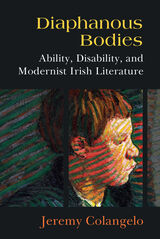 Diaphanous Bodies: Ability, Disability, and Modernist Irish Literature
Jeremy Colangelo
University of Michigan Press, 2021 Diaphanous Bodies: Ability, Disability, and Modernist Irish Literature examines ability, as a category of embodiment and embodied experience, and in the process opens up a new area of inquiry in the growing field of literary disability studies. It argues that the construction of ability arises through a process of exclusion and forgetting, in which the depiction of sensory information and epistemological judgment subtly (or sometimes un-subtly) elide the fact of embodied subjectivity. The result is what Colangelo calls “the myth of the diaphanous abled body,” a fiction that holds that an abled body is one which does not participate in or situate experience. The diaphanous abled body underwrites the myth that abled and disabled constitute two distinct categories of being rather than points on a constantly shifting continuum. In any system of marginalization, the dominant identity always sets itself up as epistemologically and experientially superior to whichever group it separates itself from. Indeed, the norm is always most powerful when it is understood as an empty category or a view from nowhere. Diaphanous Bodies explores the phantom body that underwrites the artificial dichotomy between abled and disabled upon which the representation of embodied experience depends.
 The Diaries of Carol Lynn Pearson—Mormon Author, Feminist, and Activist: Volume 1: 1956–1990
Pearson, Carol Lynn
Signature Books, 2025 “I feel somehow that of all the writing I am doing, my diary is the most important.” So wrote the beloved and bestselling author, poet, and playwright Carol Lynn Pearson in her 1979 diary. Several years before, she recorded, “I feel the imperative of history. . . . Add that to my being a household word to many and I cannot escape the feeling that in many years there might be a number of people interested in these pages.” That time has now come. Unbeknownst to almost everyone but herself, Pearson kept a near-daily diary since she was a teenager, recording her remarkable story in the context of twentieth- and twenty-first-century Mormon America. In this first of a four-volume series, Pearson chronicles her love for her church but also her troubling experiences and concerns with its patriarchy, historic doctrine of polygamy, omission of a feminine divine, and homophobia. Readers will rejoice with her as her first book of poetry, Beginnings, sells an astonishing 150,000+ copies and puts her on the map in the 1960s, empathize with her as she watches her church help kill the Equal Rights Amendment in the 1970s, and mourn with her as her mixed-orientation marriage ends and she cares for her former husband in her home as he dies of AIDS in the 1980s. The sensitive-girl-turned-strong-woman who emerges in these diaries insists that we move from patriarchy into partnership, change our destructive policies towards Queer people, and invite God the Mother back into our heavenly family.
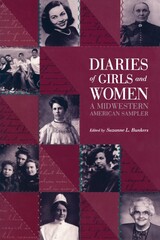 Diaries of Girls and Women: A Midwestern American Sampler
Suzanne L. Bunkers
University of Wisconsin Press, 2001 Diaries of Girls and Women captures and preserves the diverse lives of forty-seven girls and women who lived in Minnesota, Iowa, and Wisconsin between 1837 and 1999—young schoolgirls, adolescents coming of age, newlywed wives, mothers grieving the loss of children, teachers, nurses, elderly women, Luxembourger immigrant nuns, and women traveling abroad. A compelling work of living history, it brings together both diaries from historical society archives and diaries still in possession of the diarists or their descendents.
Editor Suzanne L. Bunkers has selected these excerpts from more than 450 diaries she examined. Some diaries were kept only briefly, others through an entire lifetime; some diaries are the intensely private record of a life, others tell the story of an entire family and were meant to be saved and appreciated by future generations. By approaching diaries as historical documents, therapeutic tools, and a form of literature, Bunkers offers readers insight into the self-images of girls and women, the dynamics of families and communities, and the kinds of contributions that girls and women have made, past and present. As a representation of the girls and women of varied historical eras, locales, races, and economic circumstances who settled and populated the Midwest, Diaries of Girls and Women adds texture and pattern to the fabric of American history.
|
|

